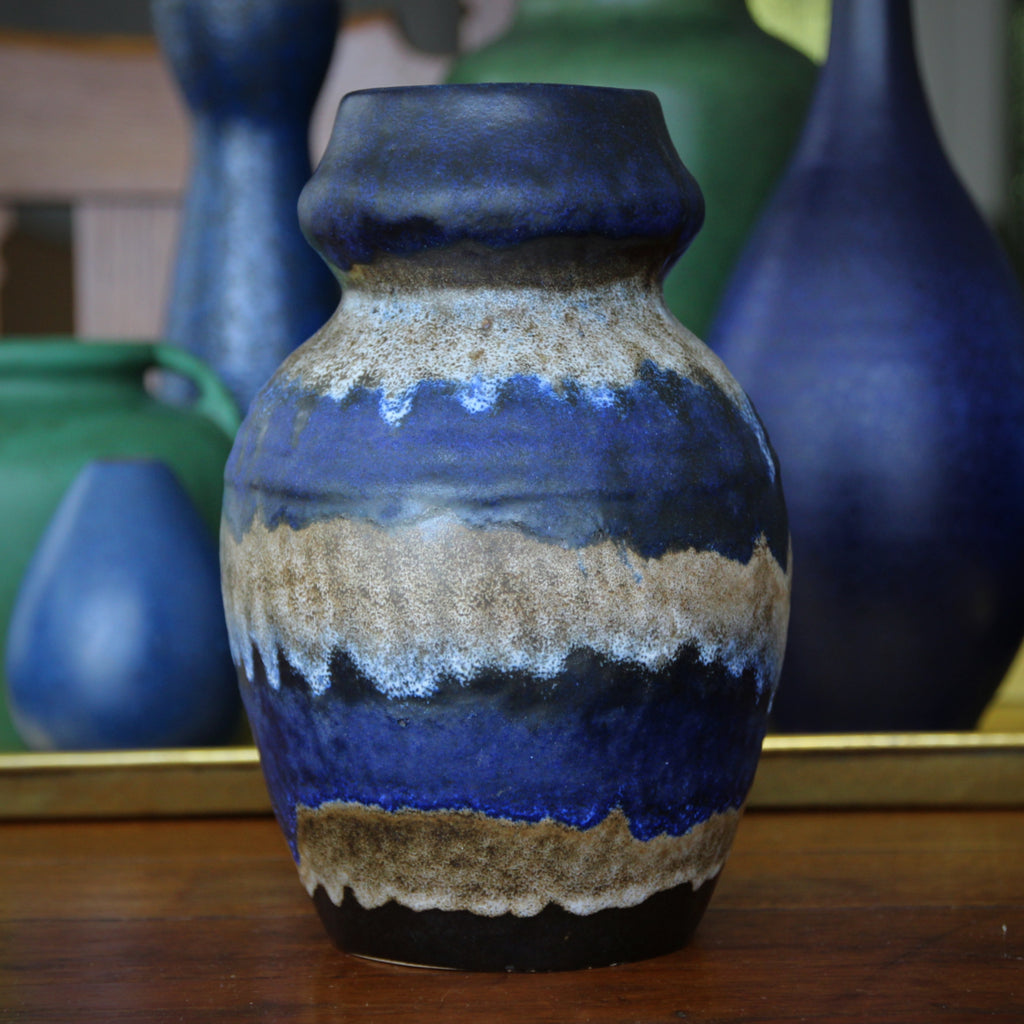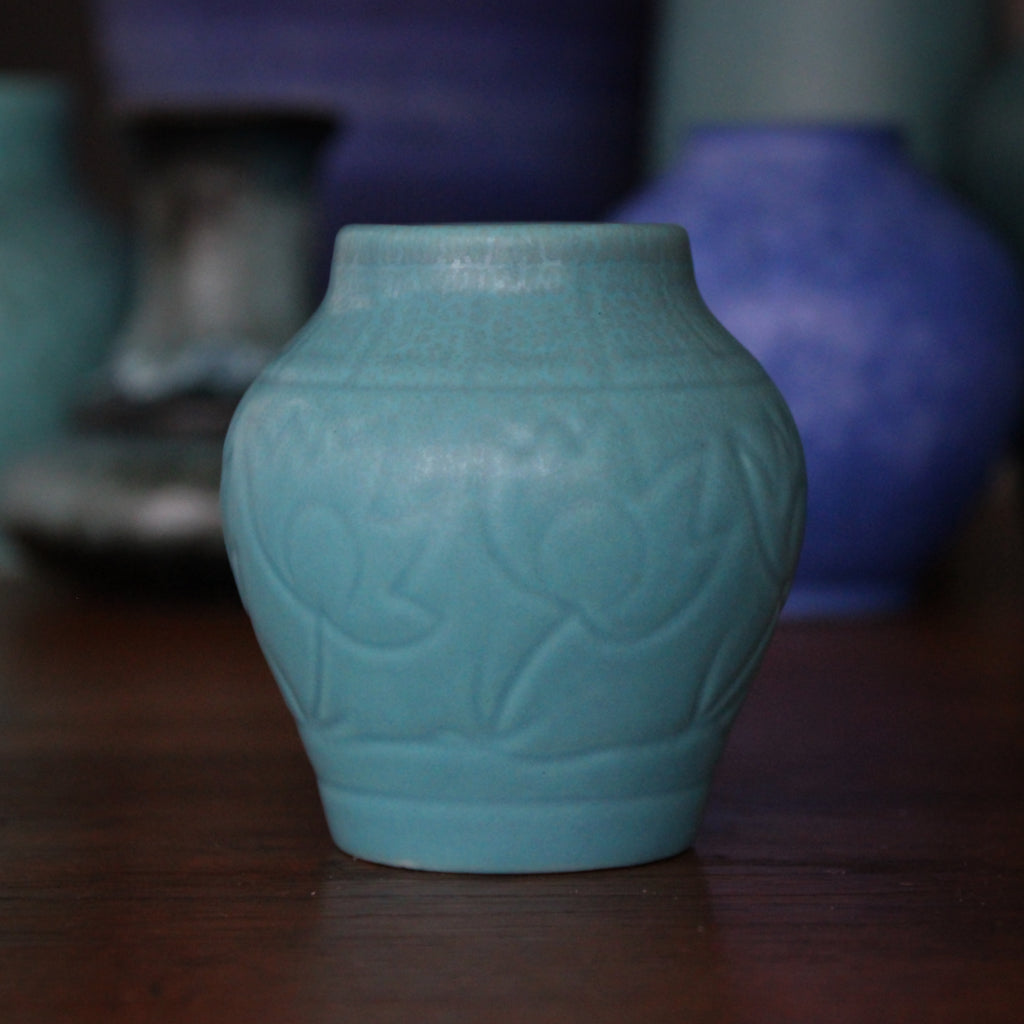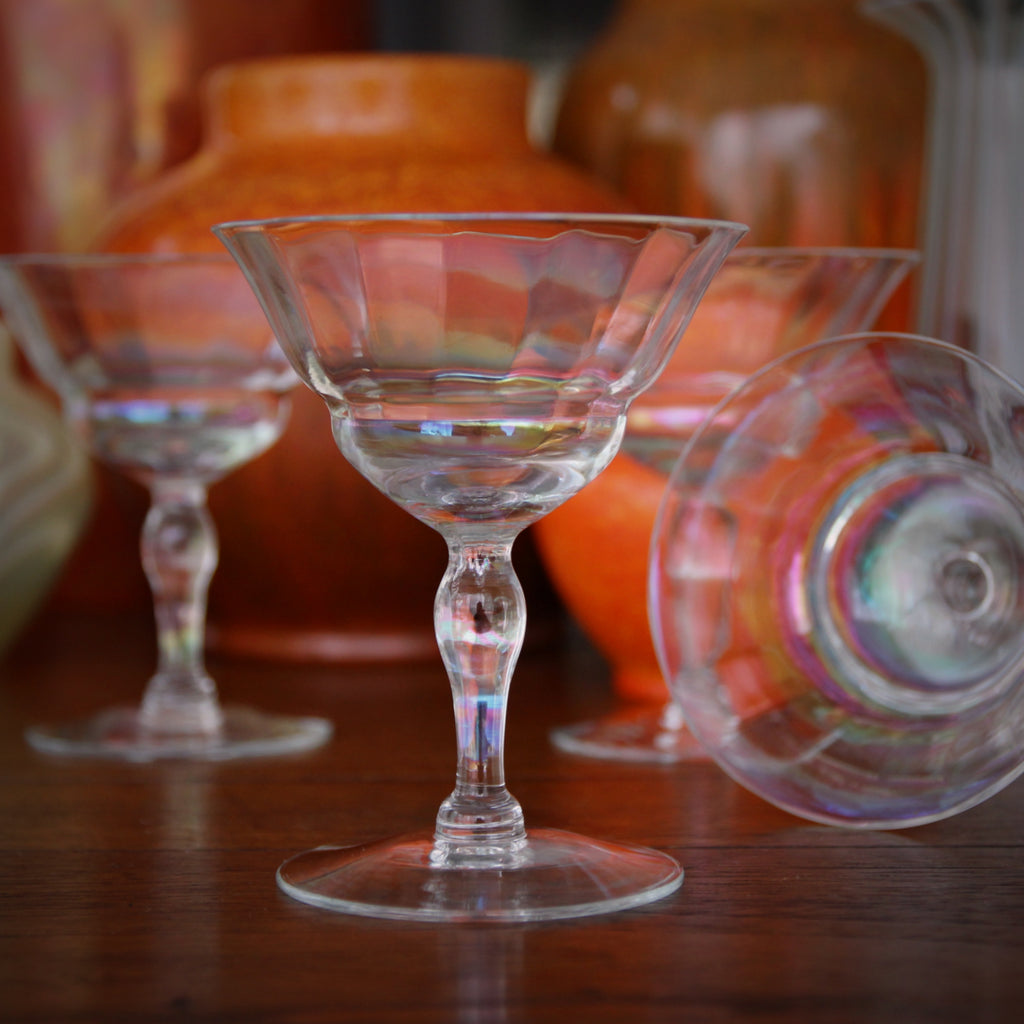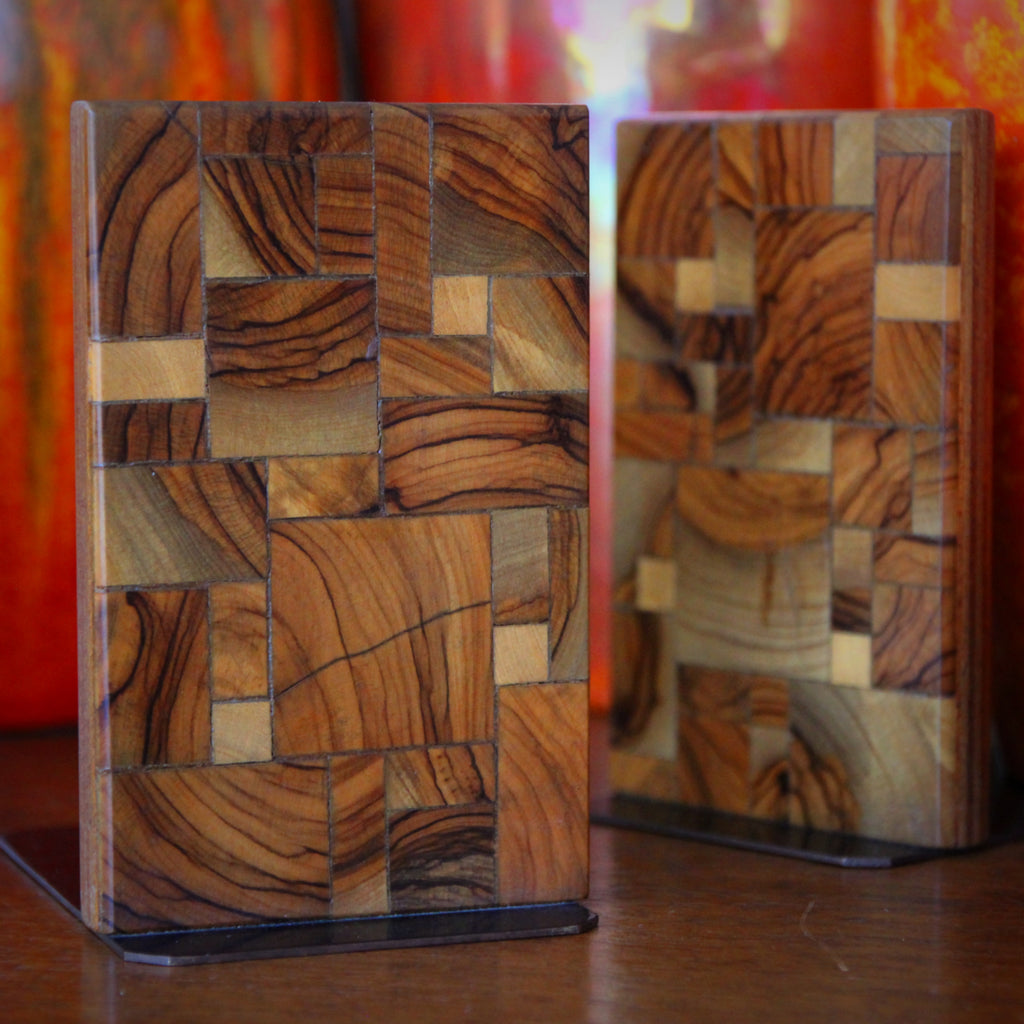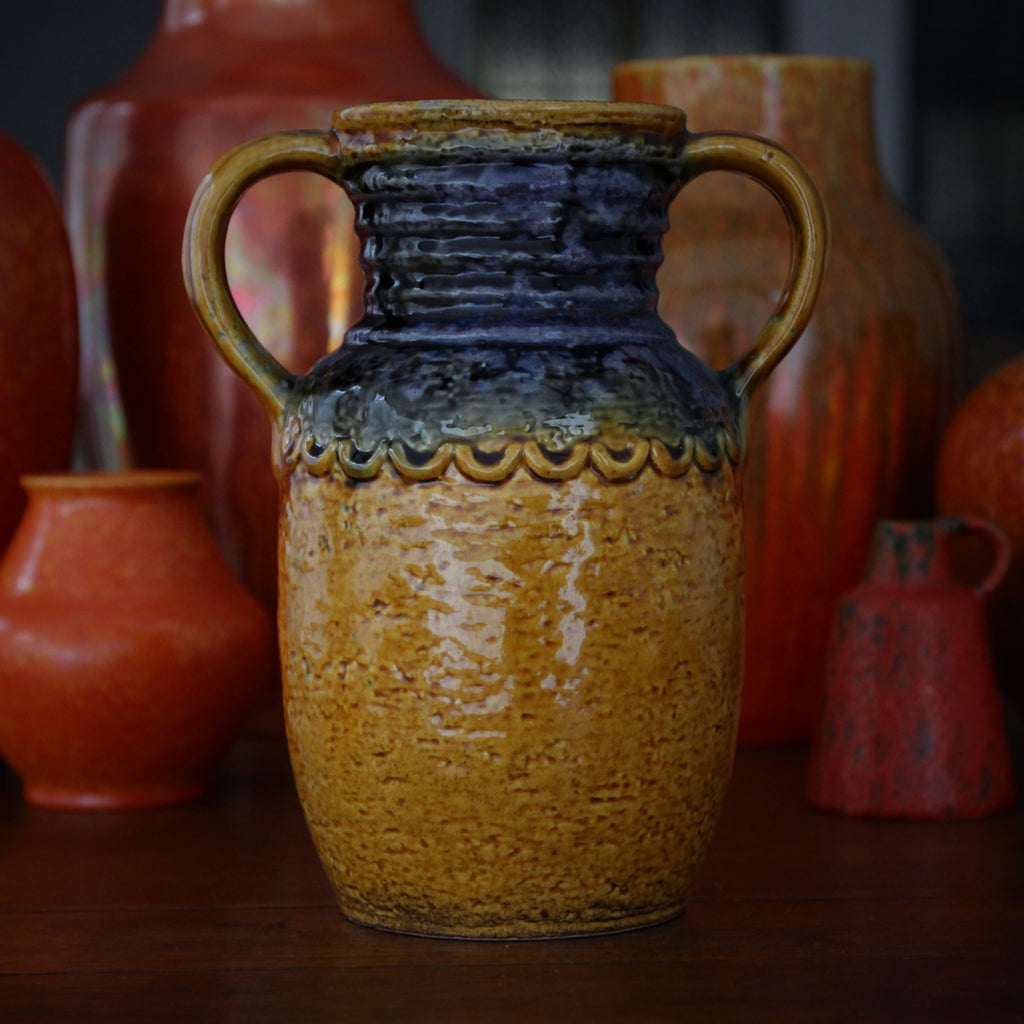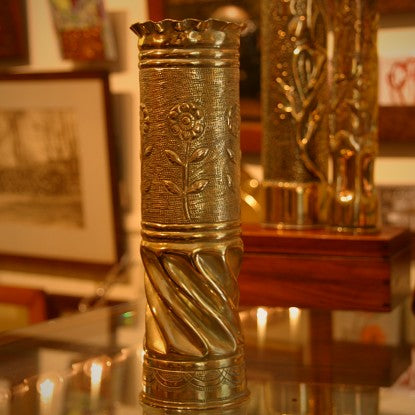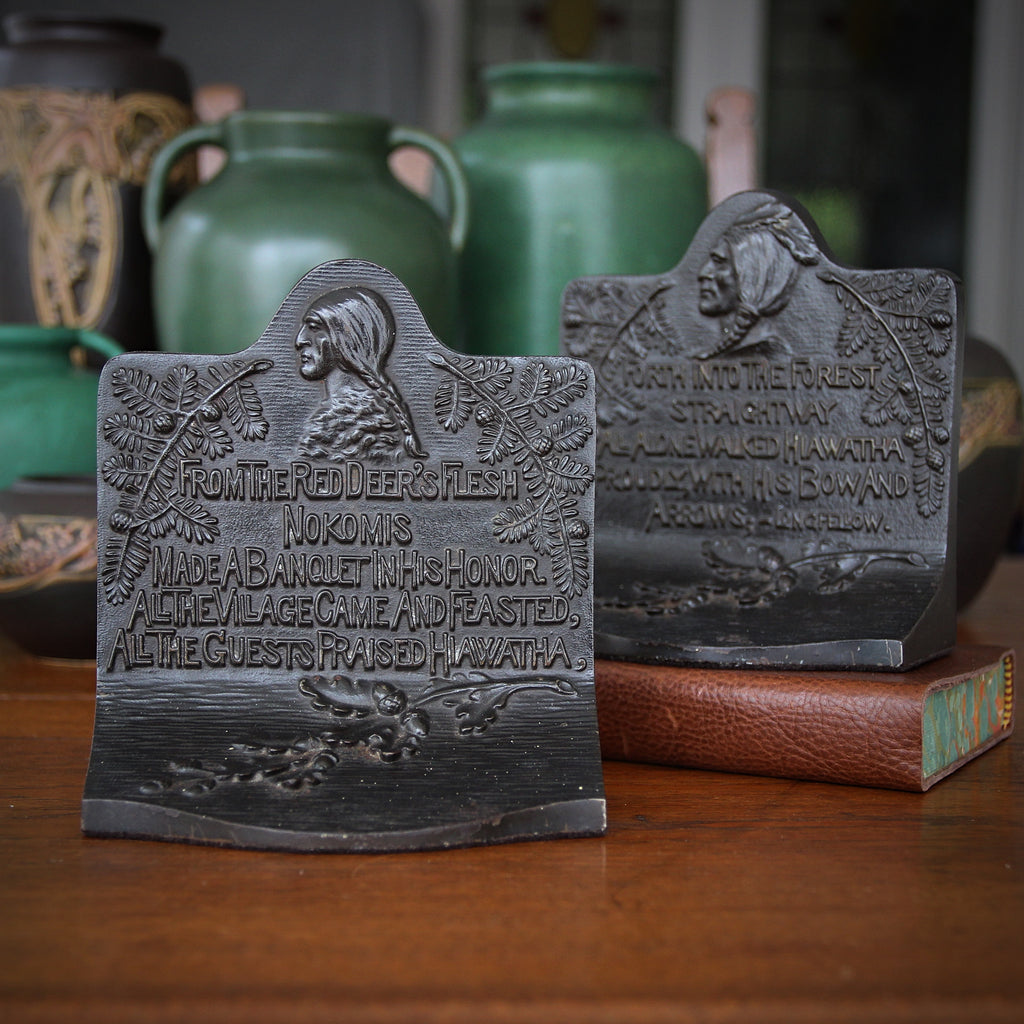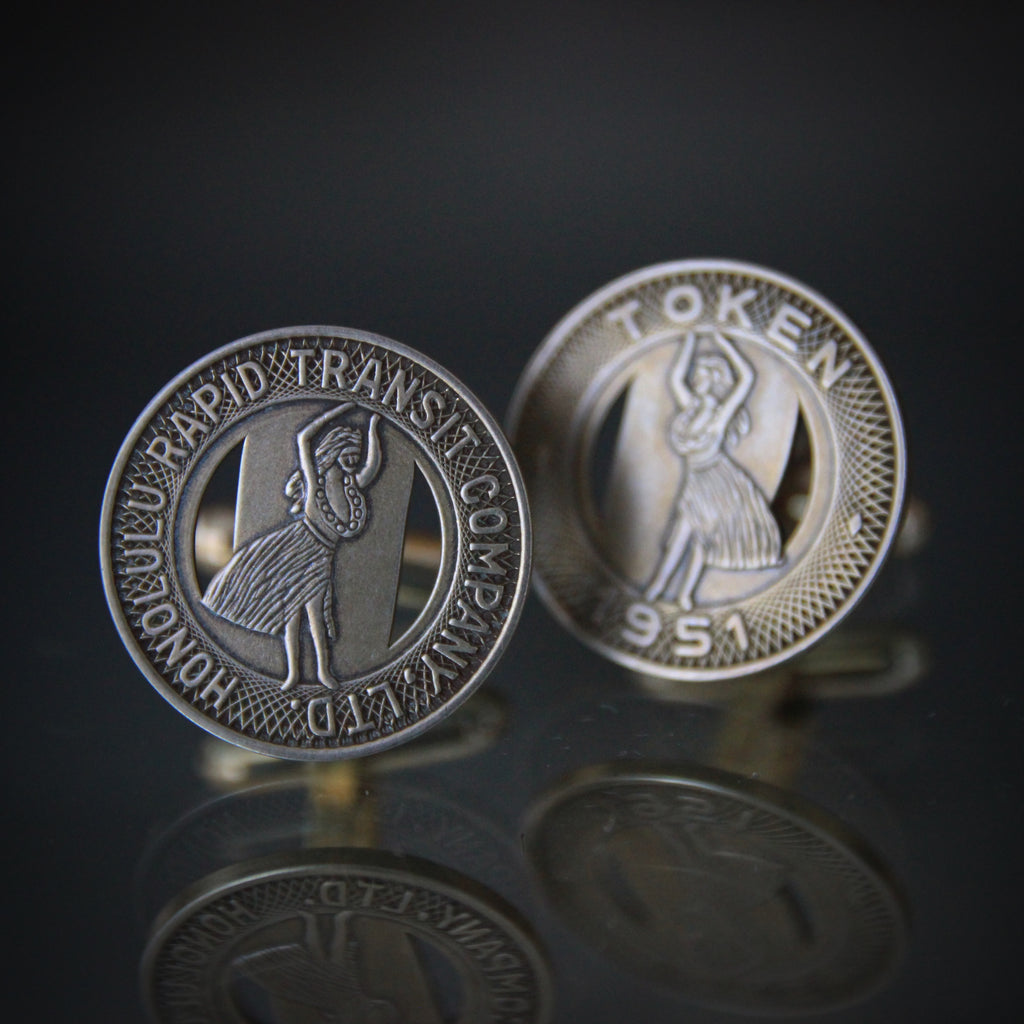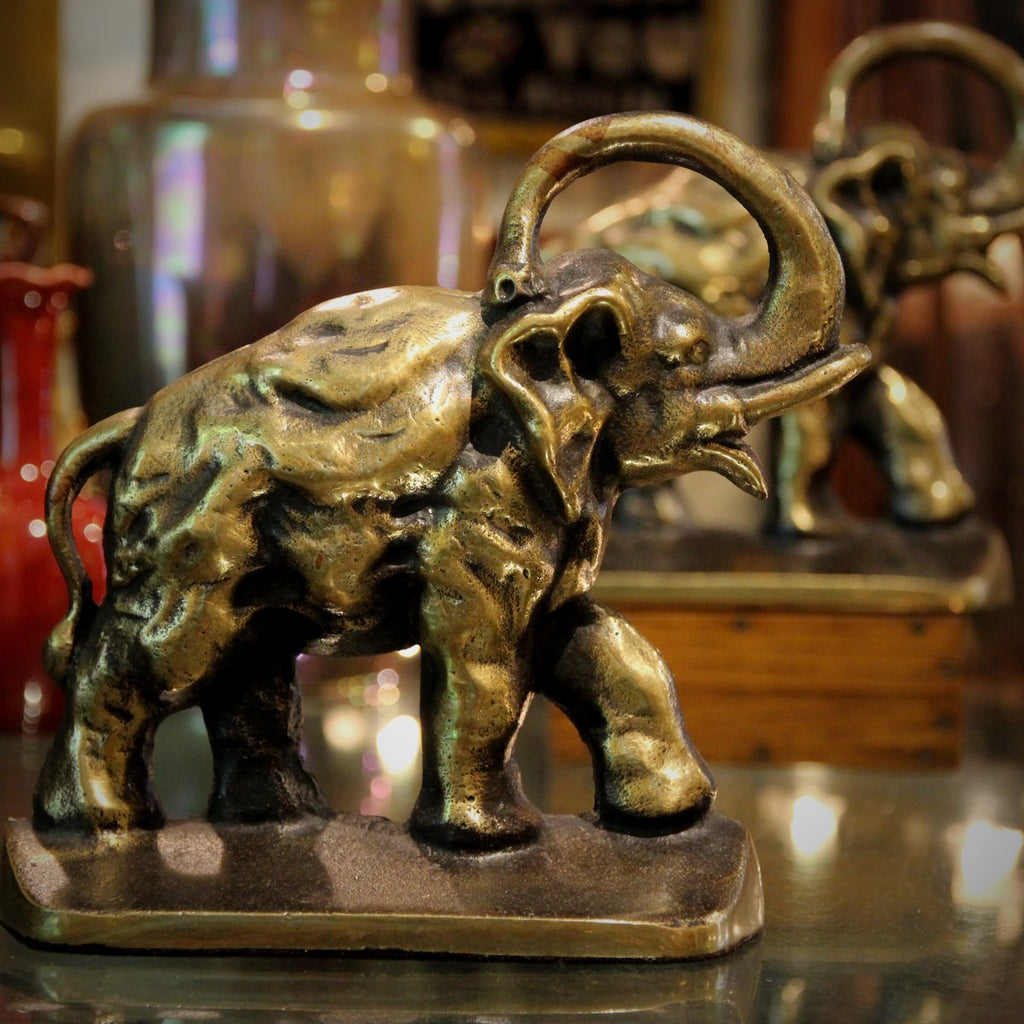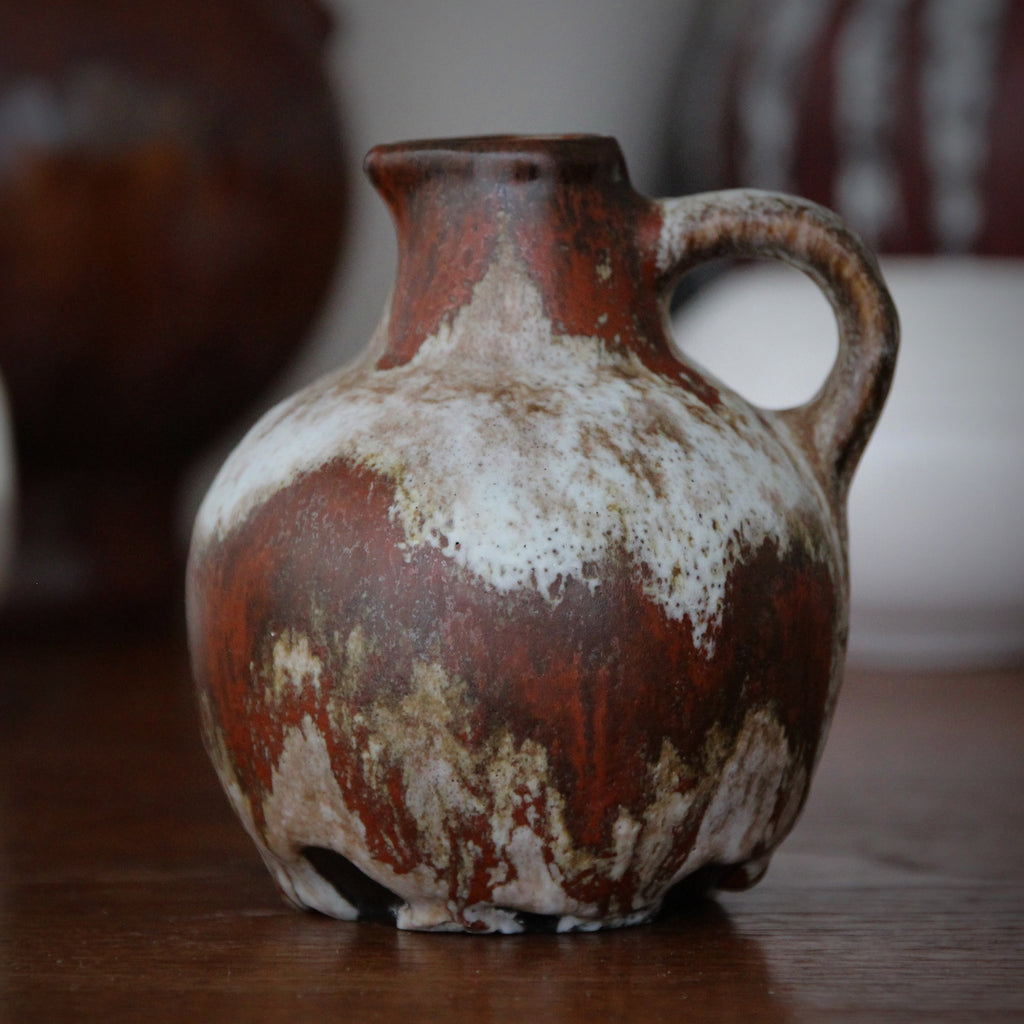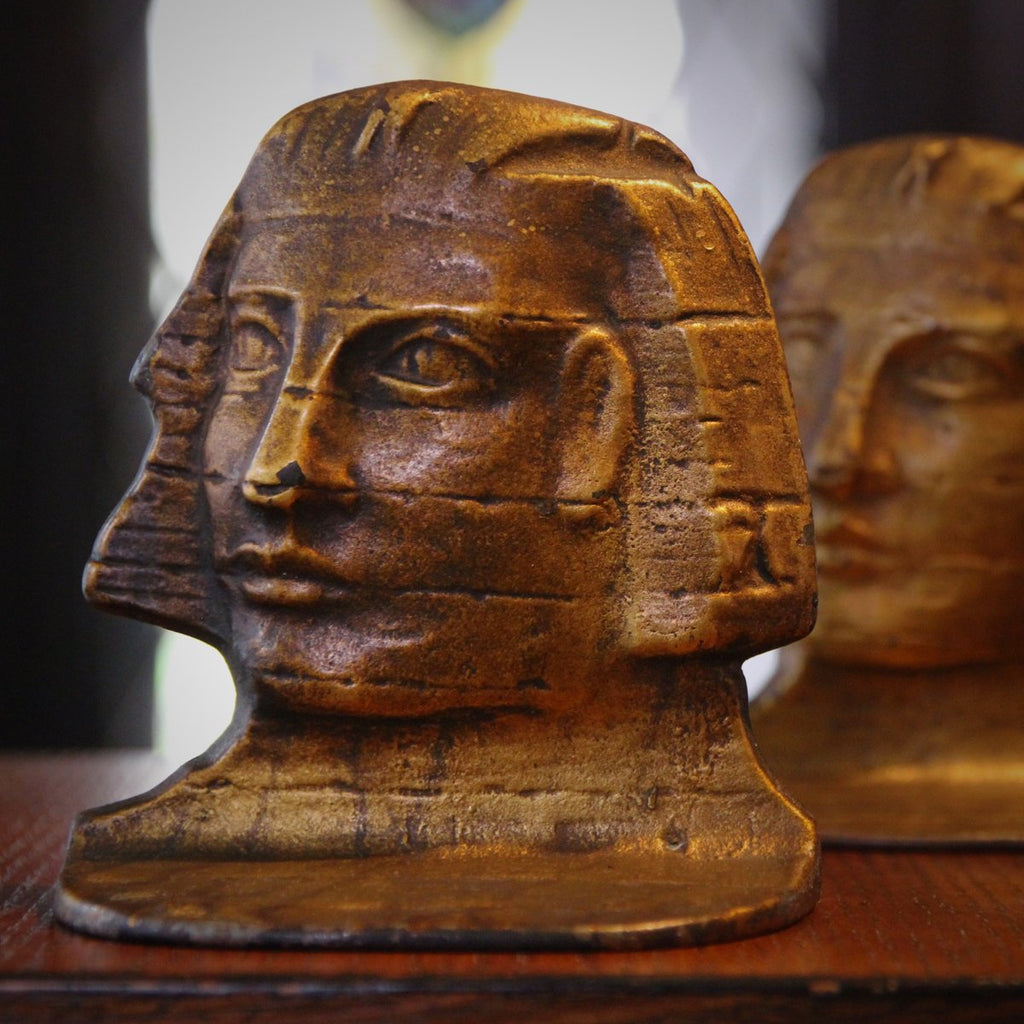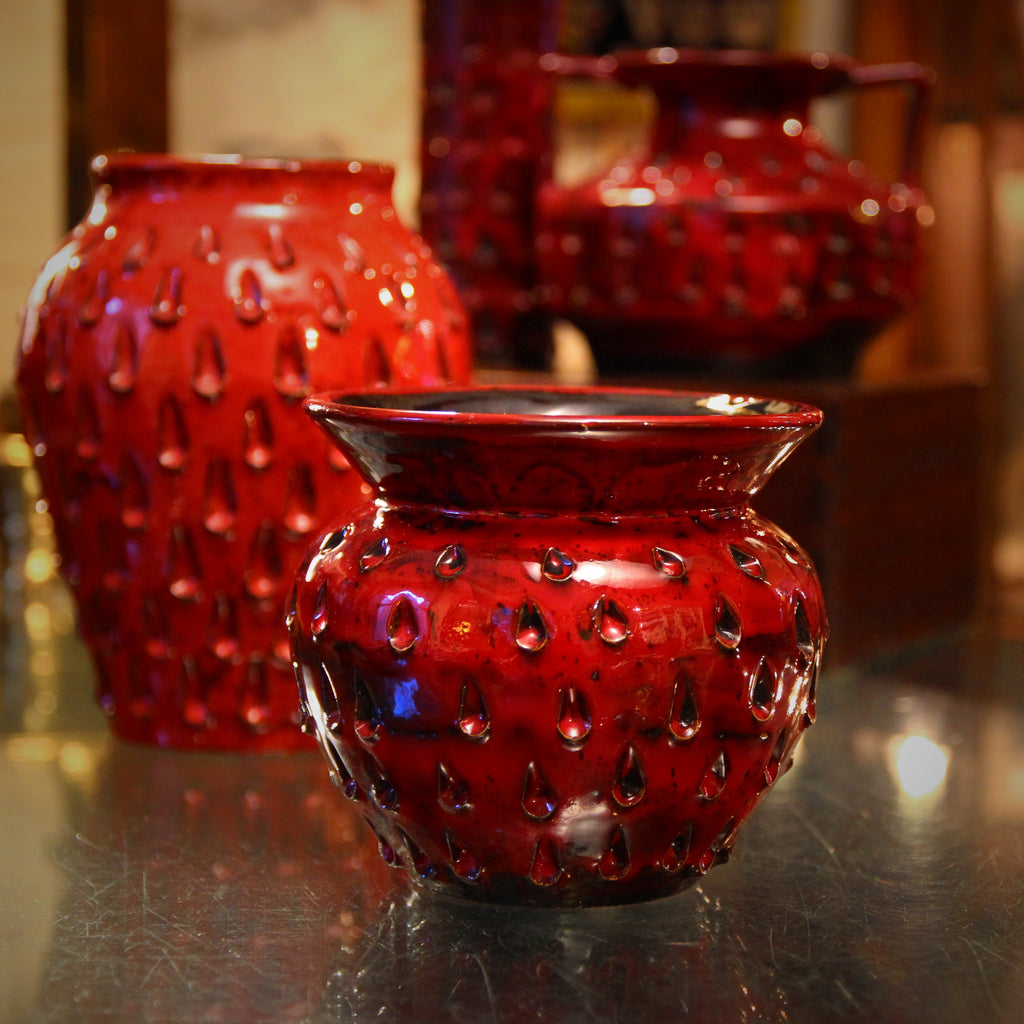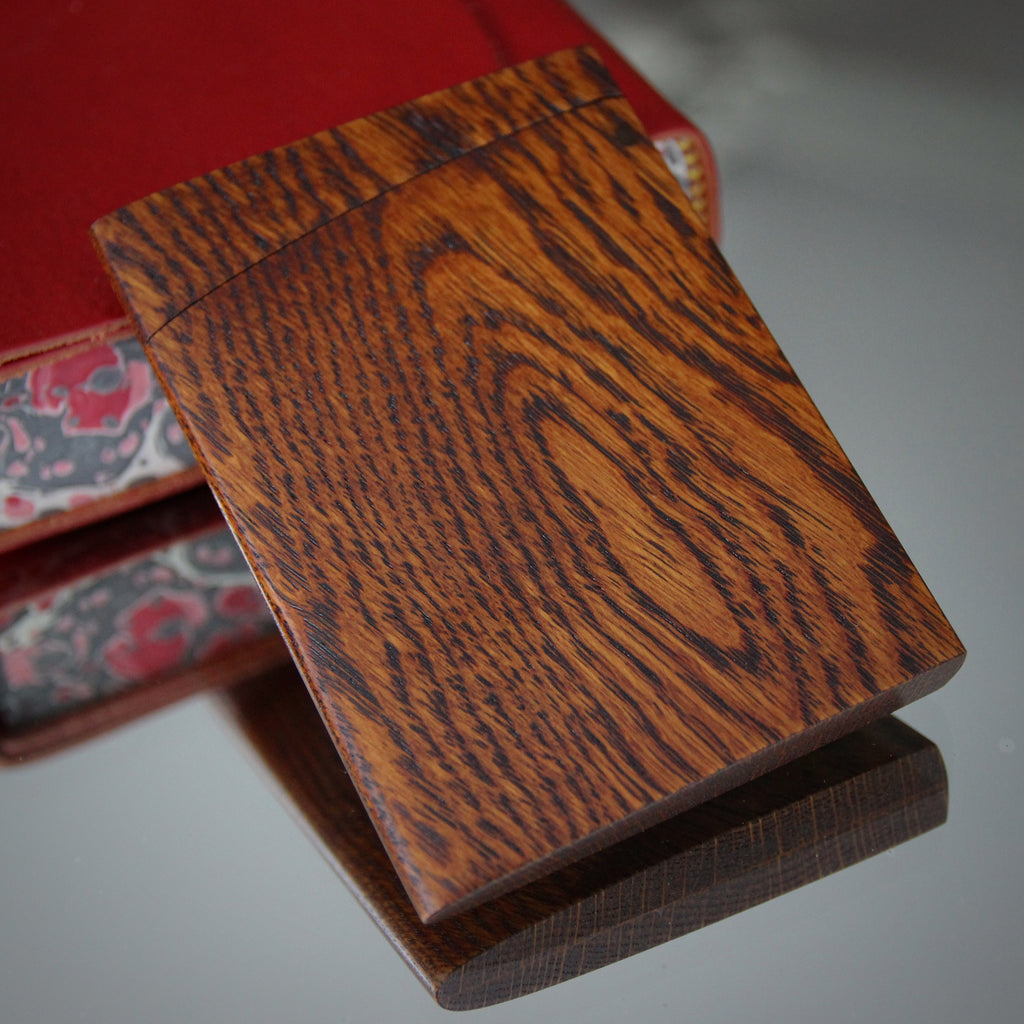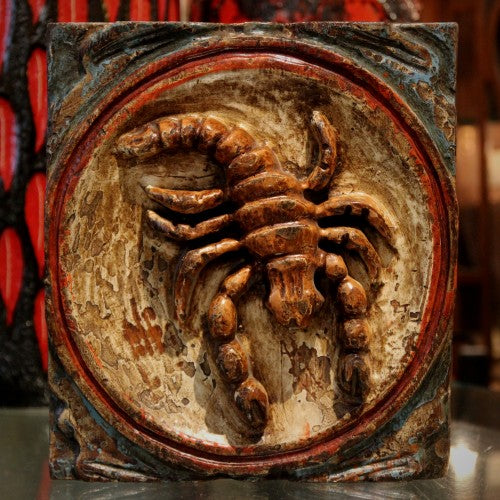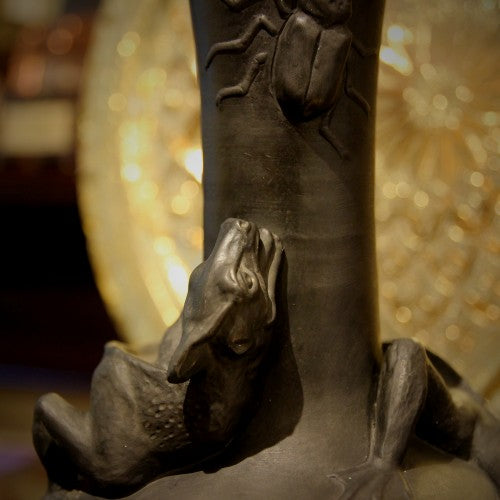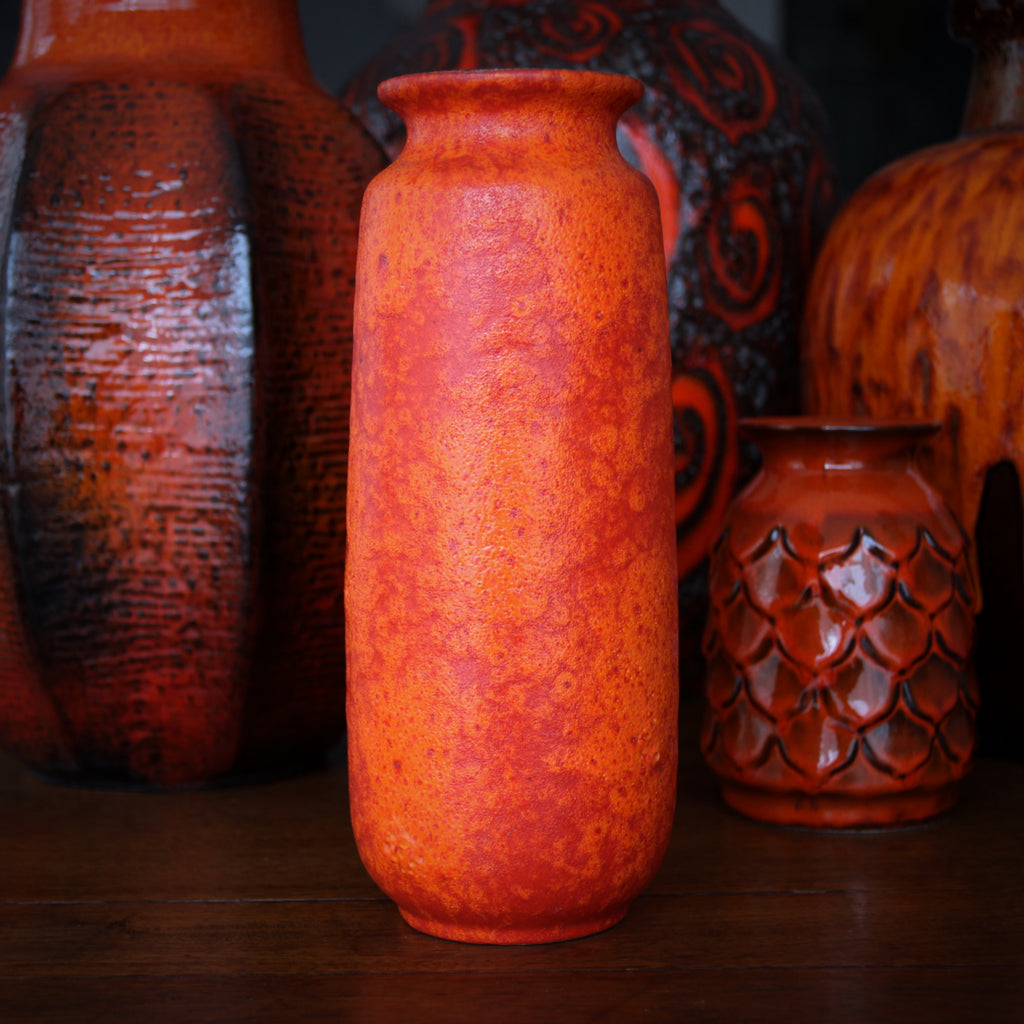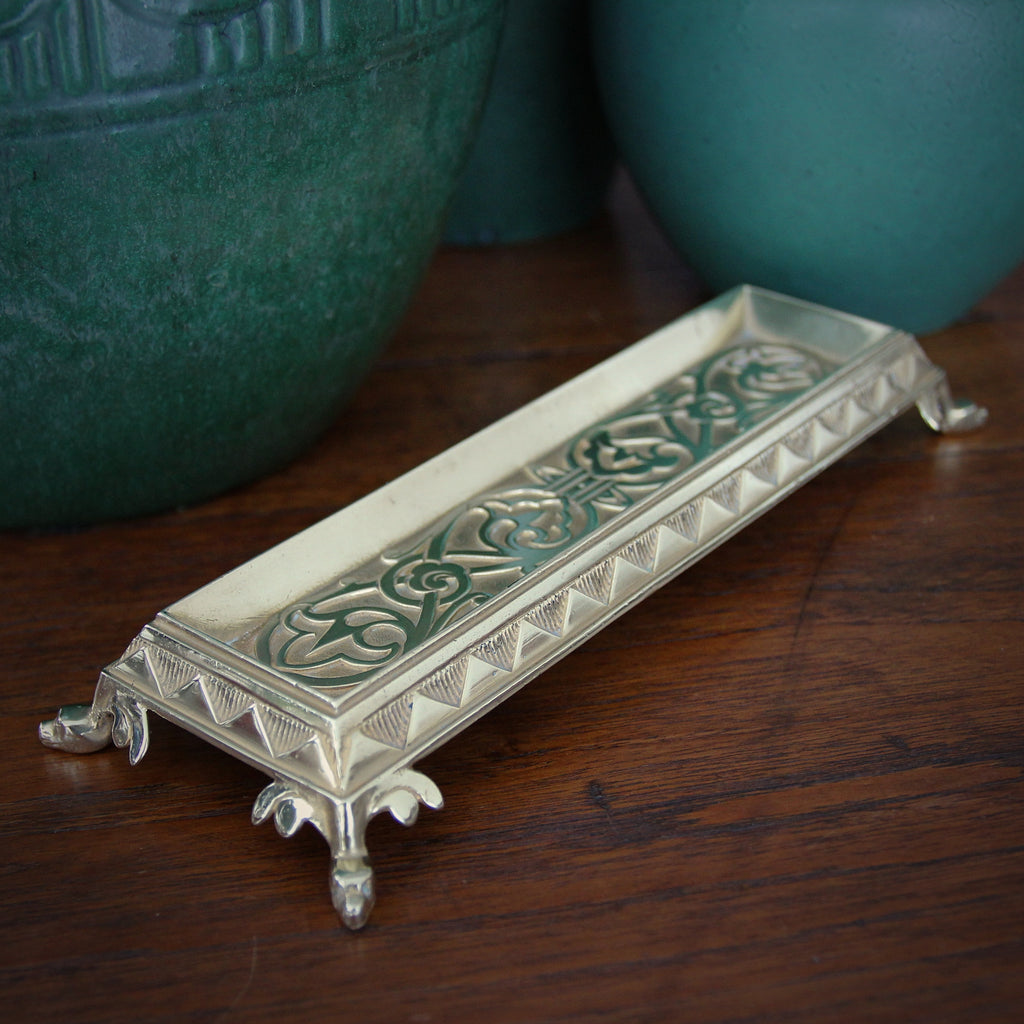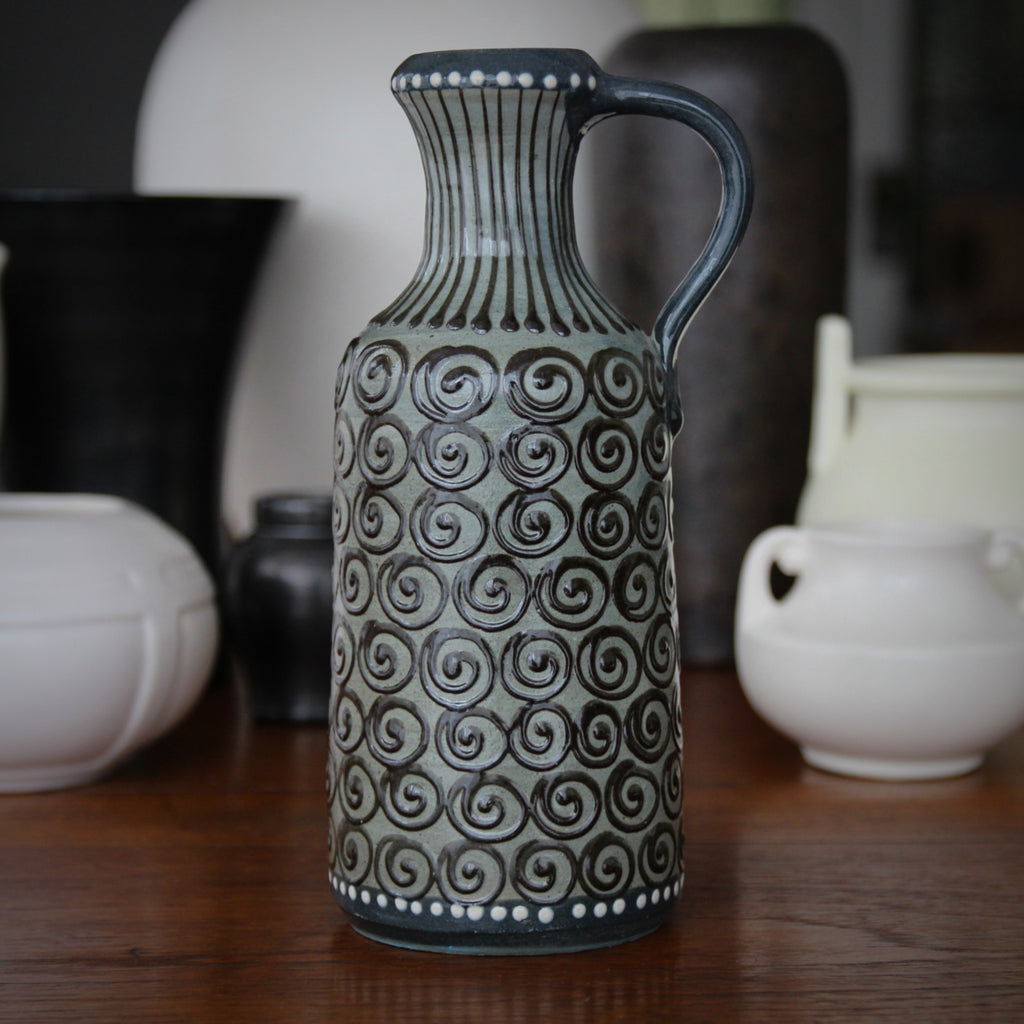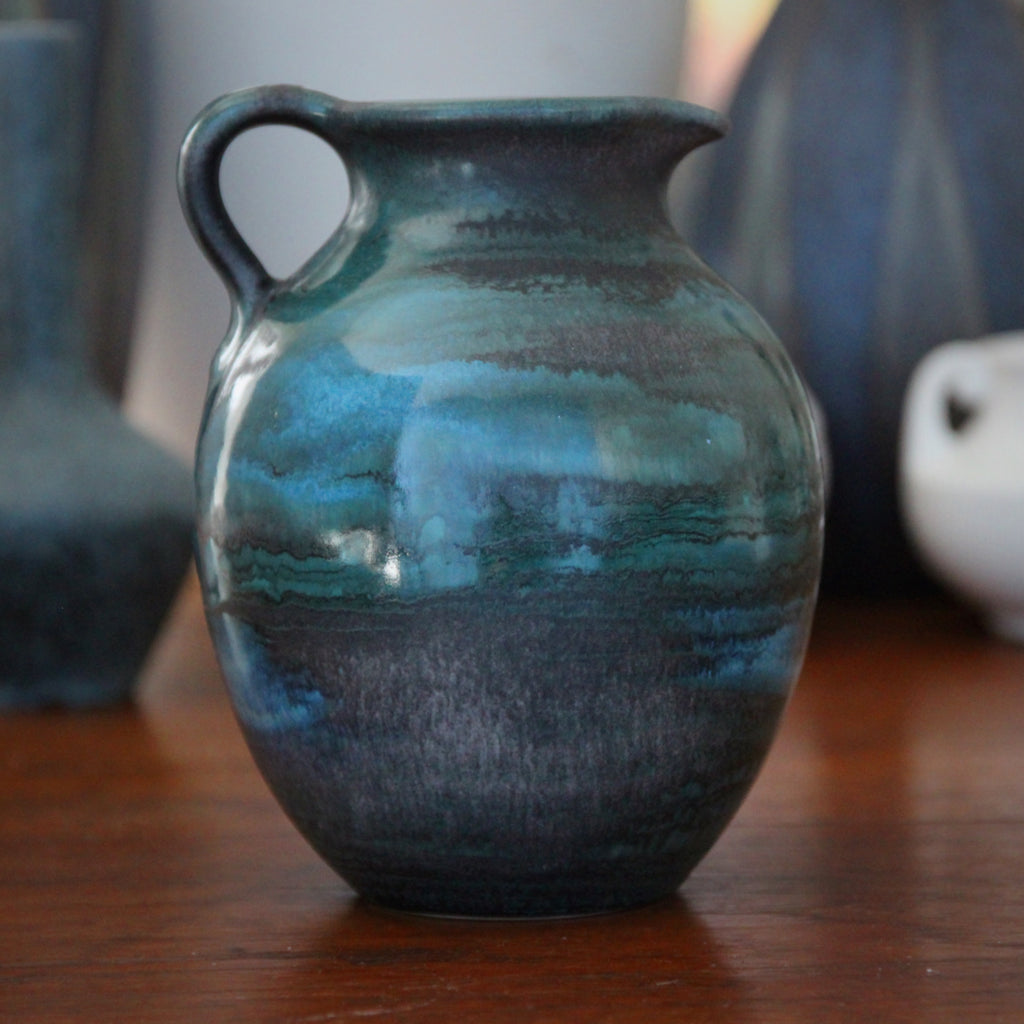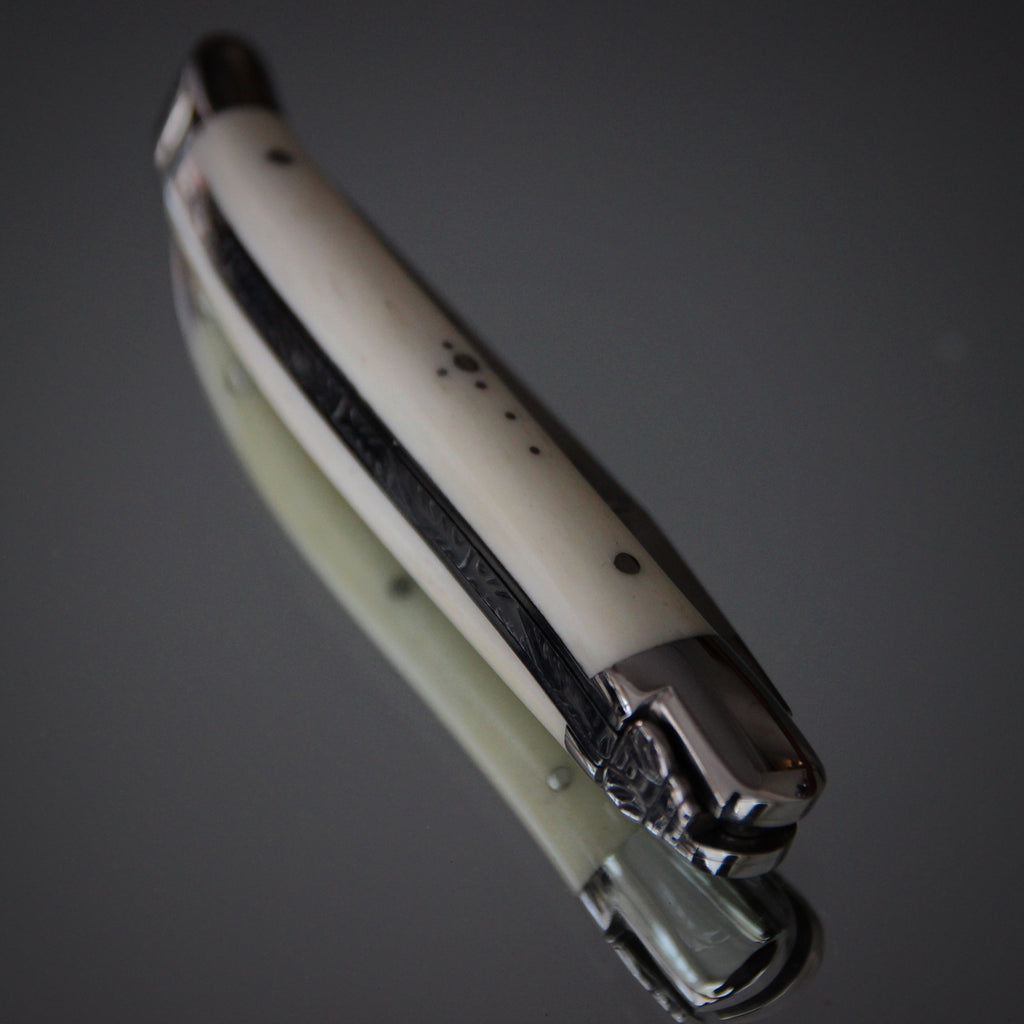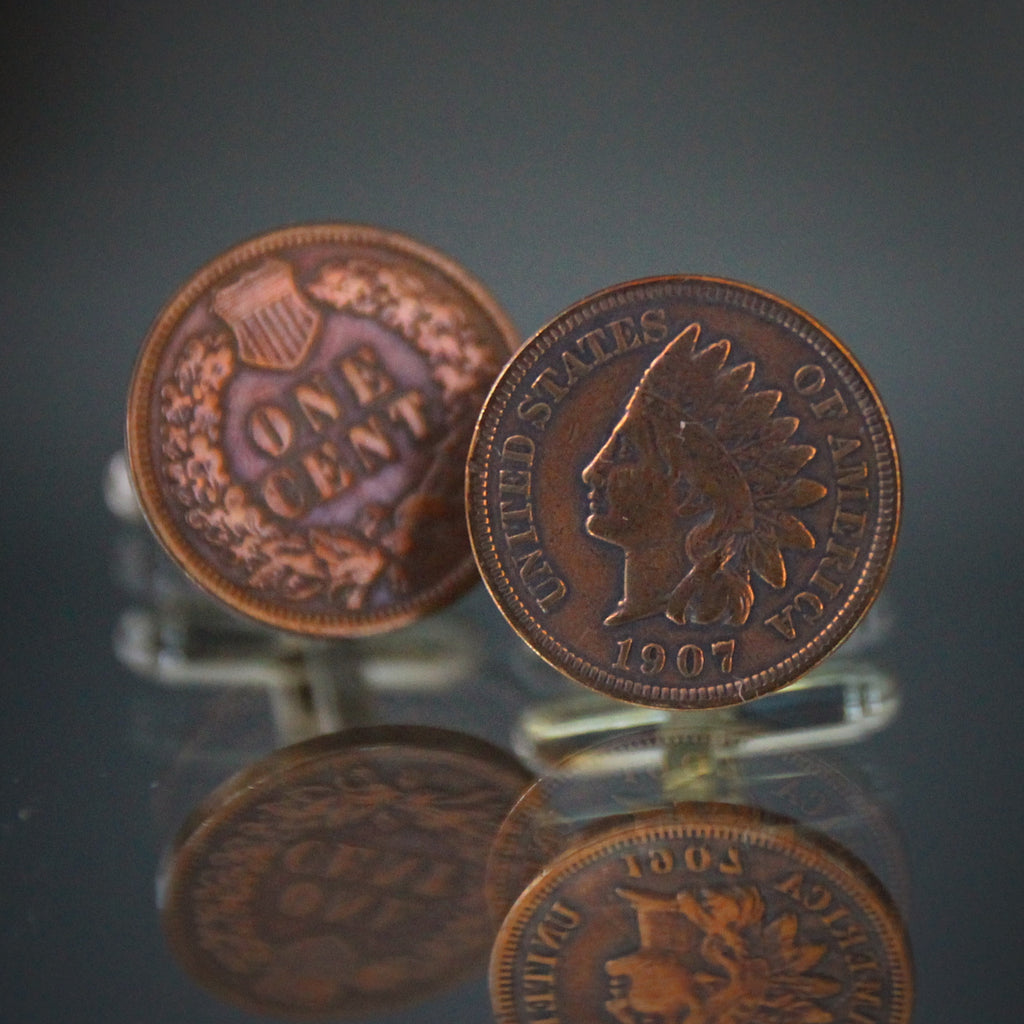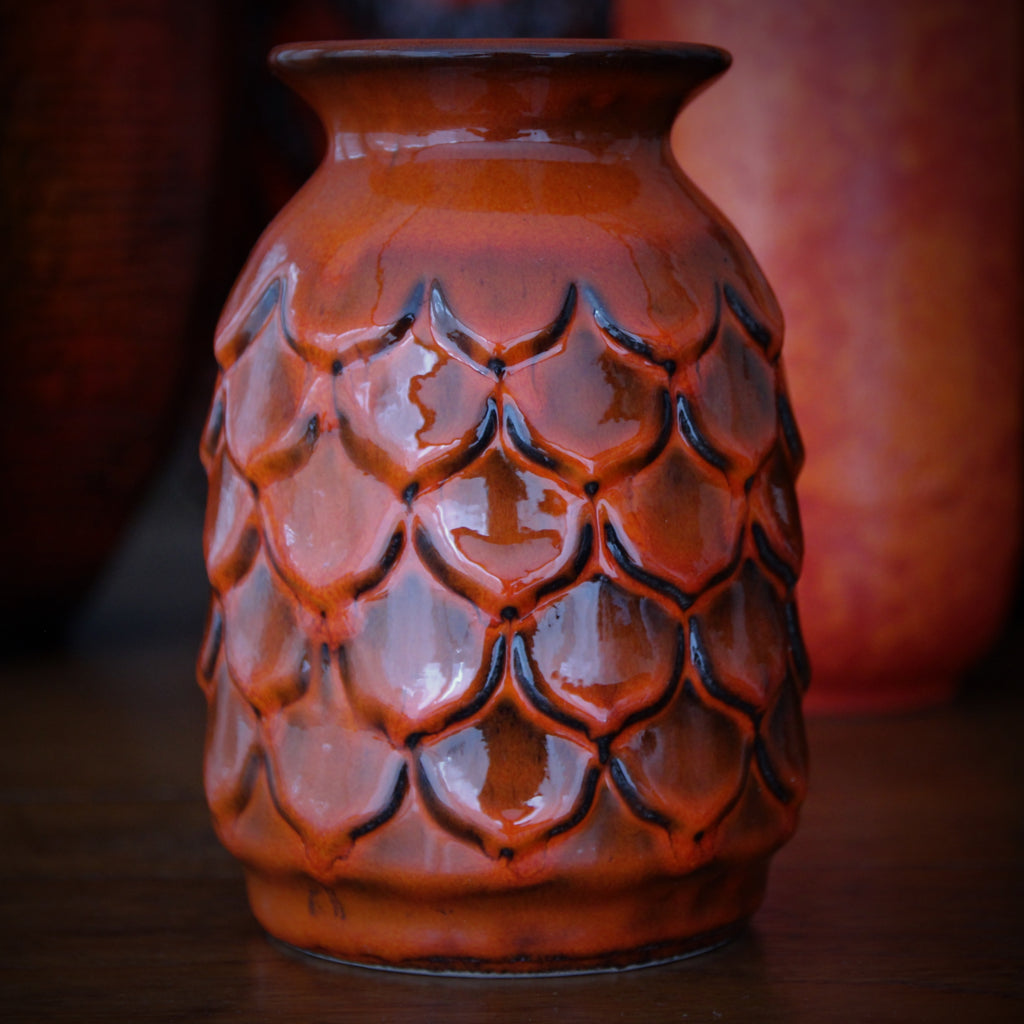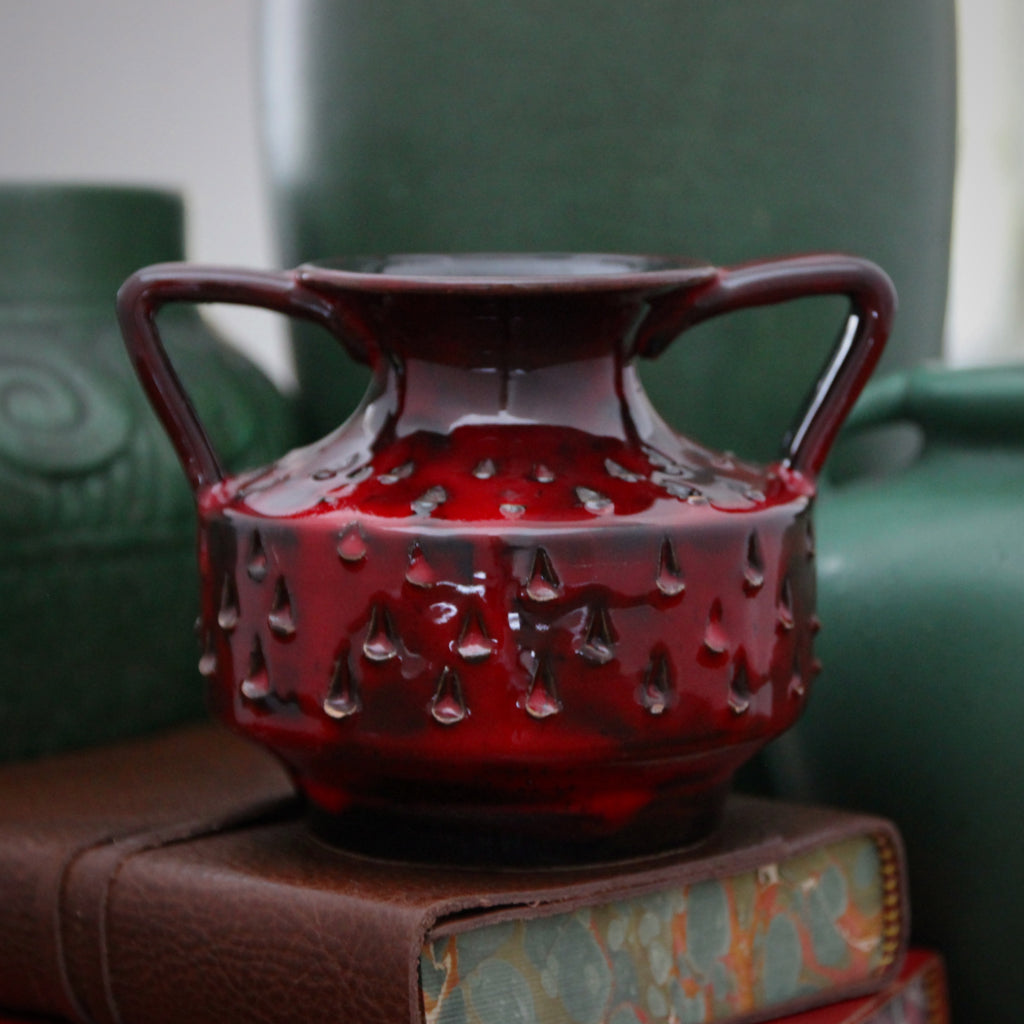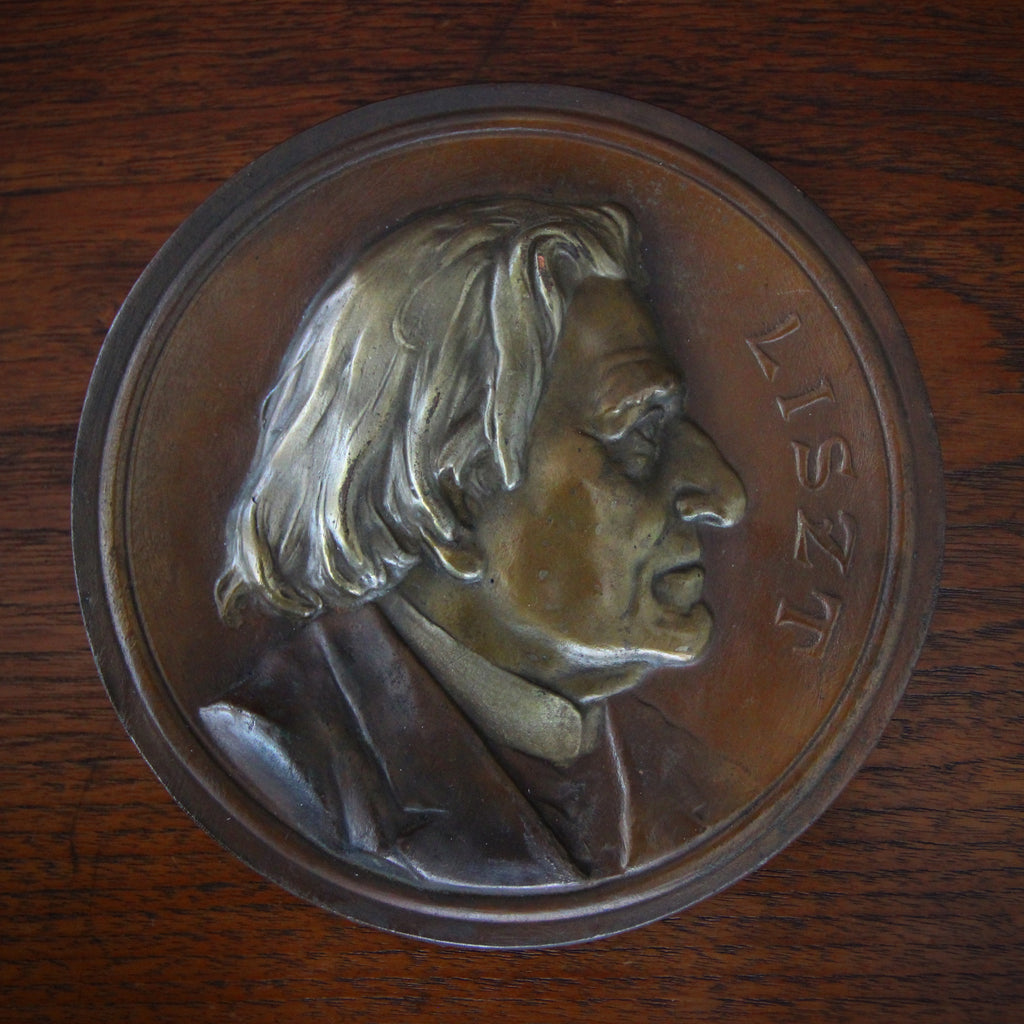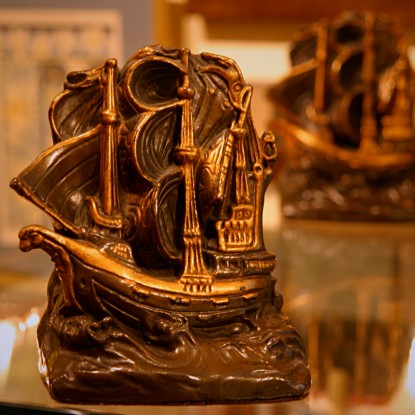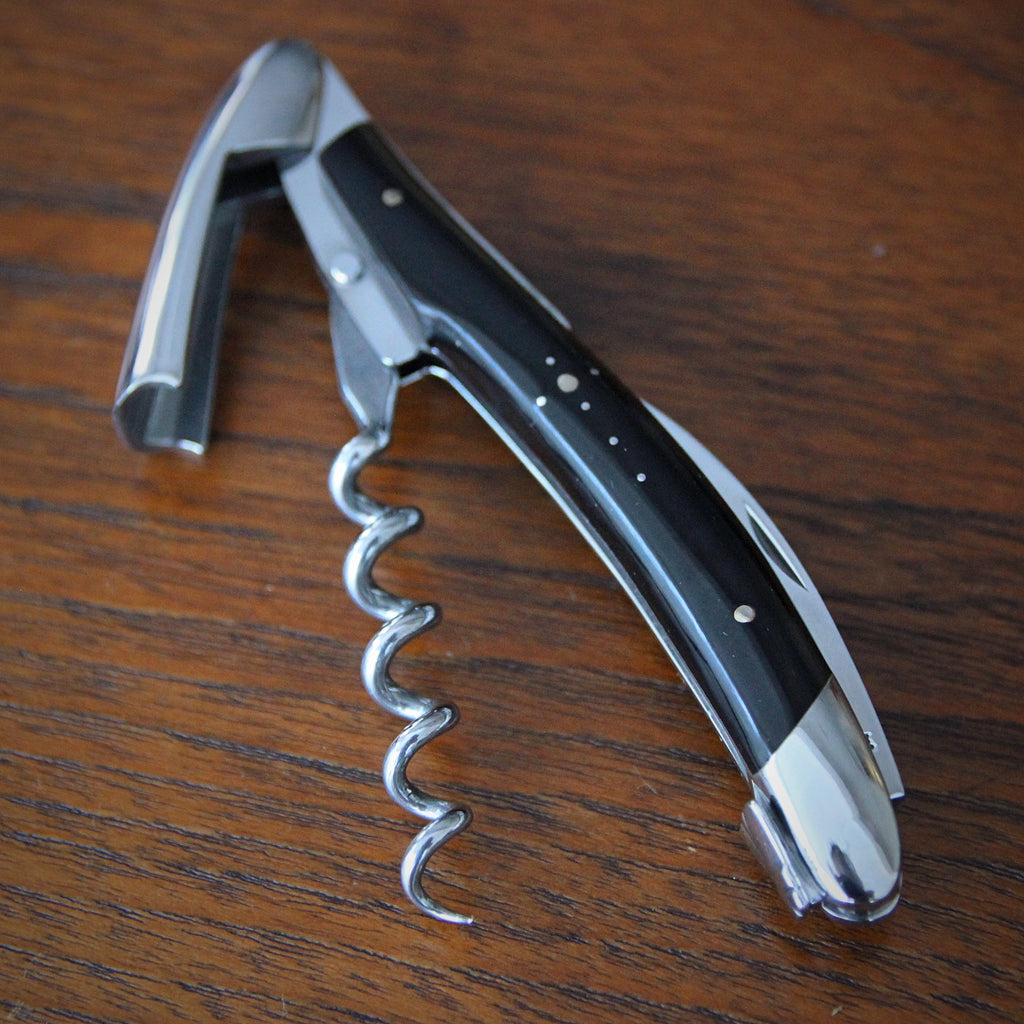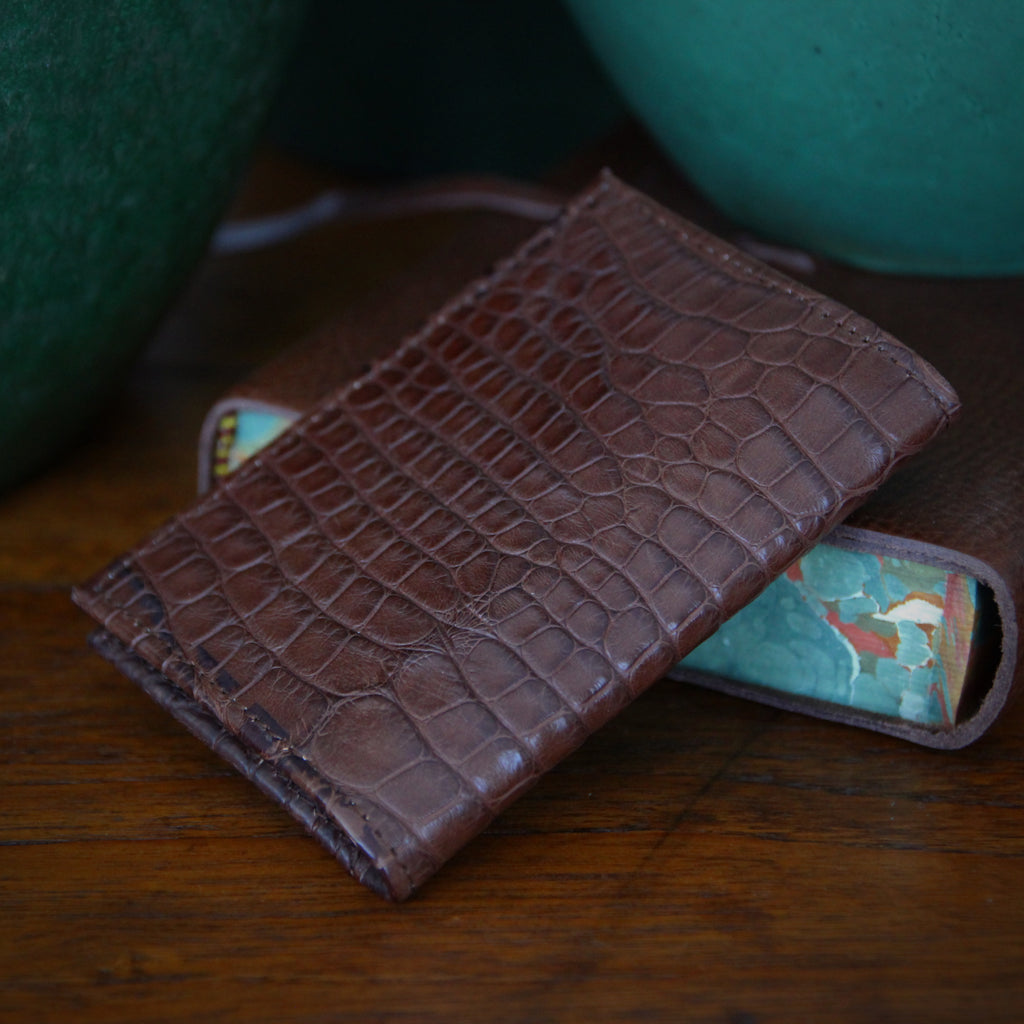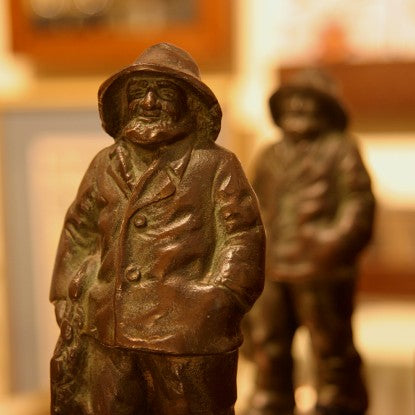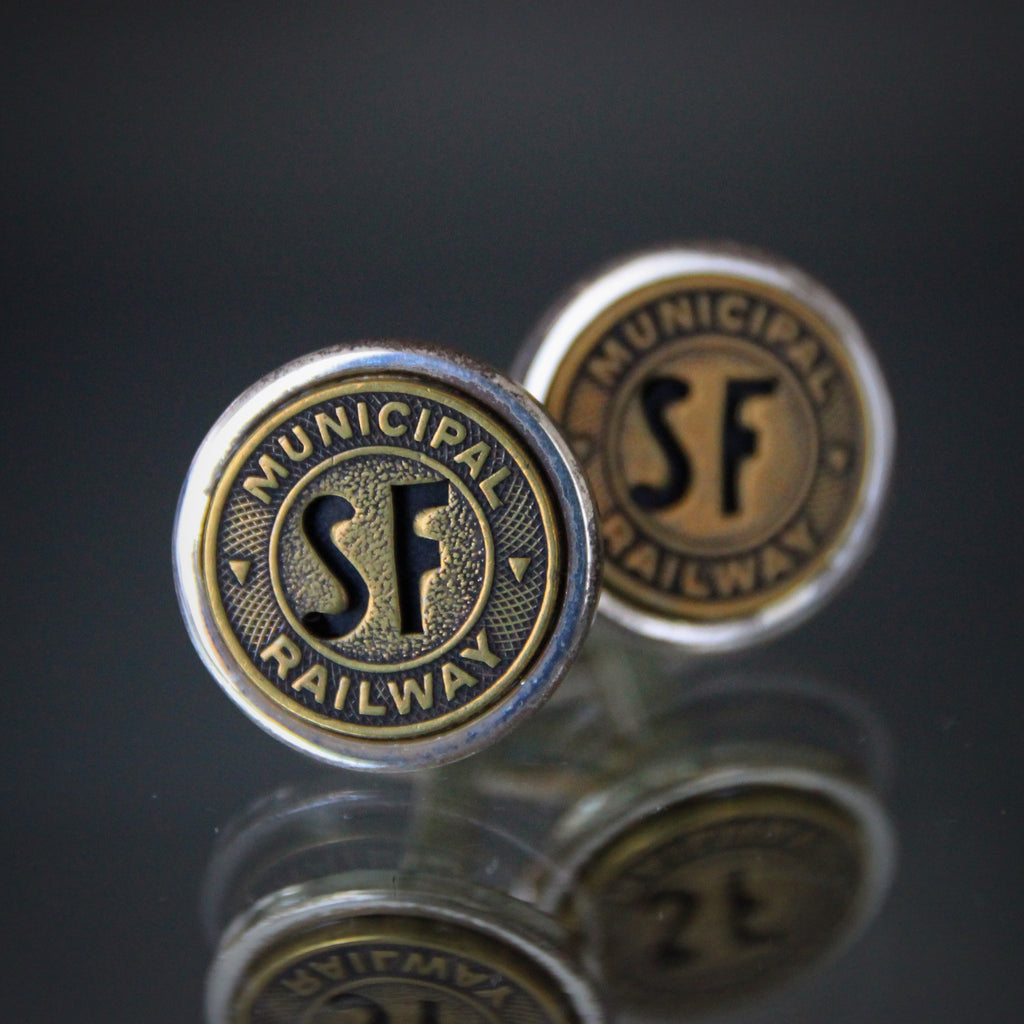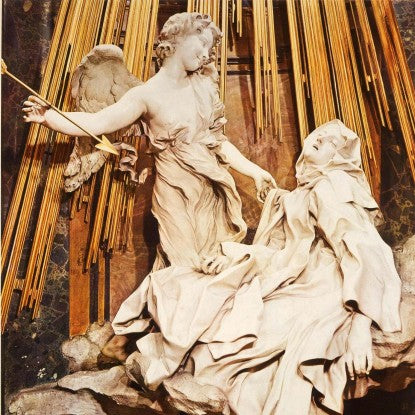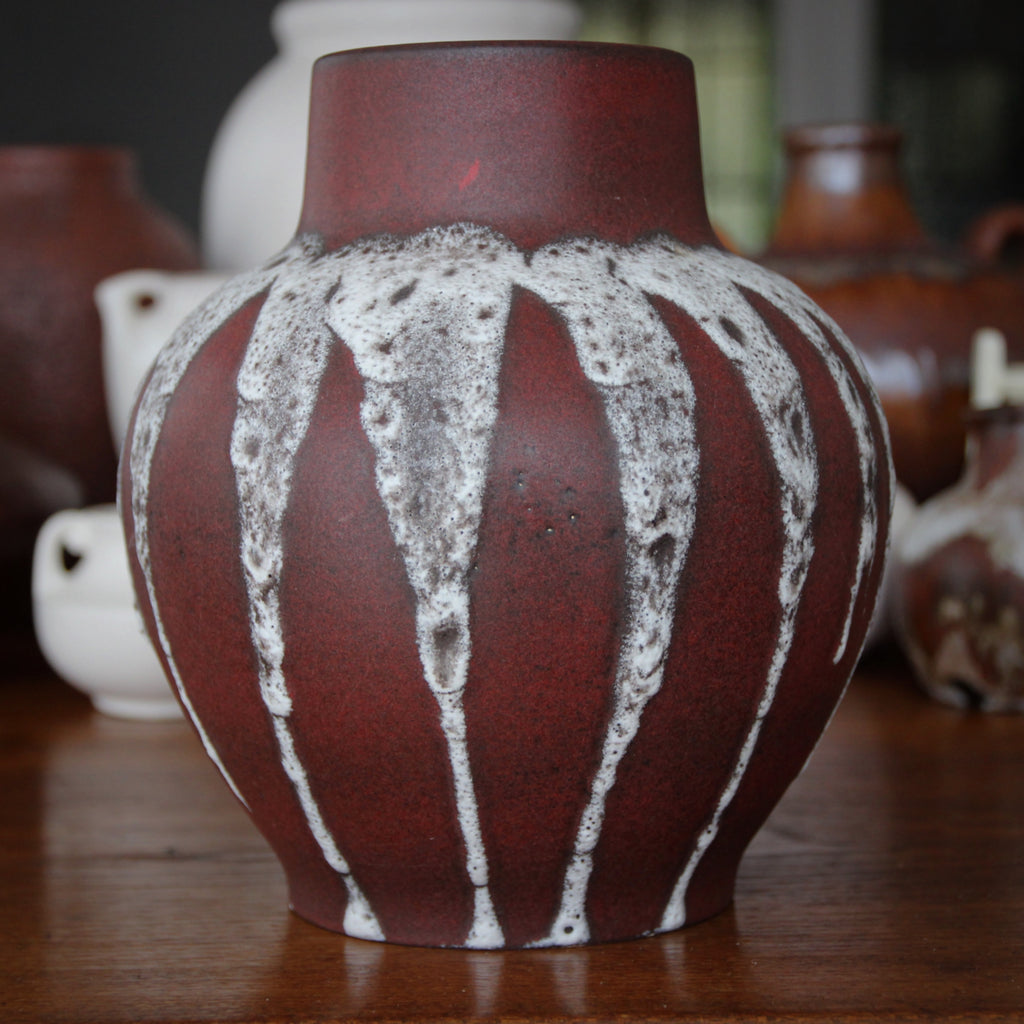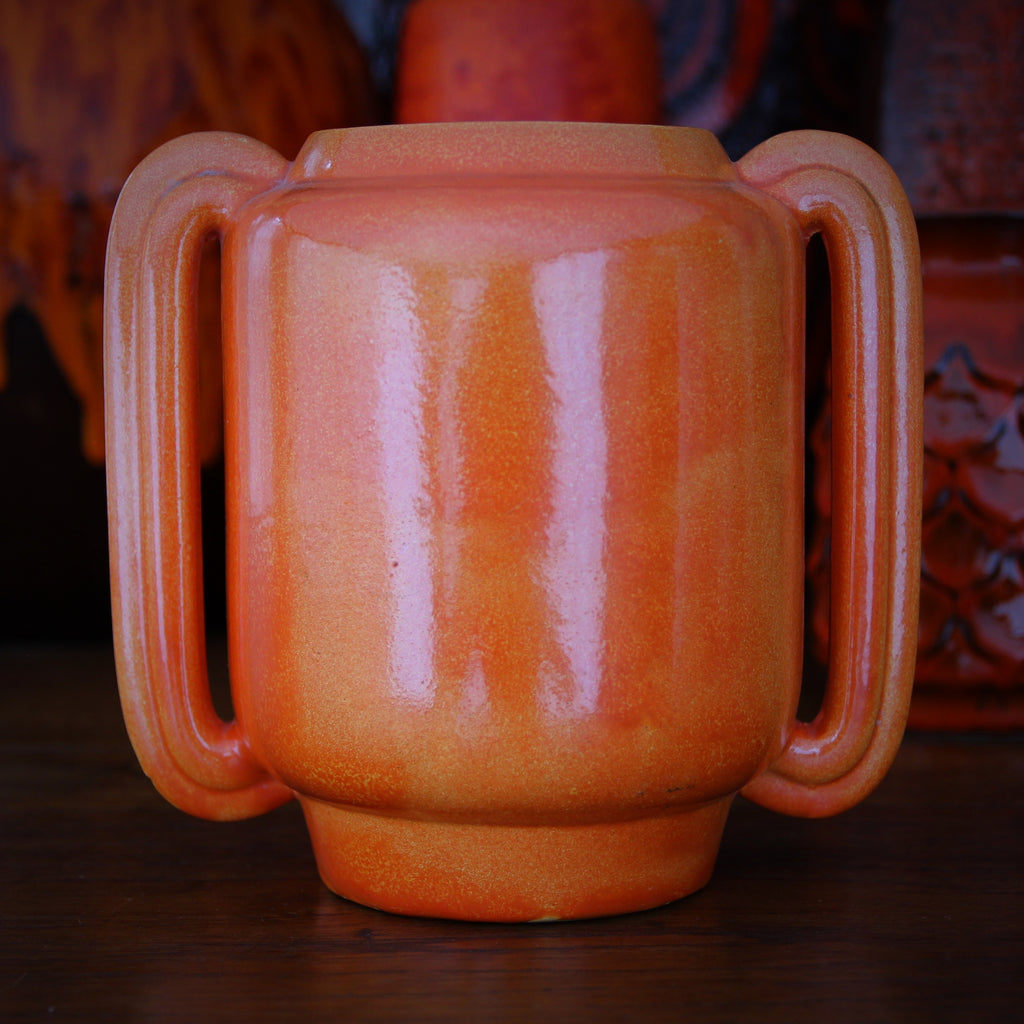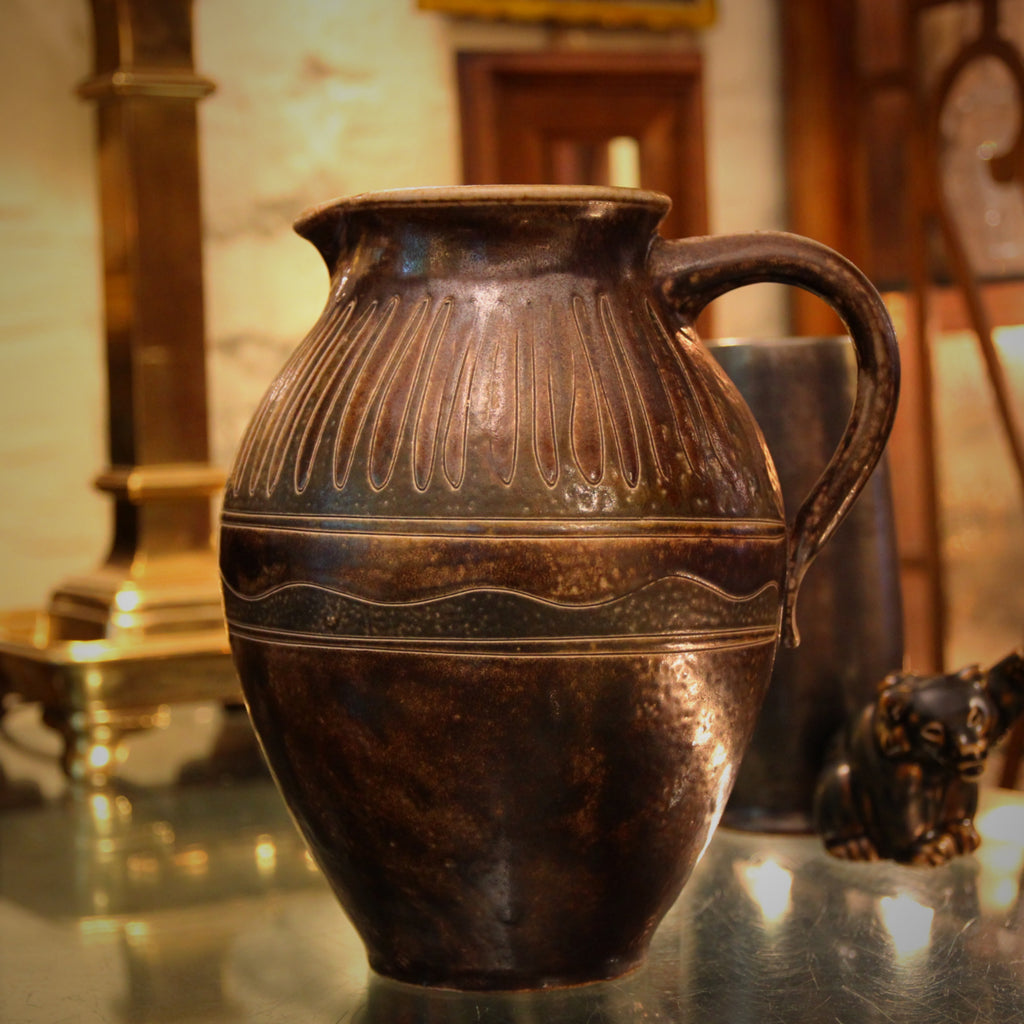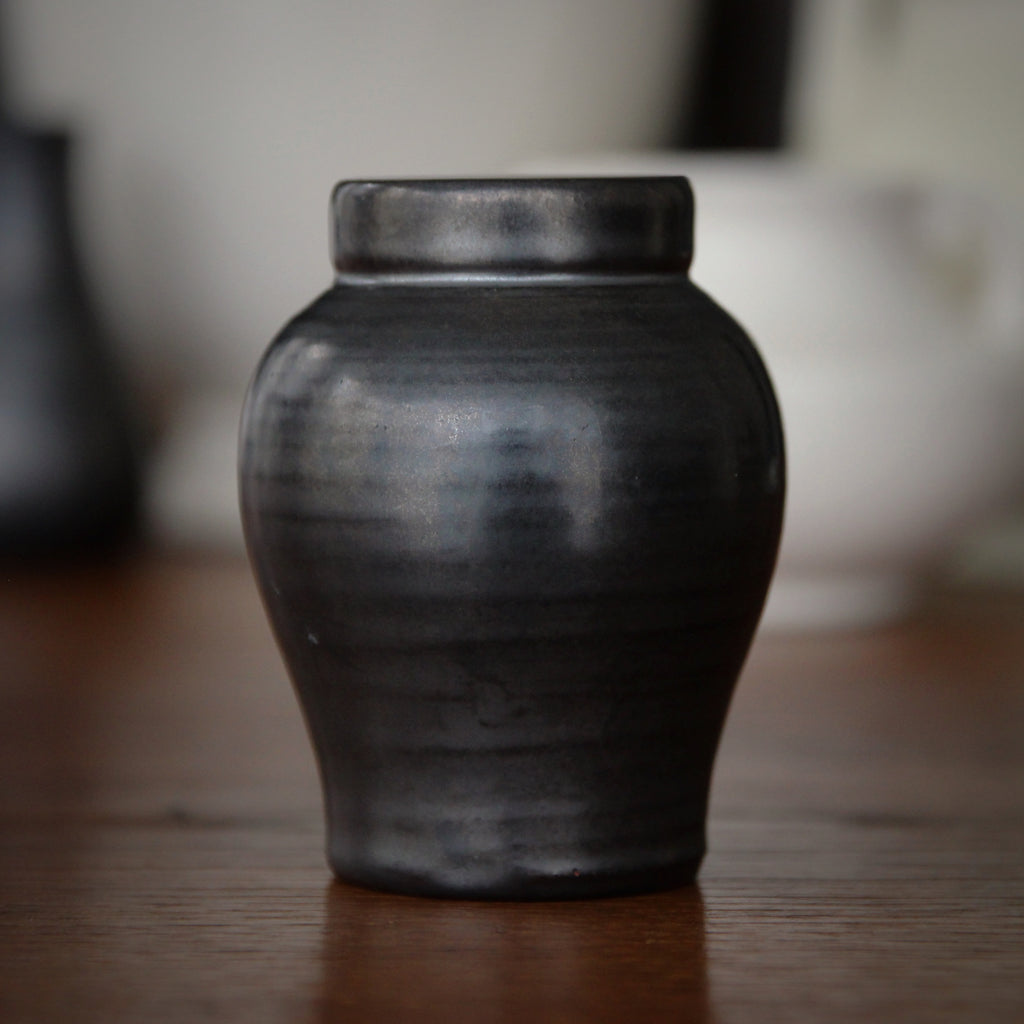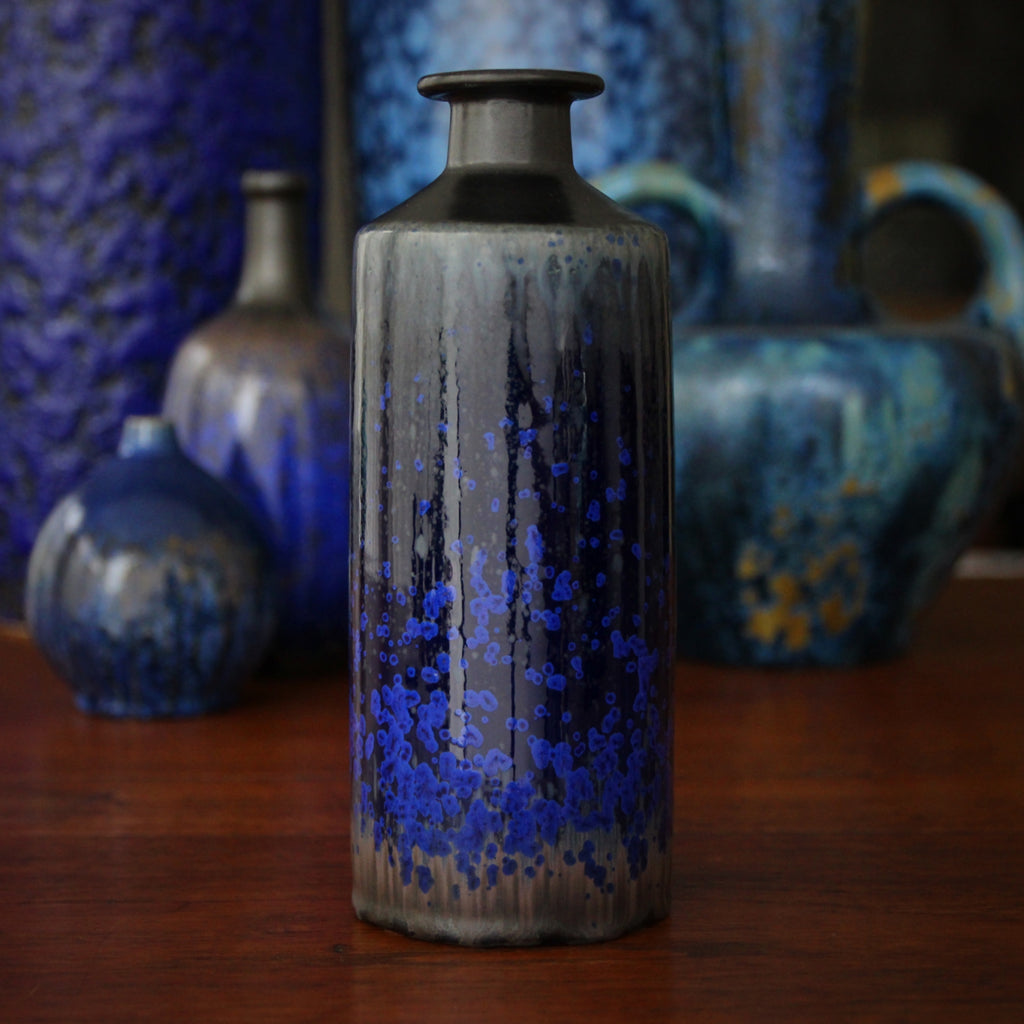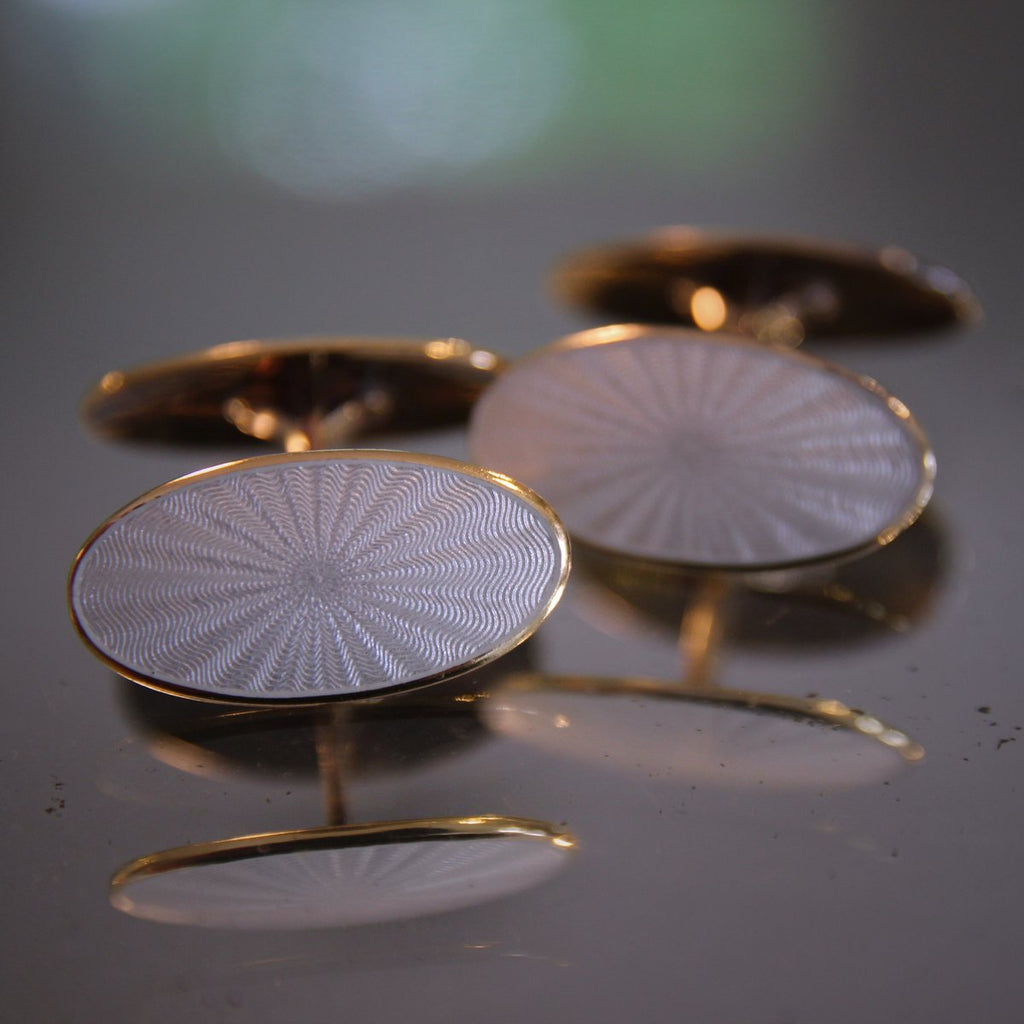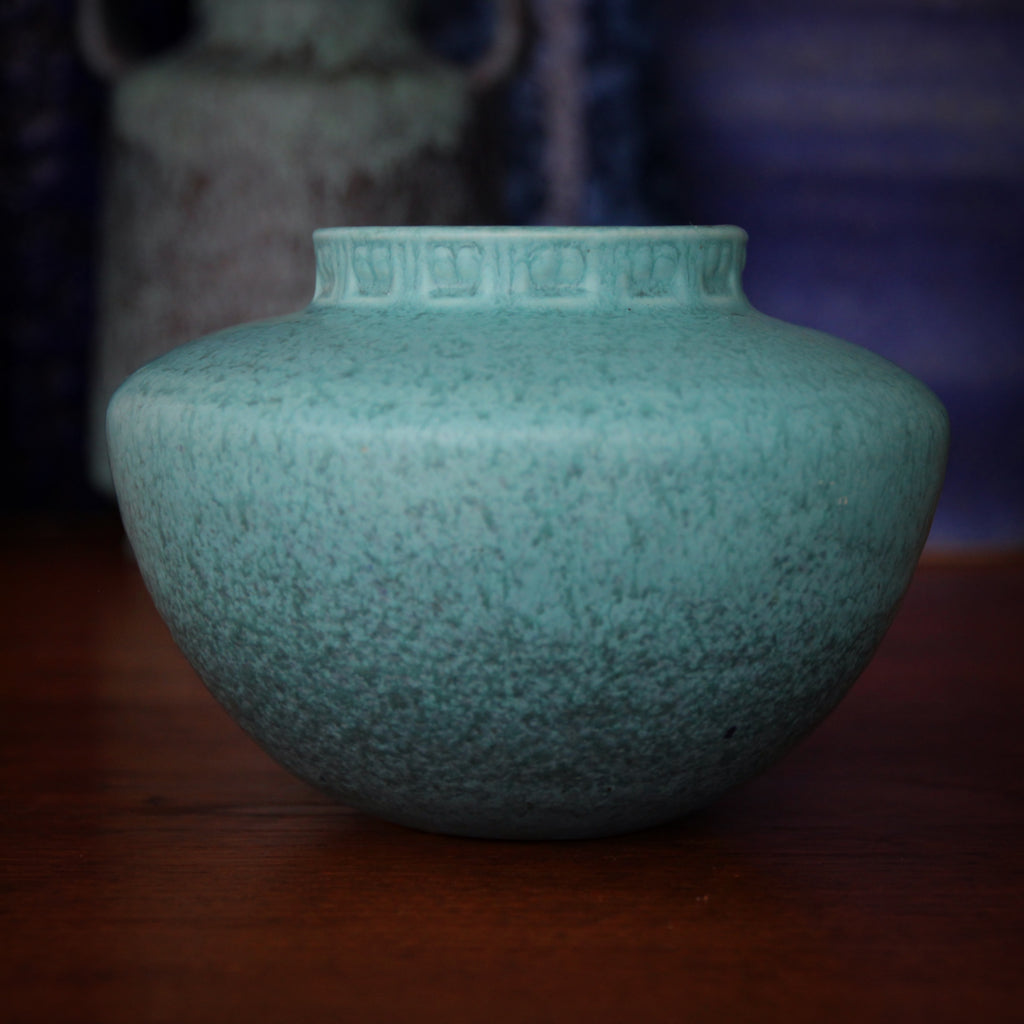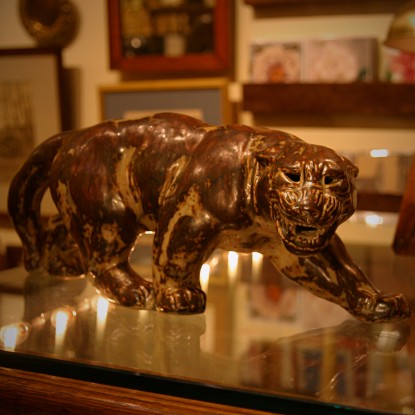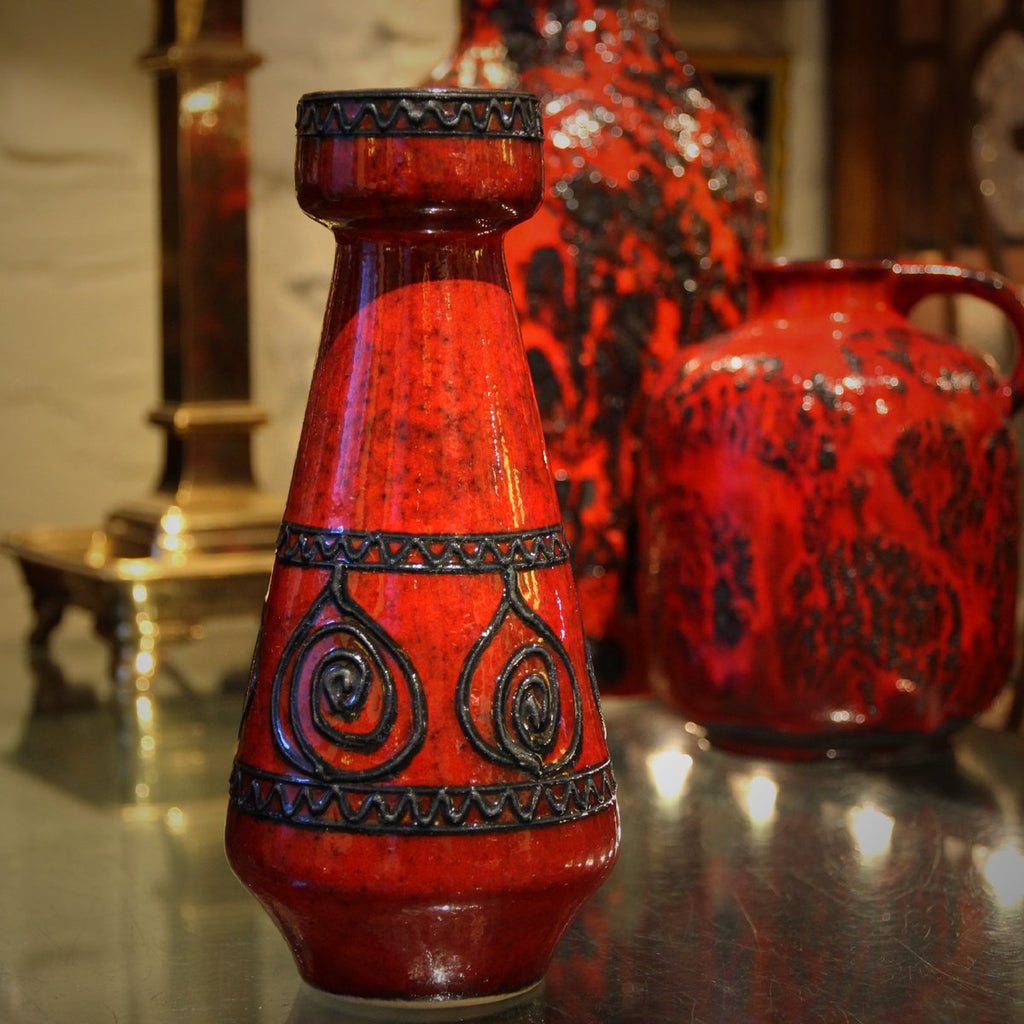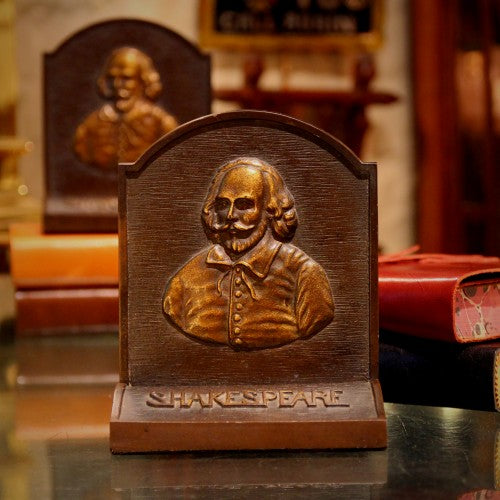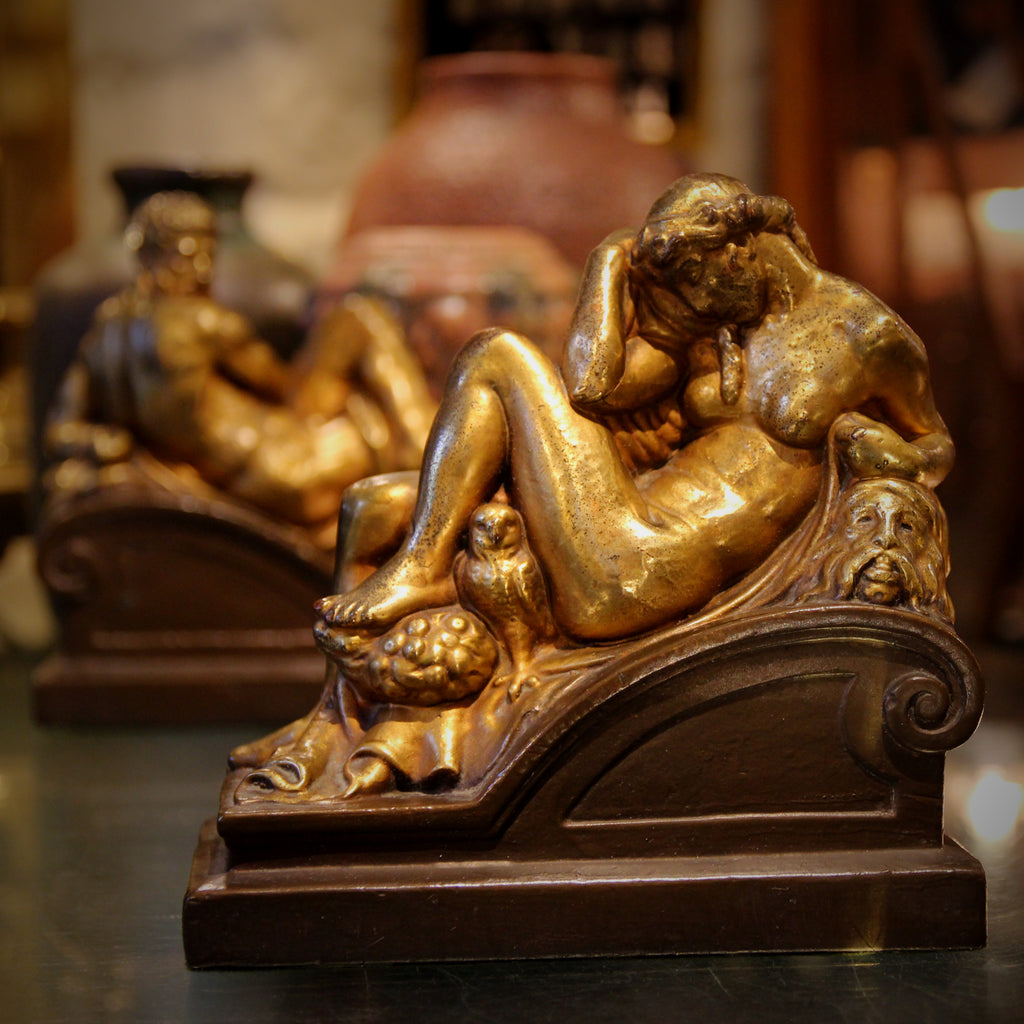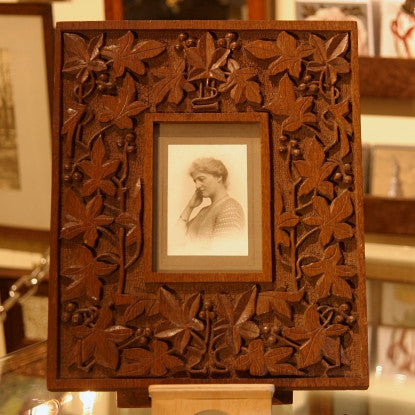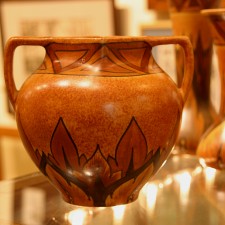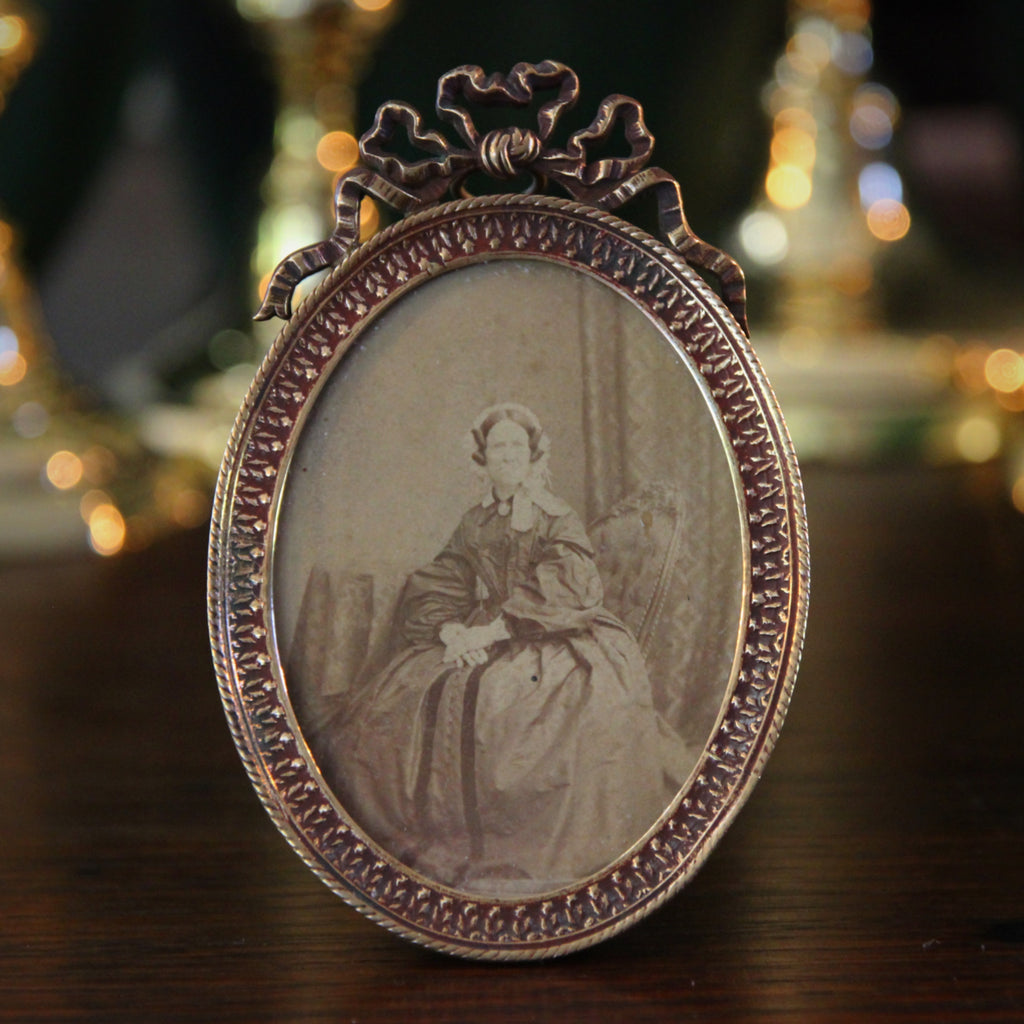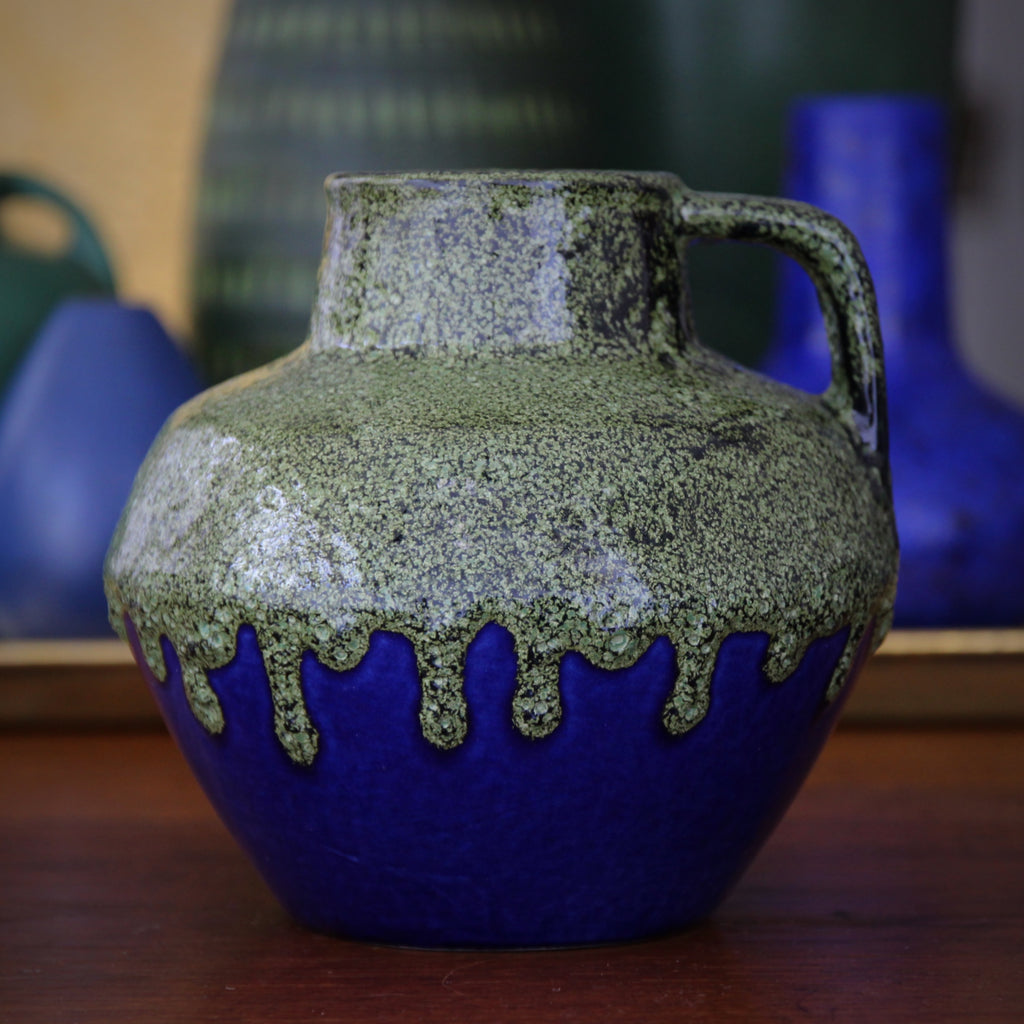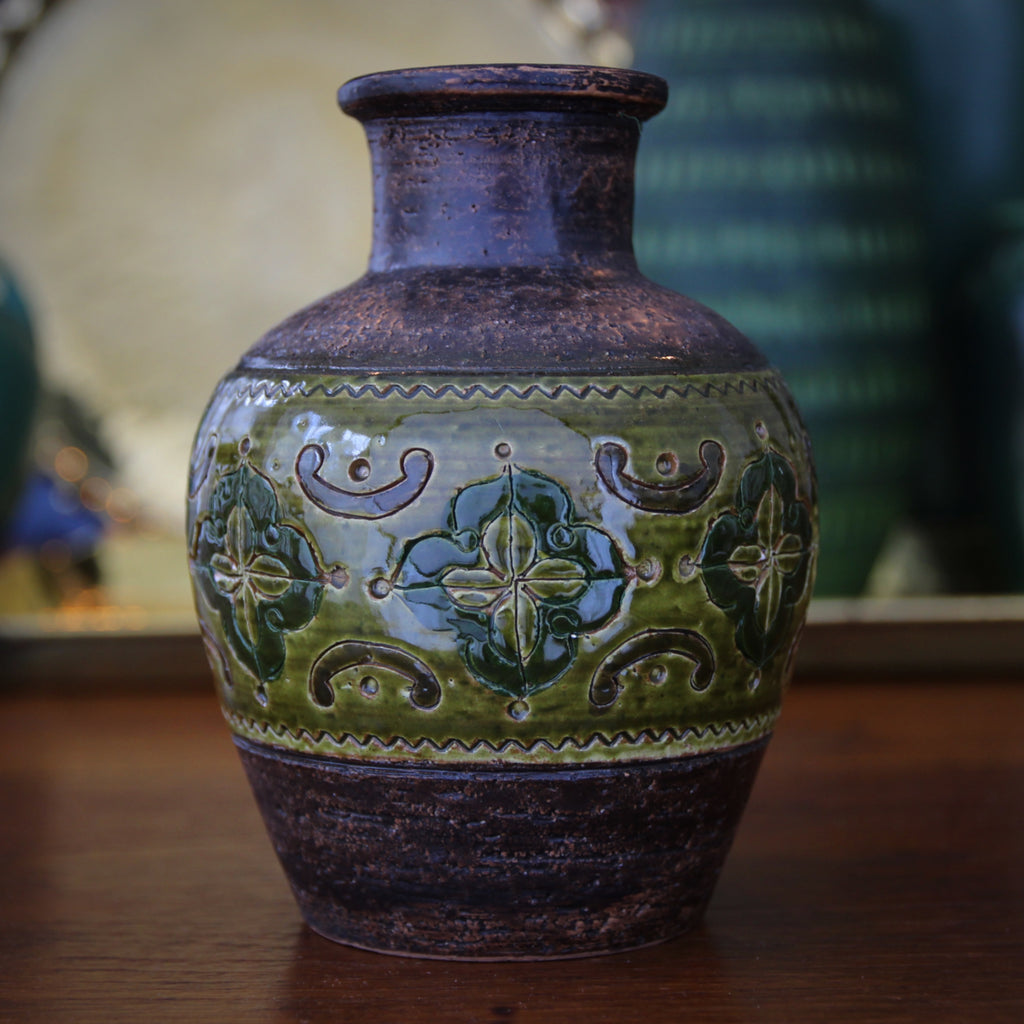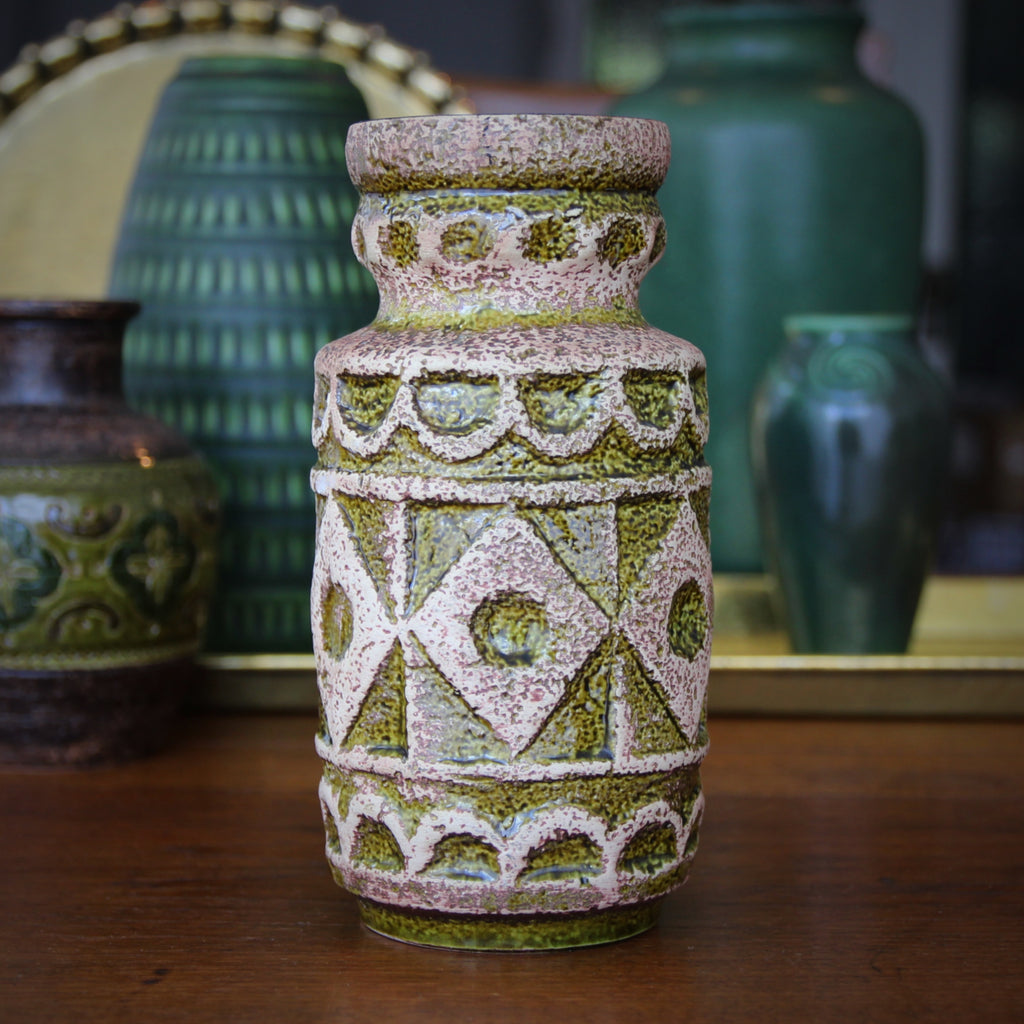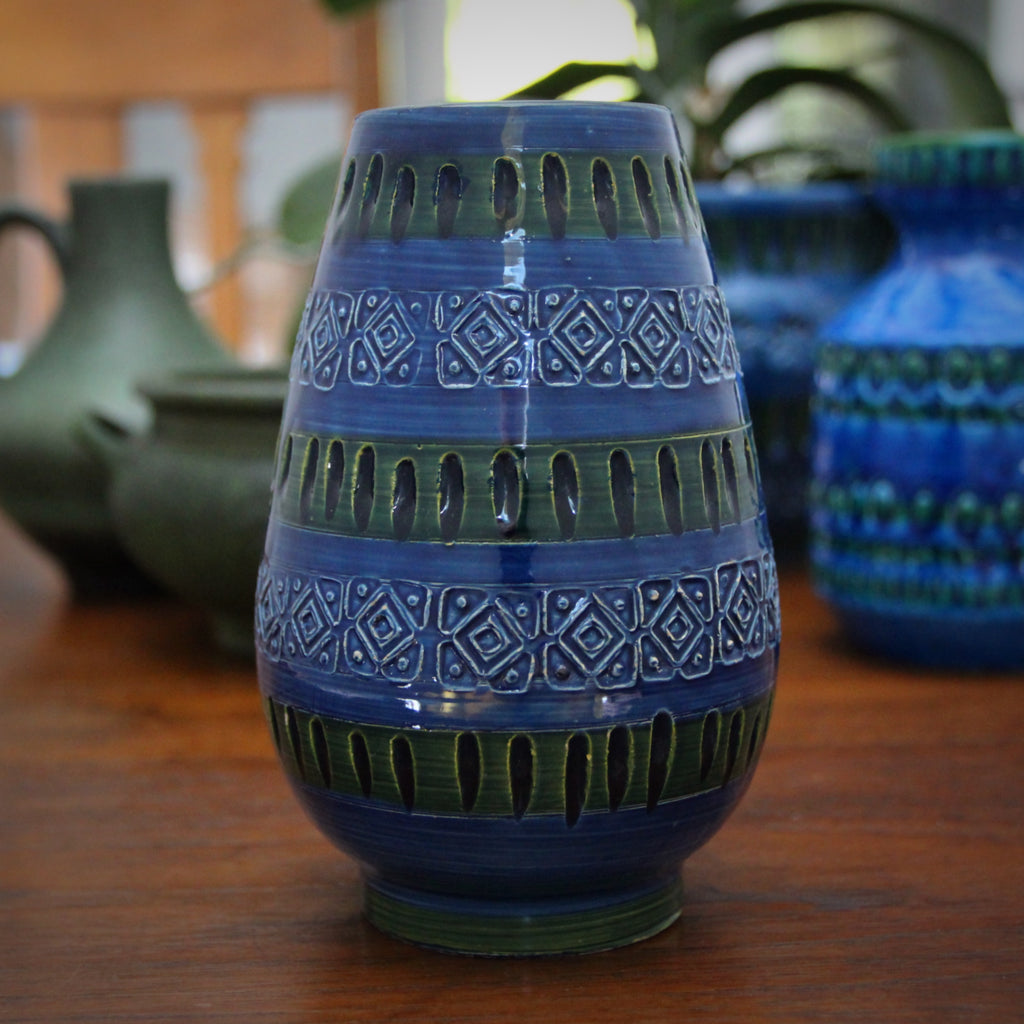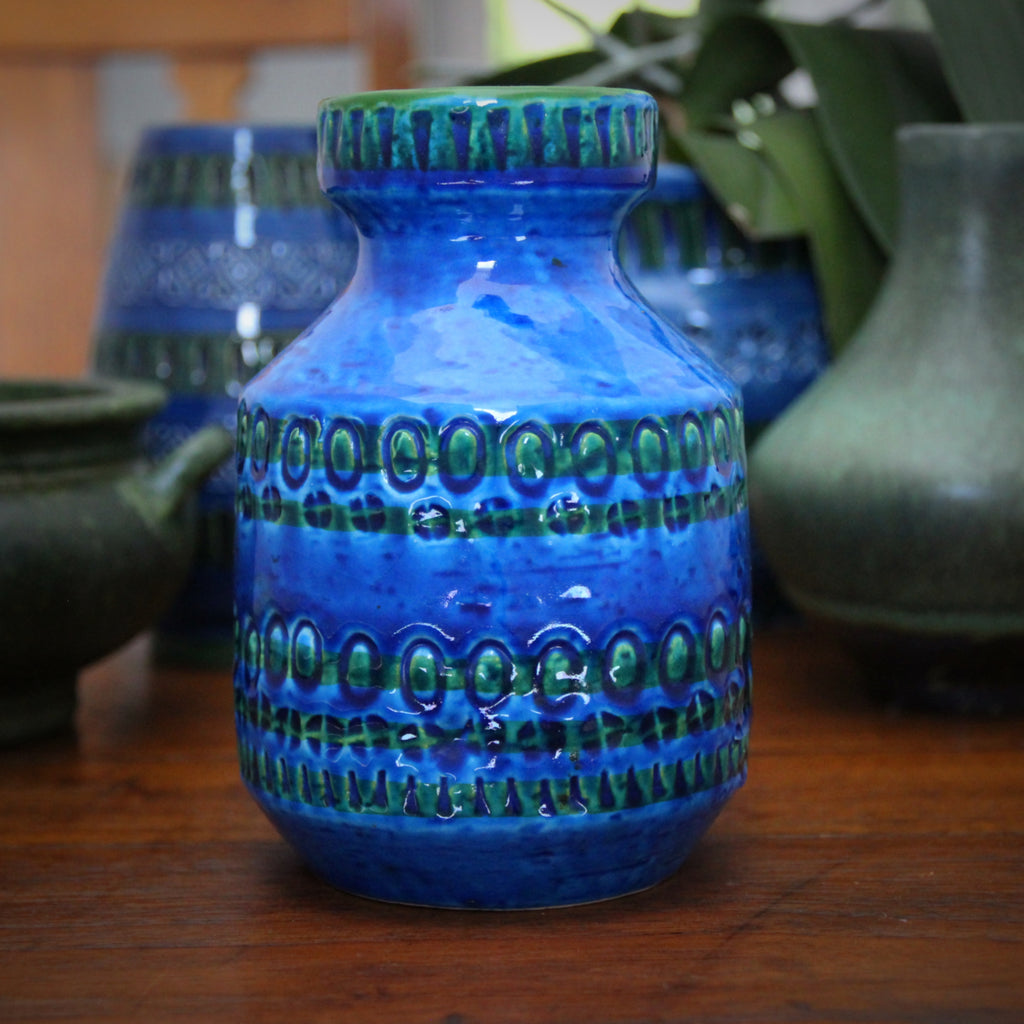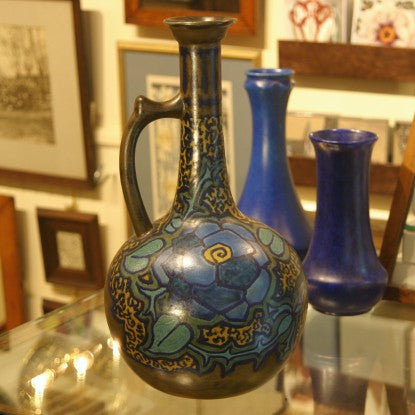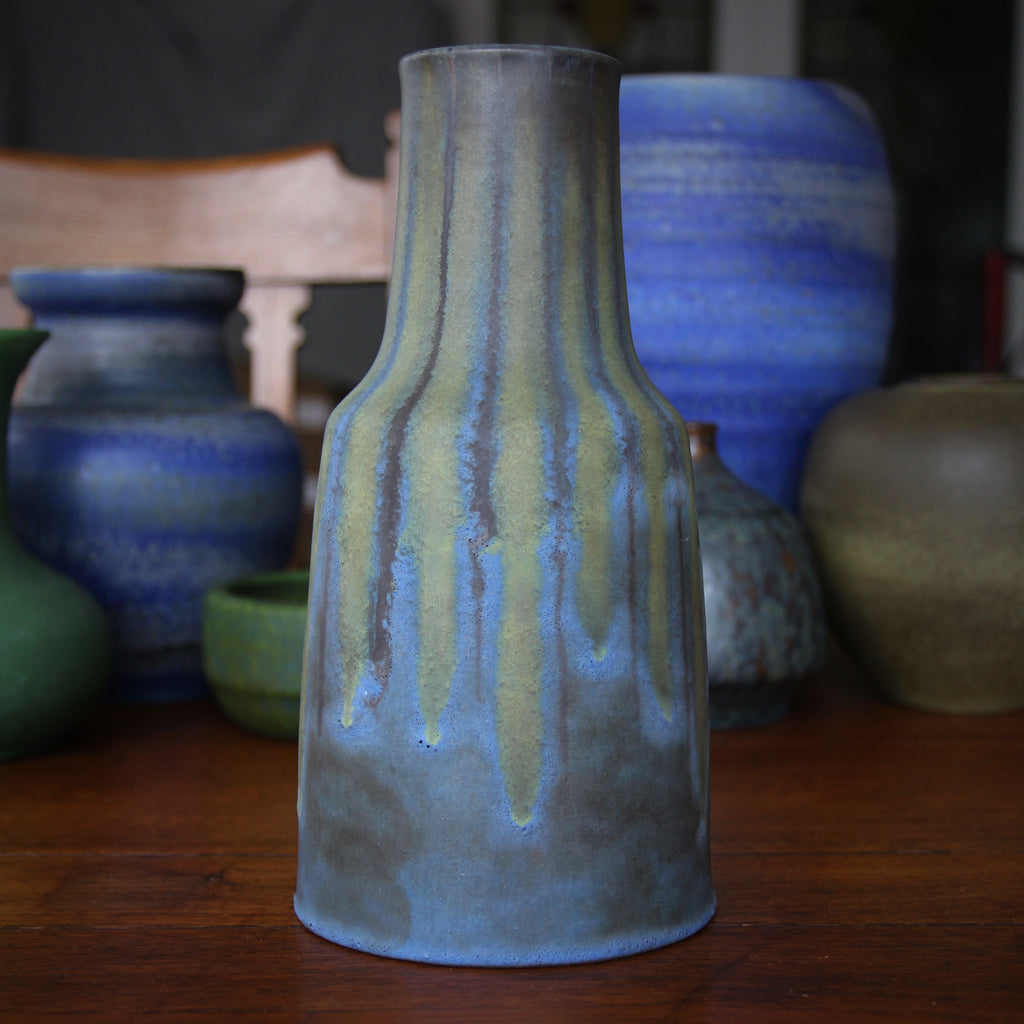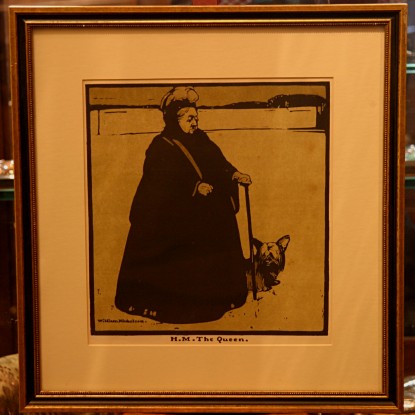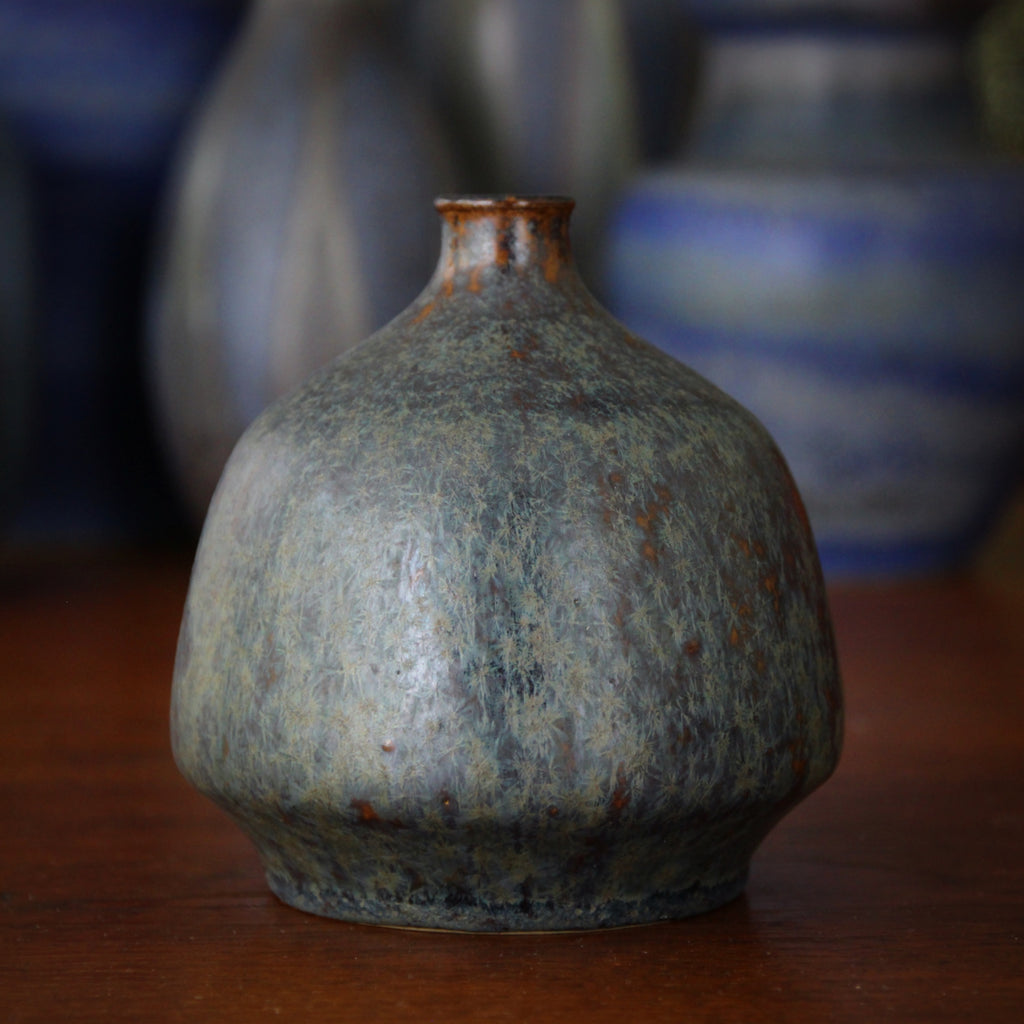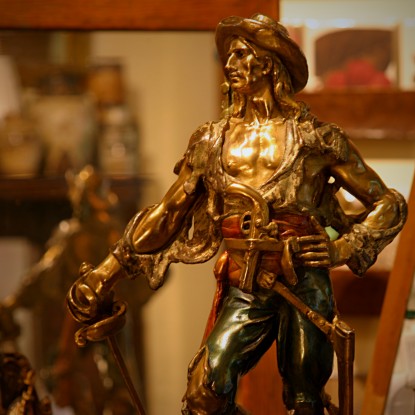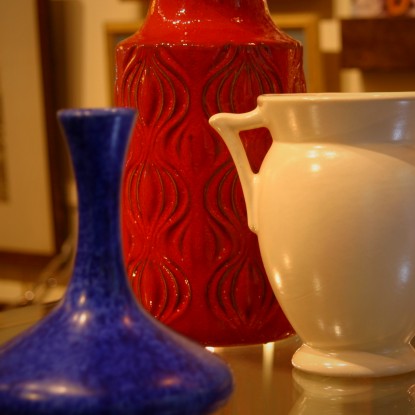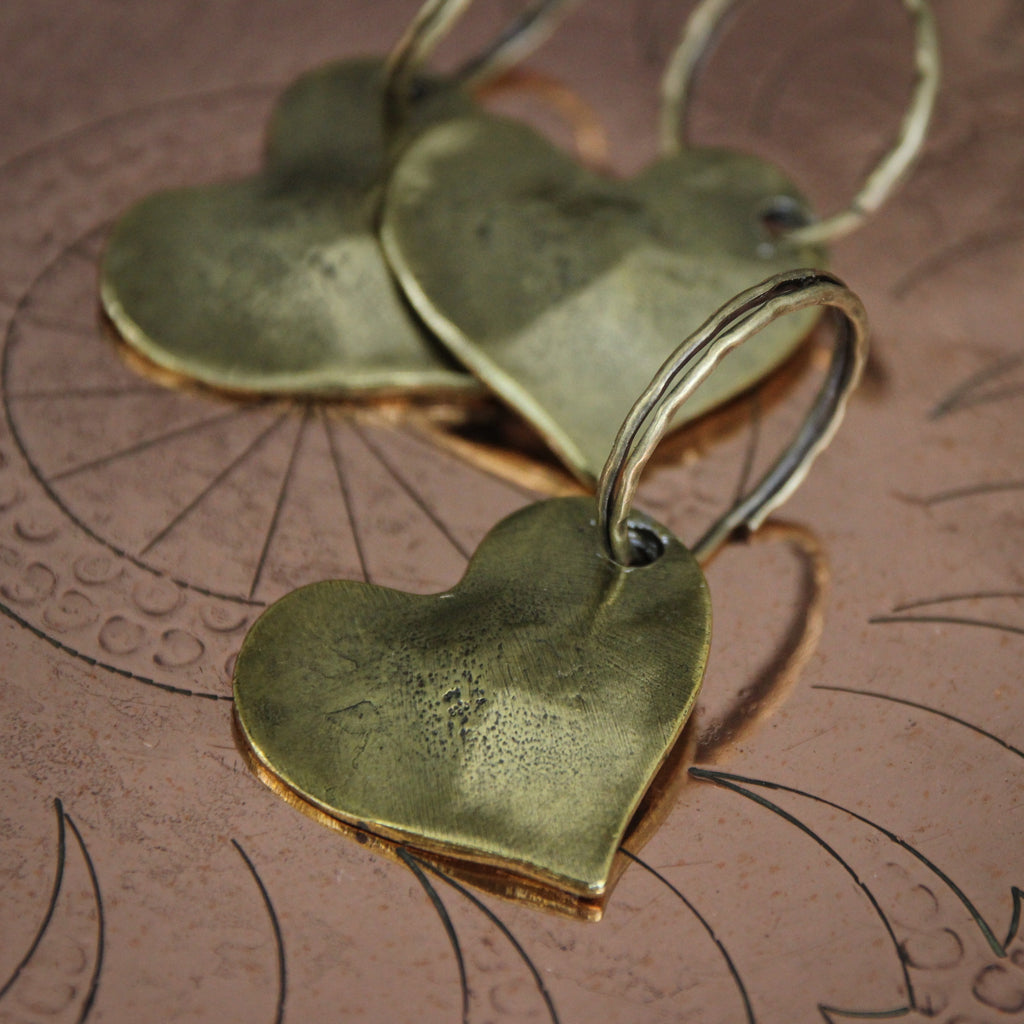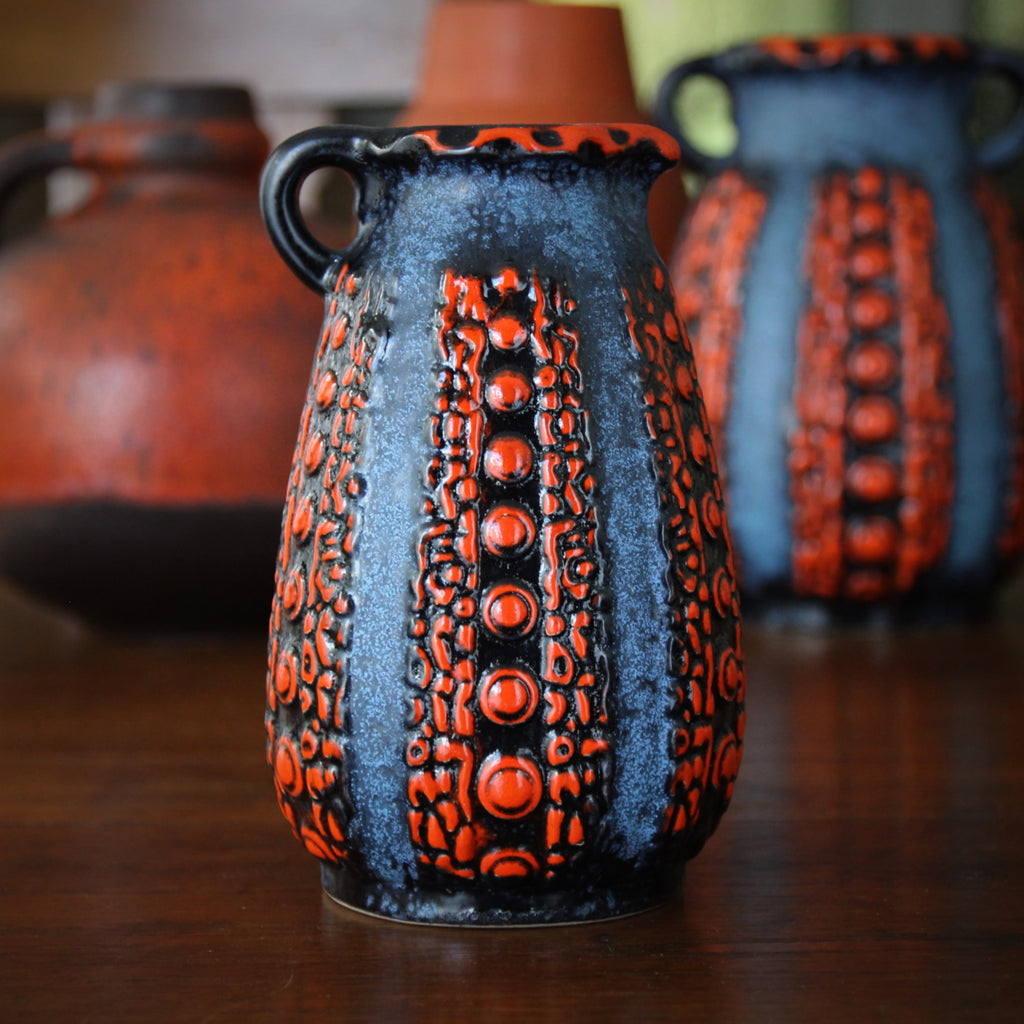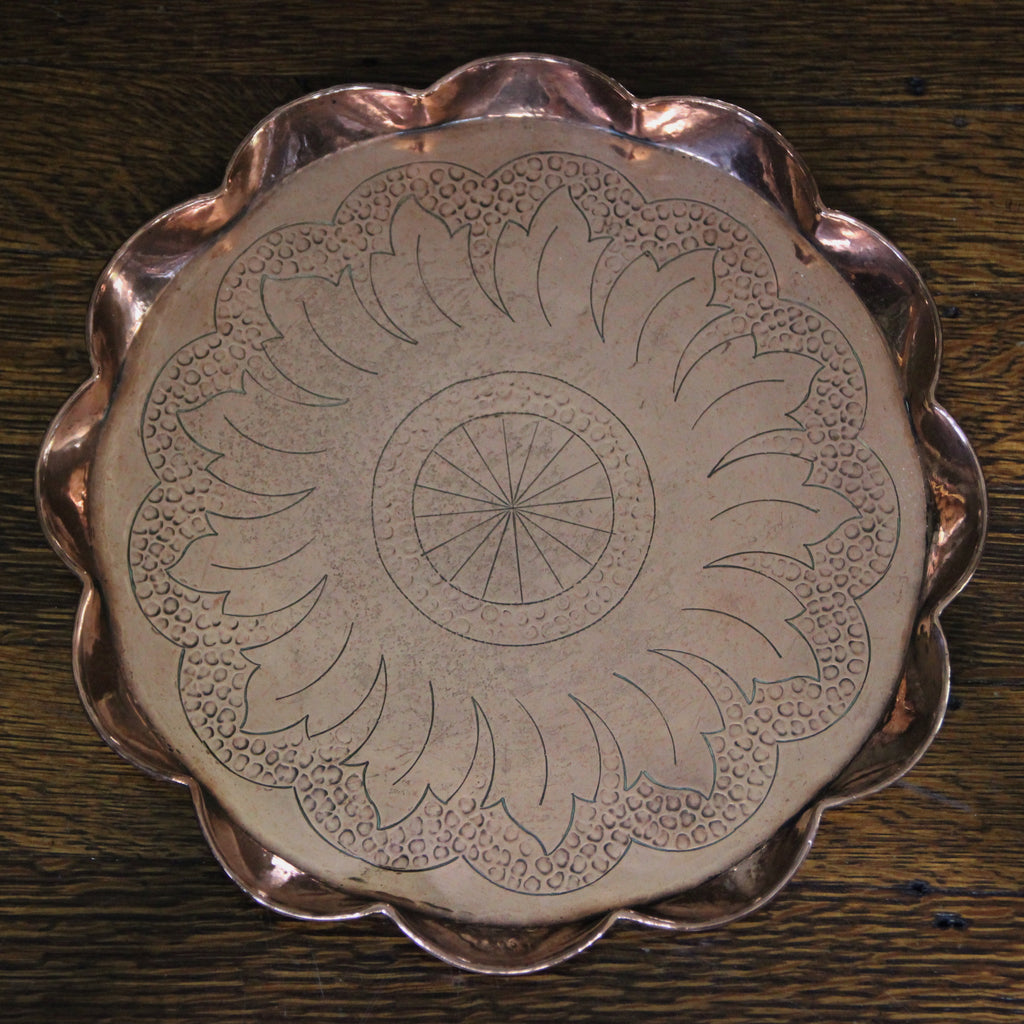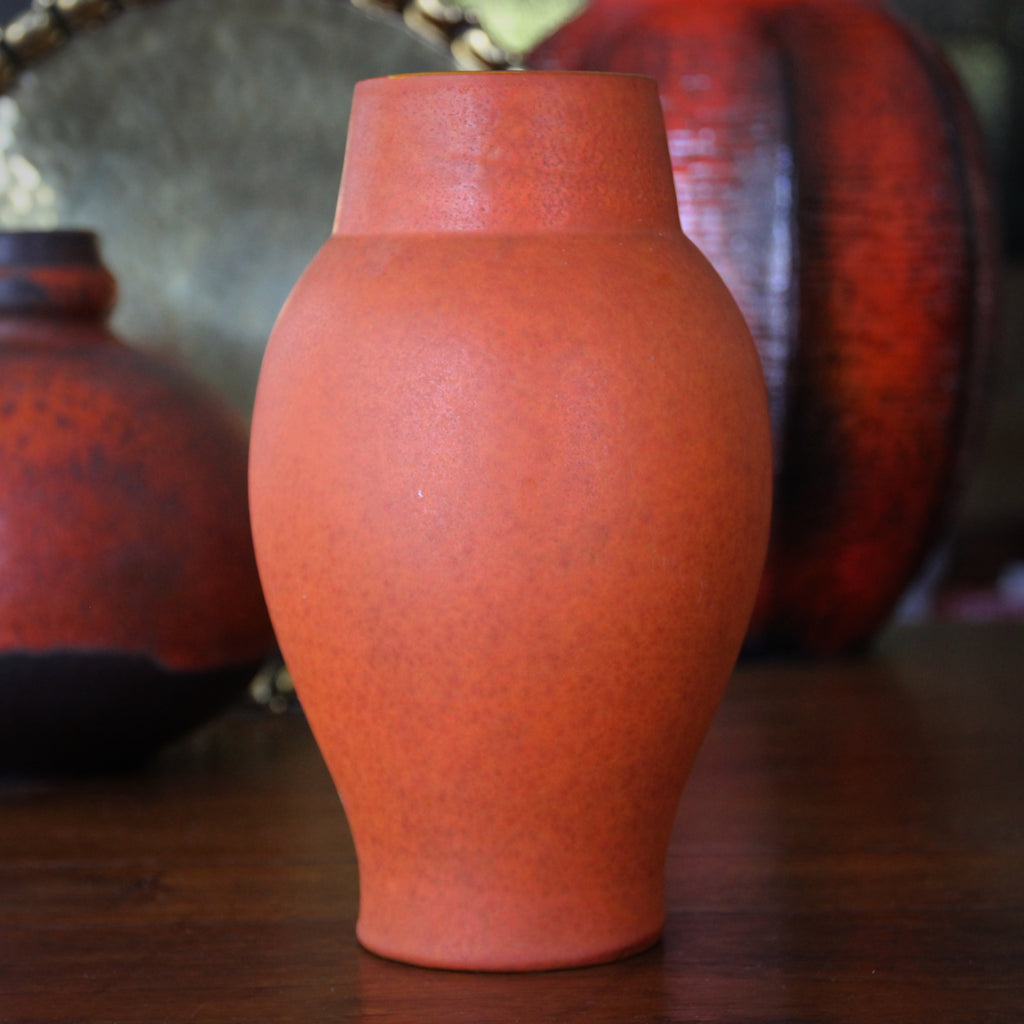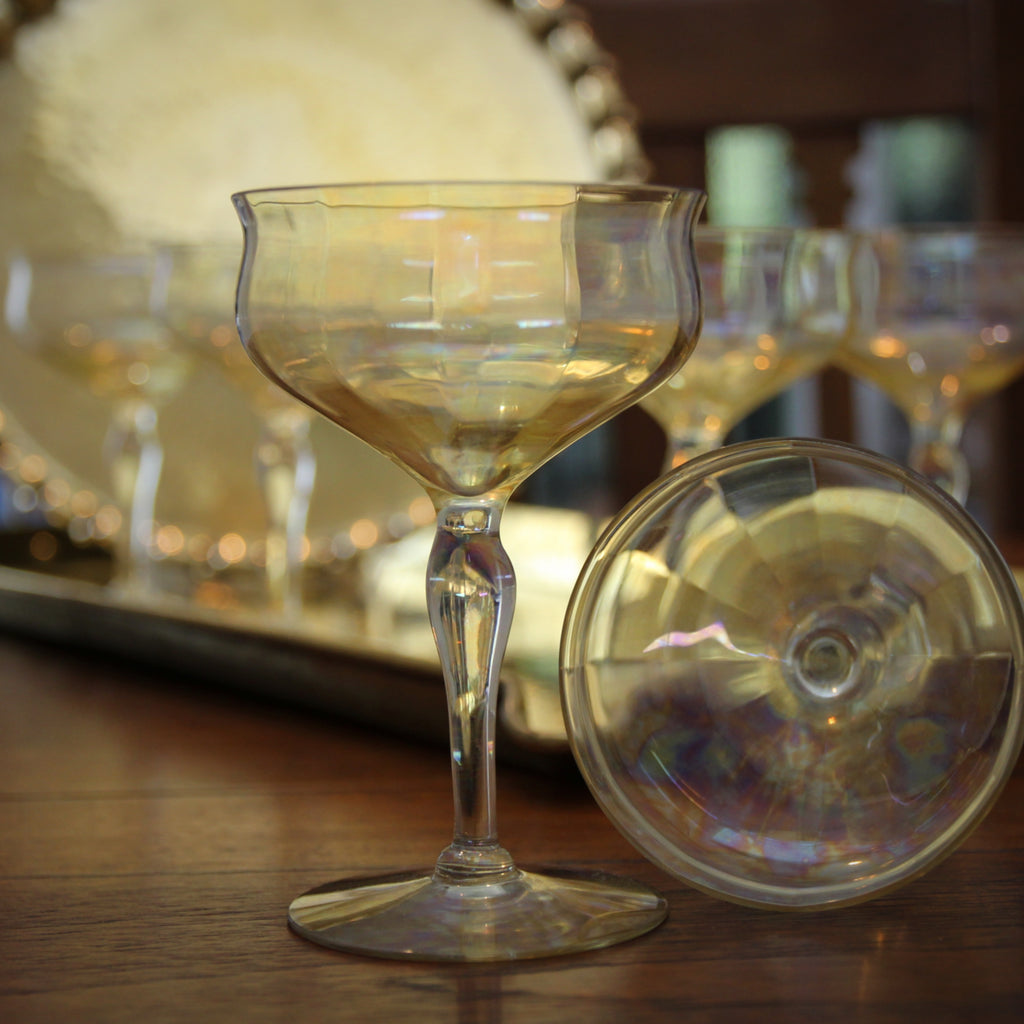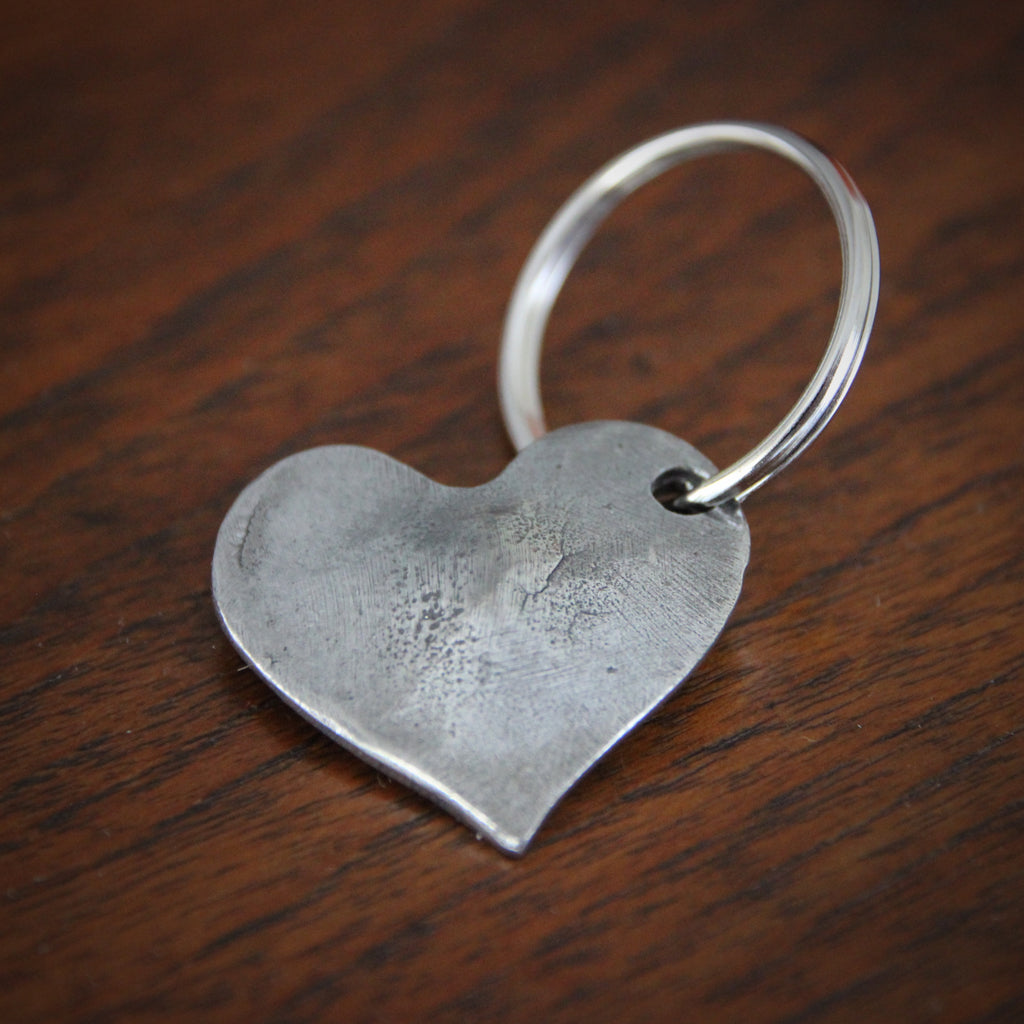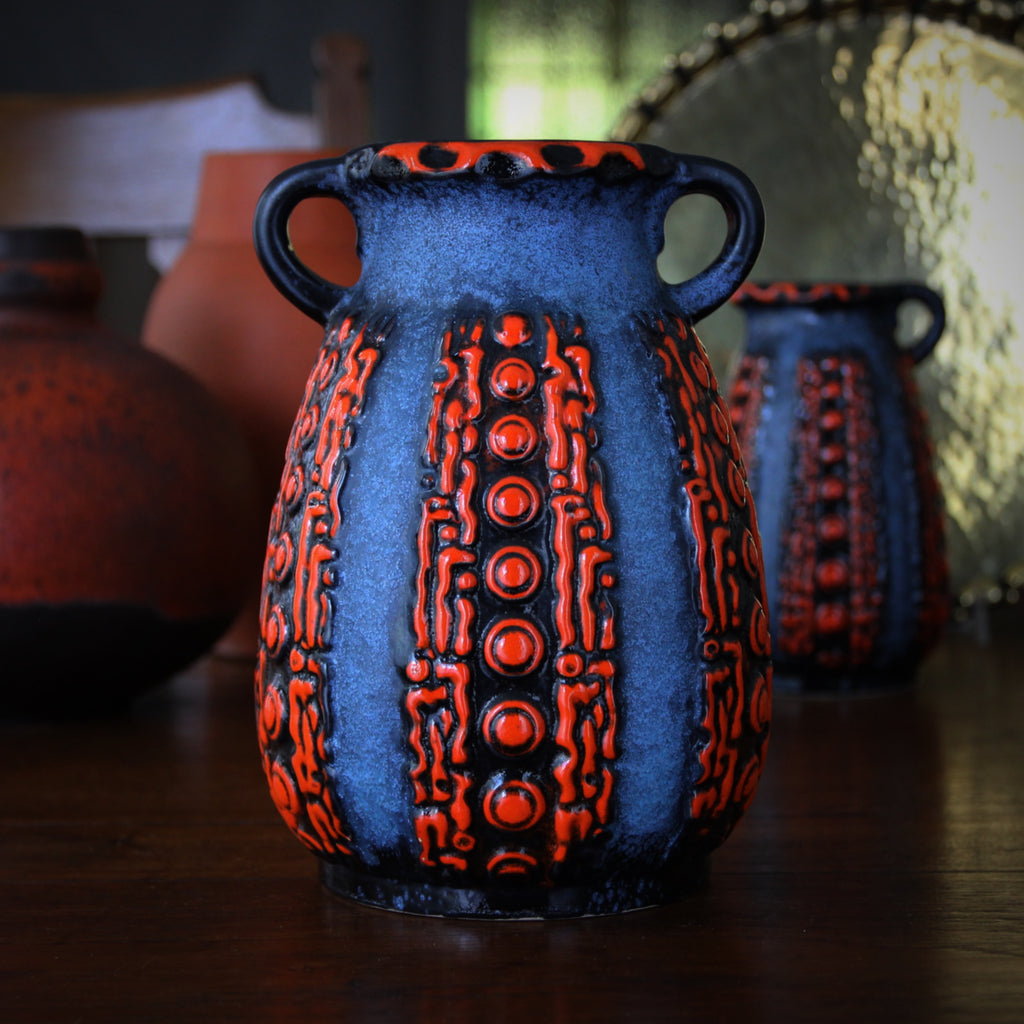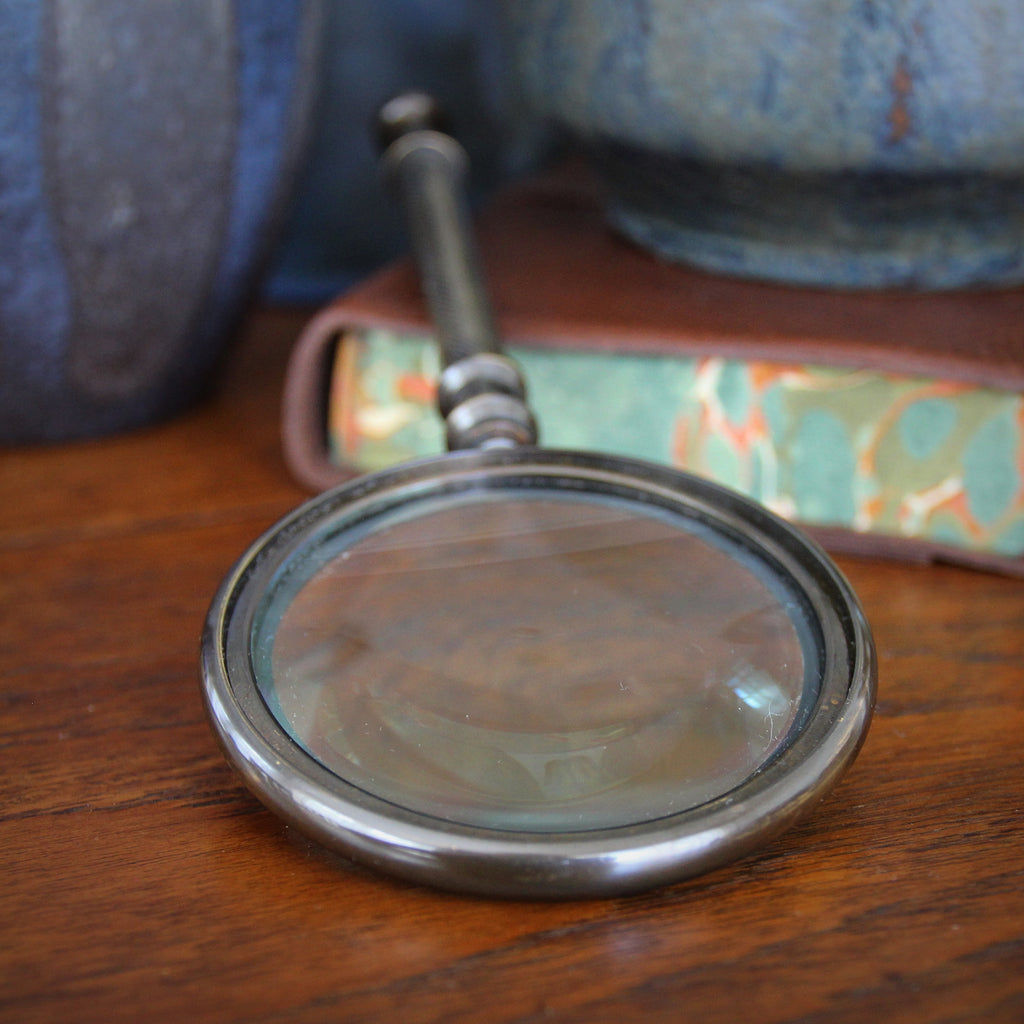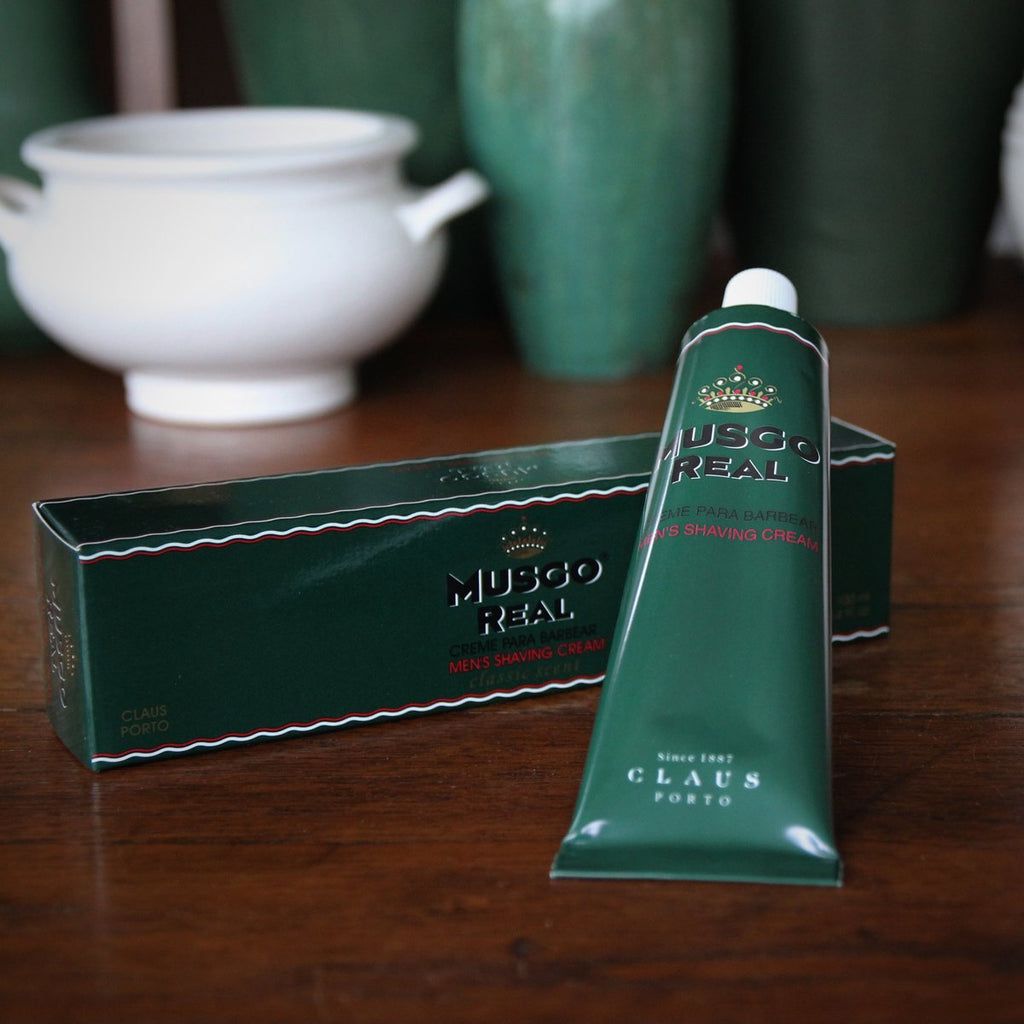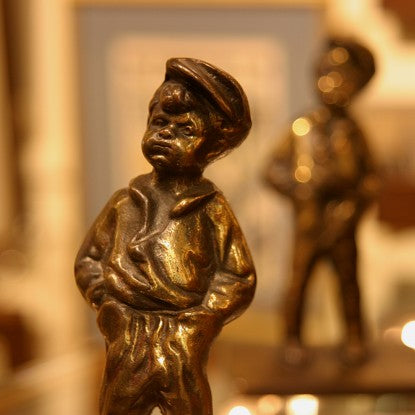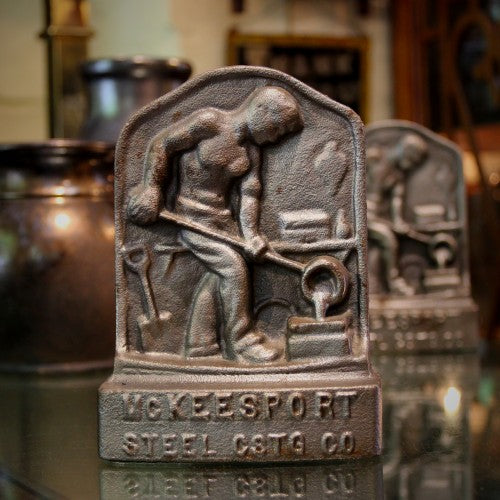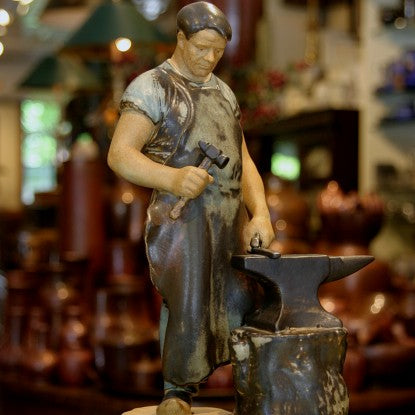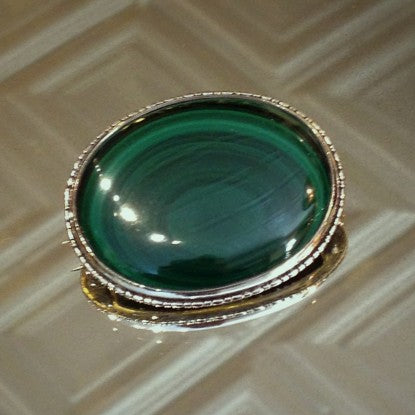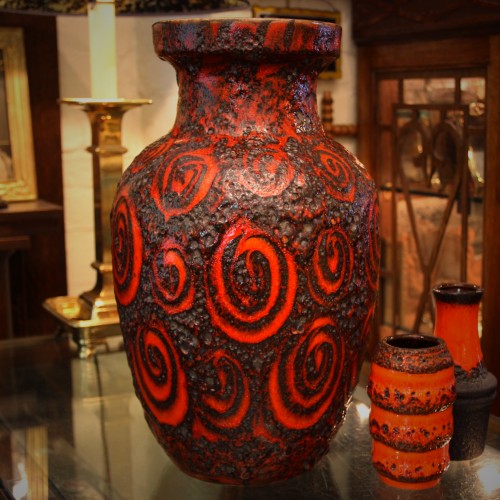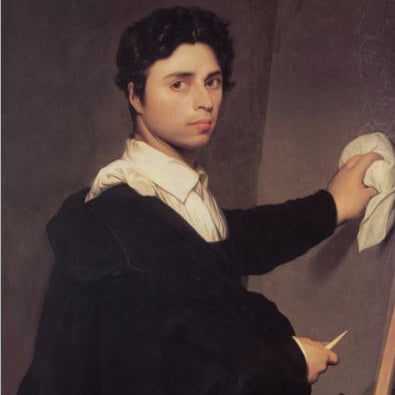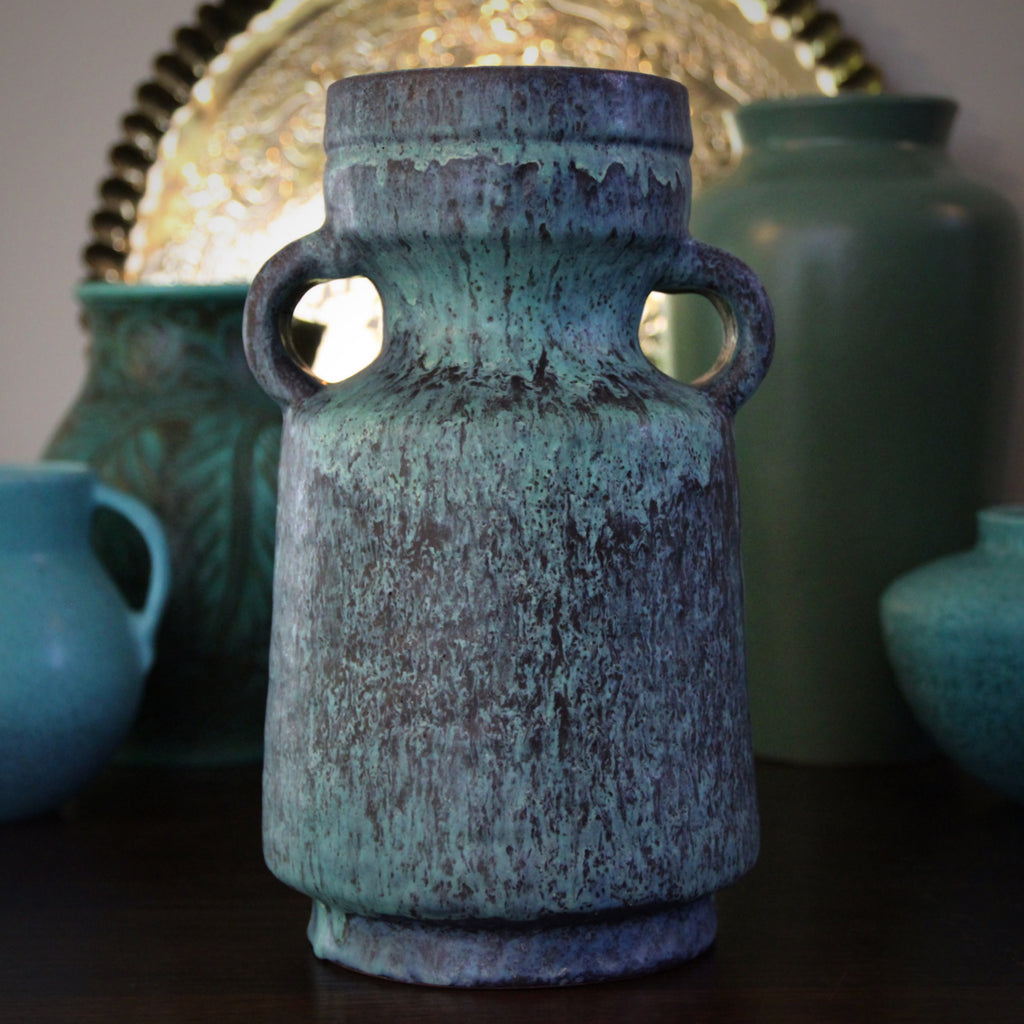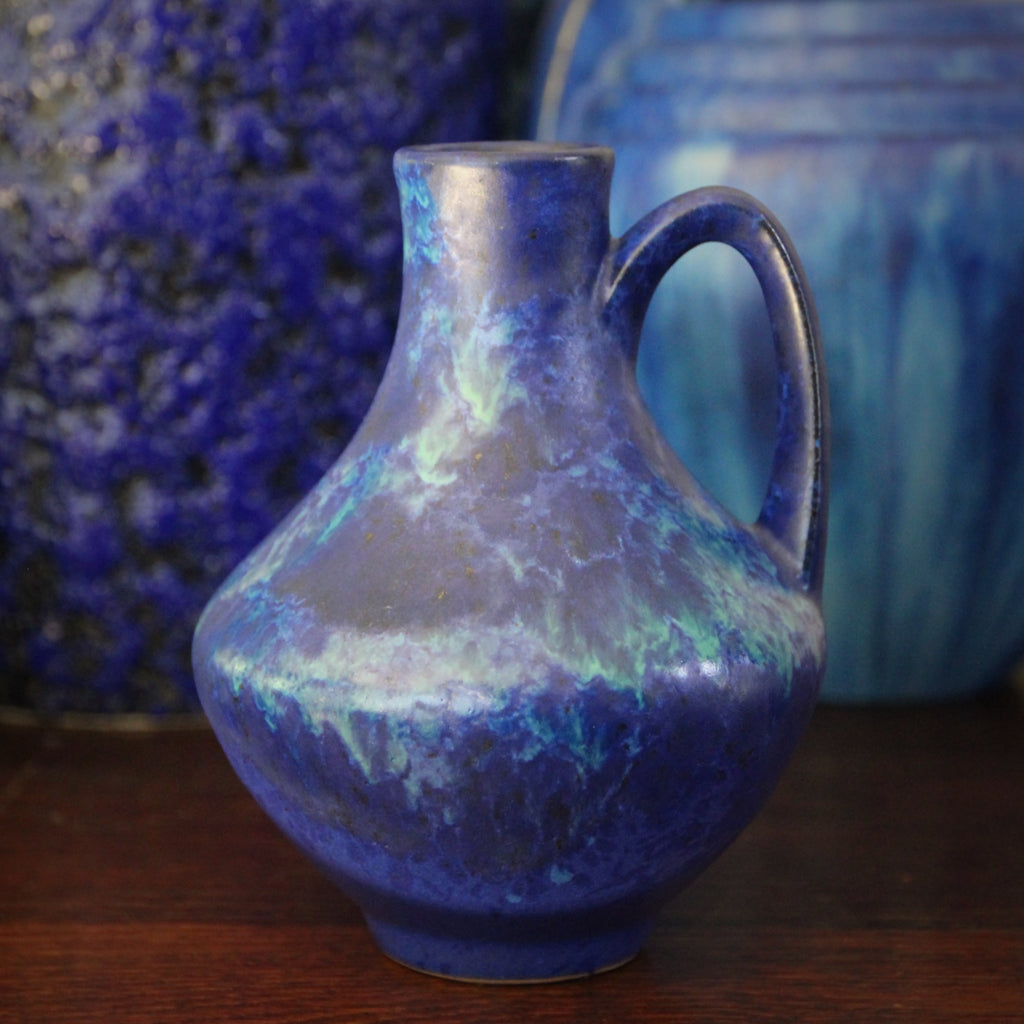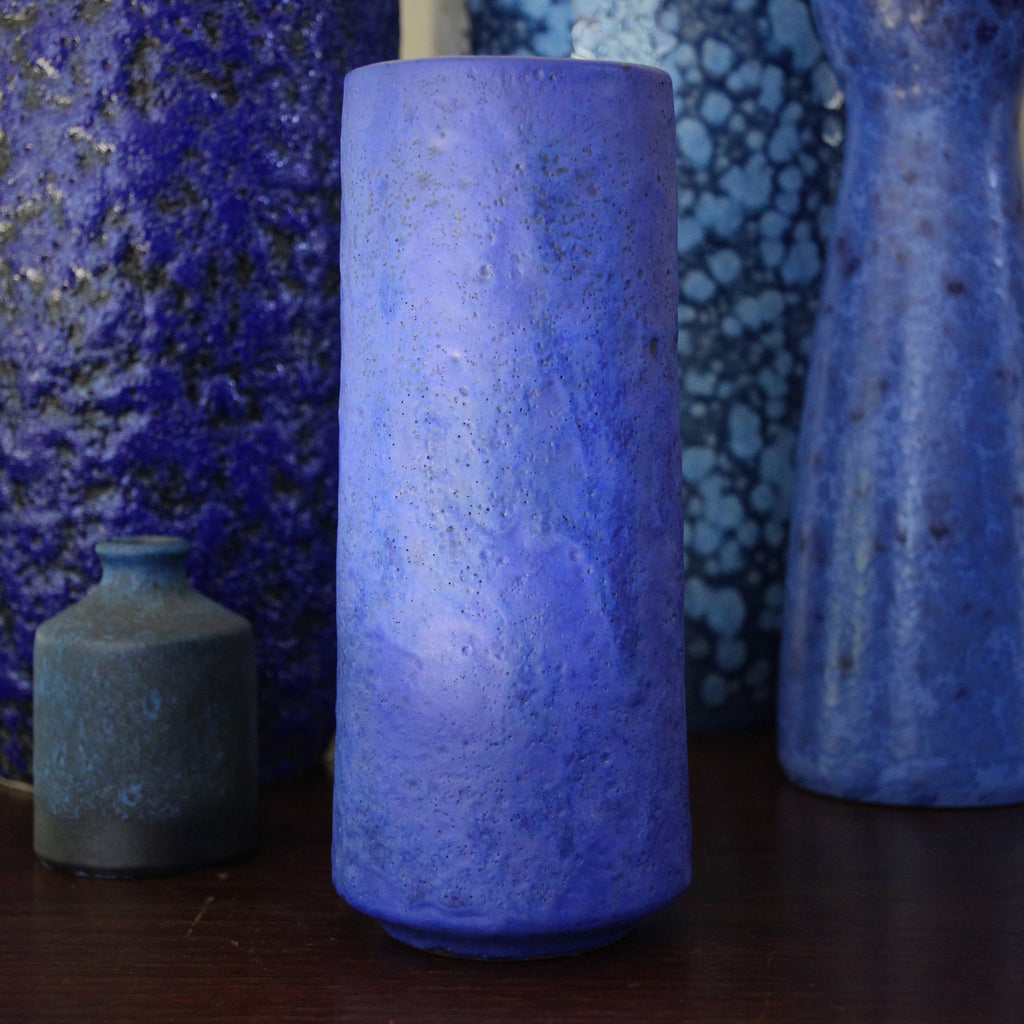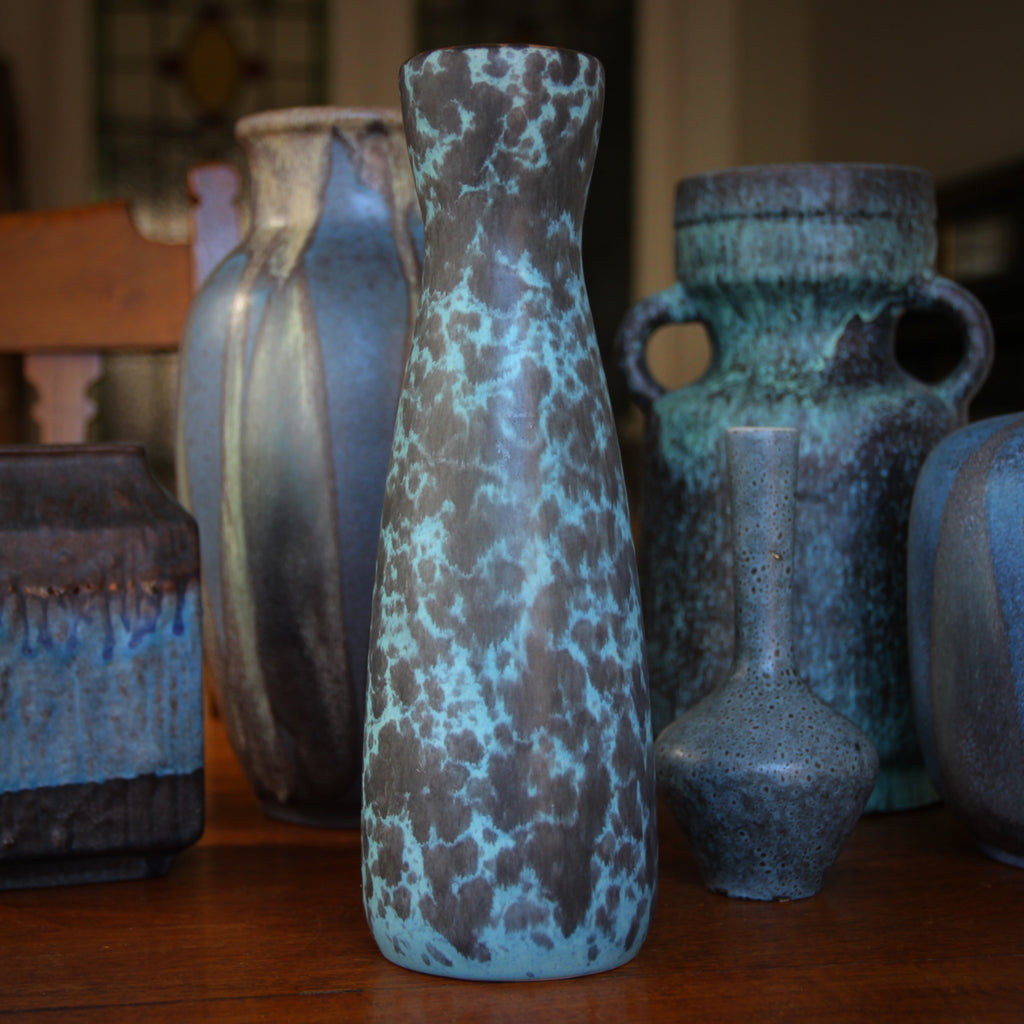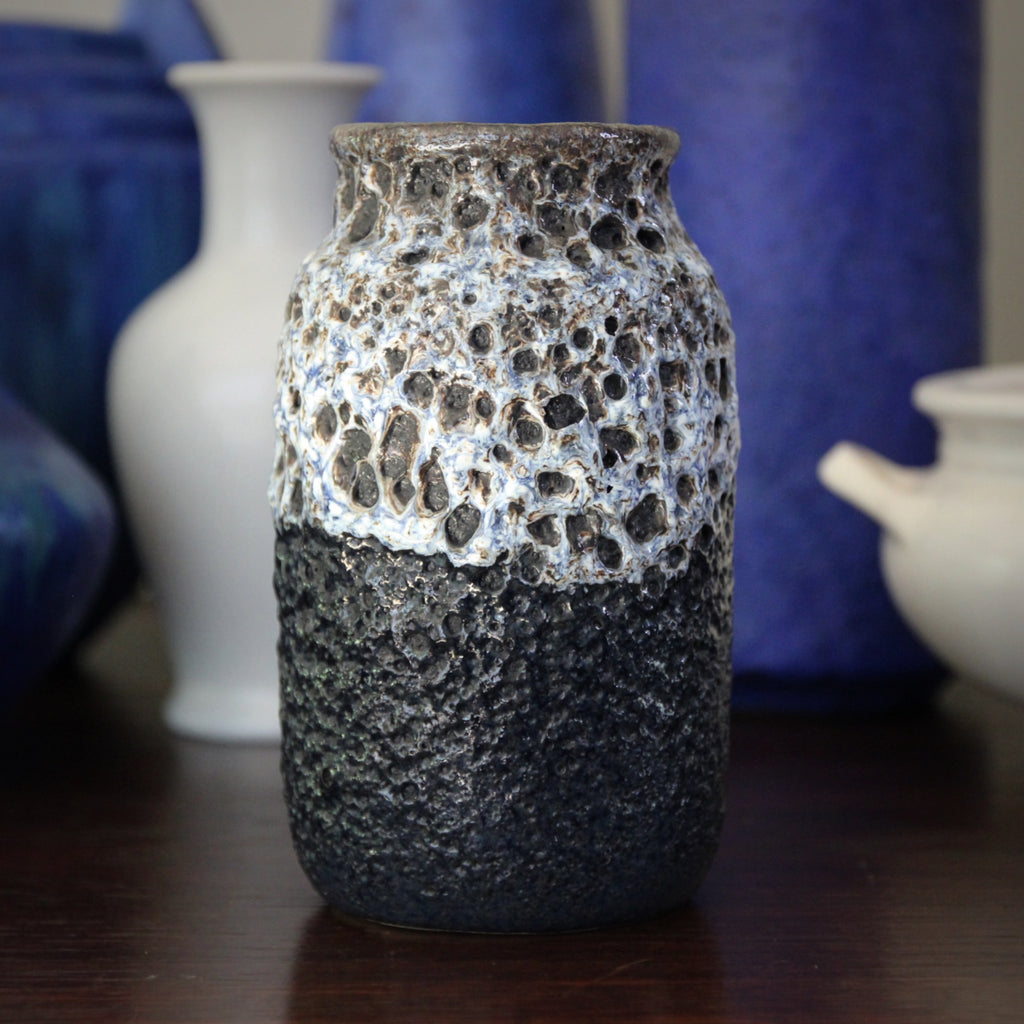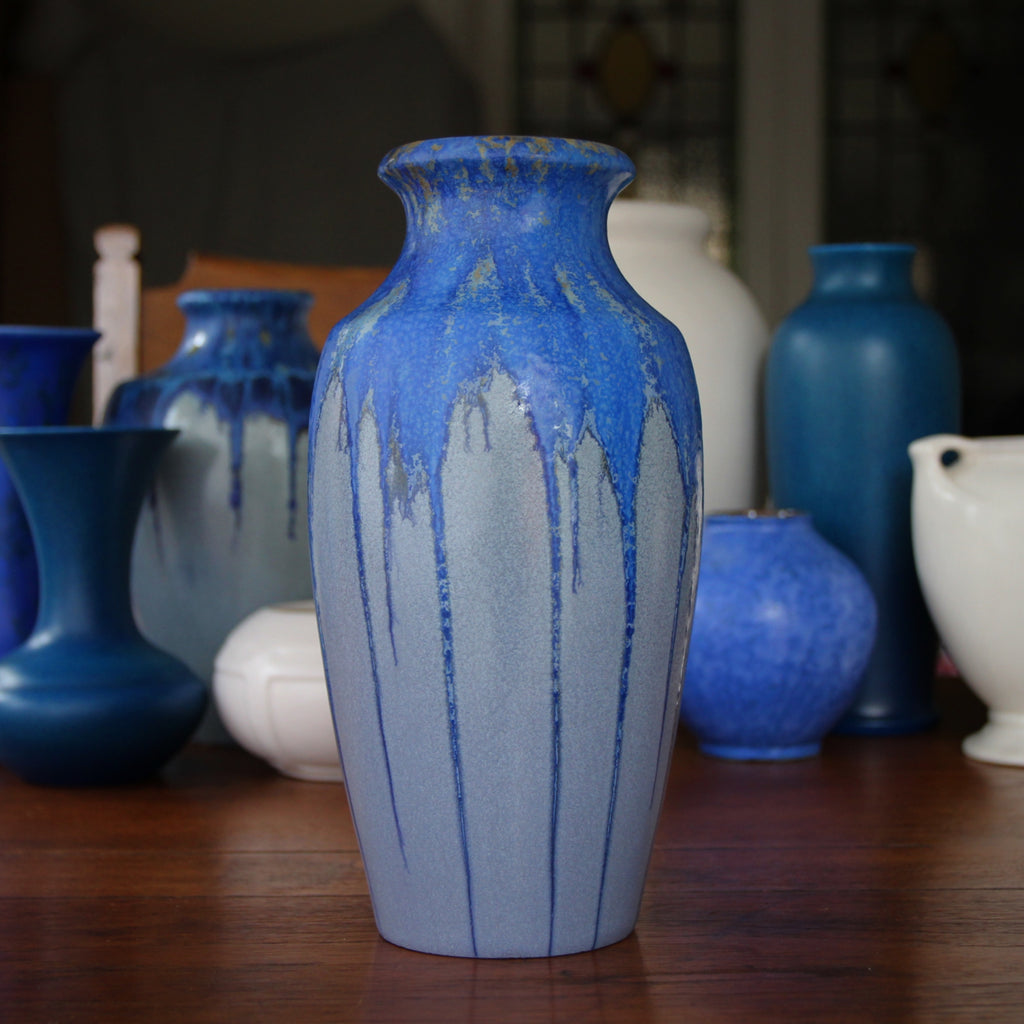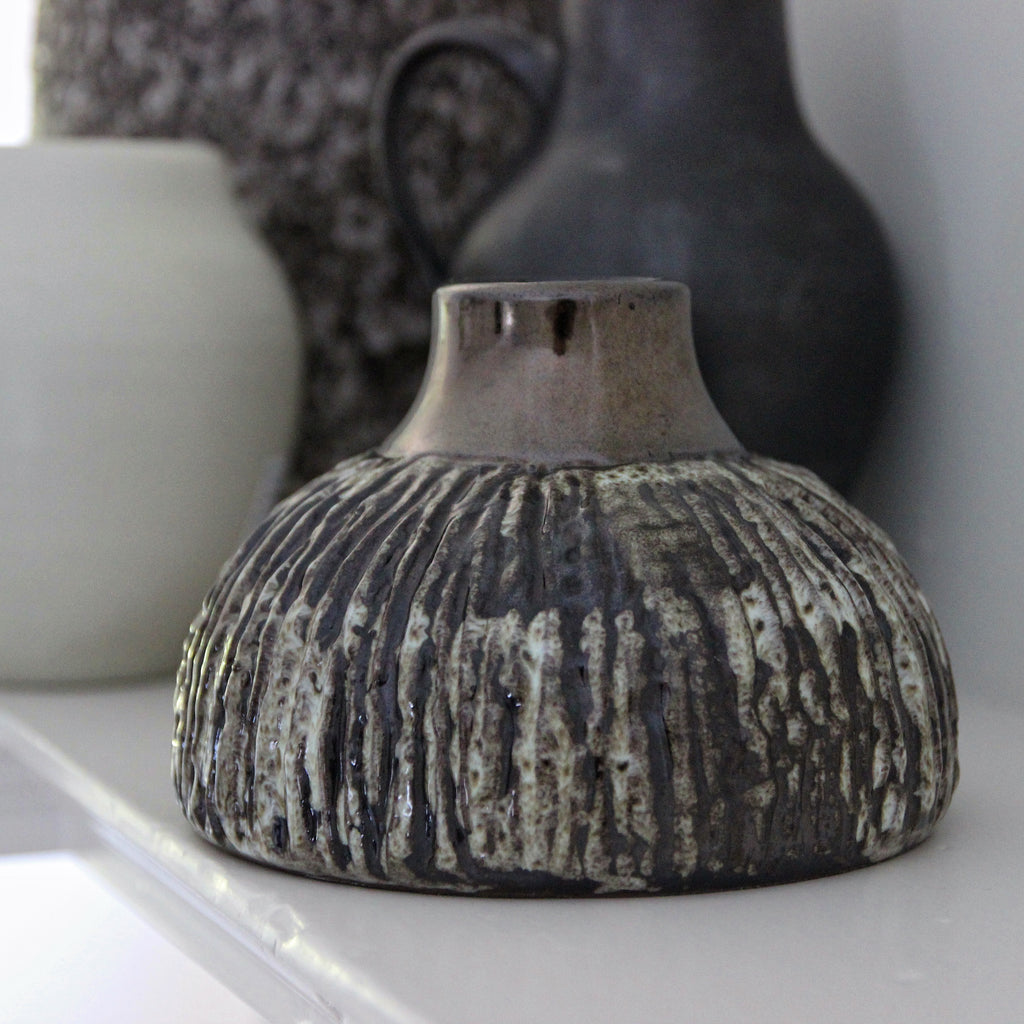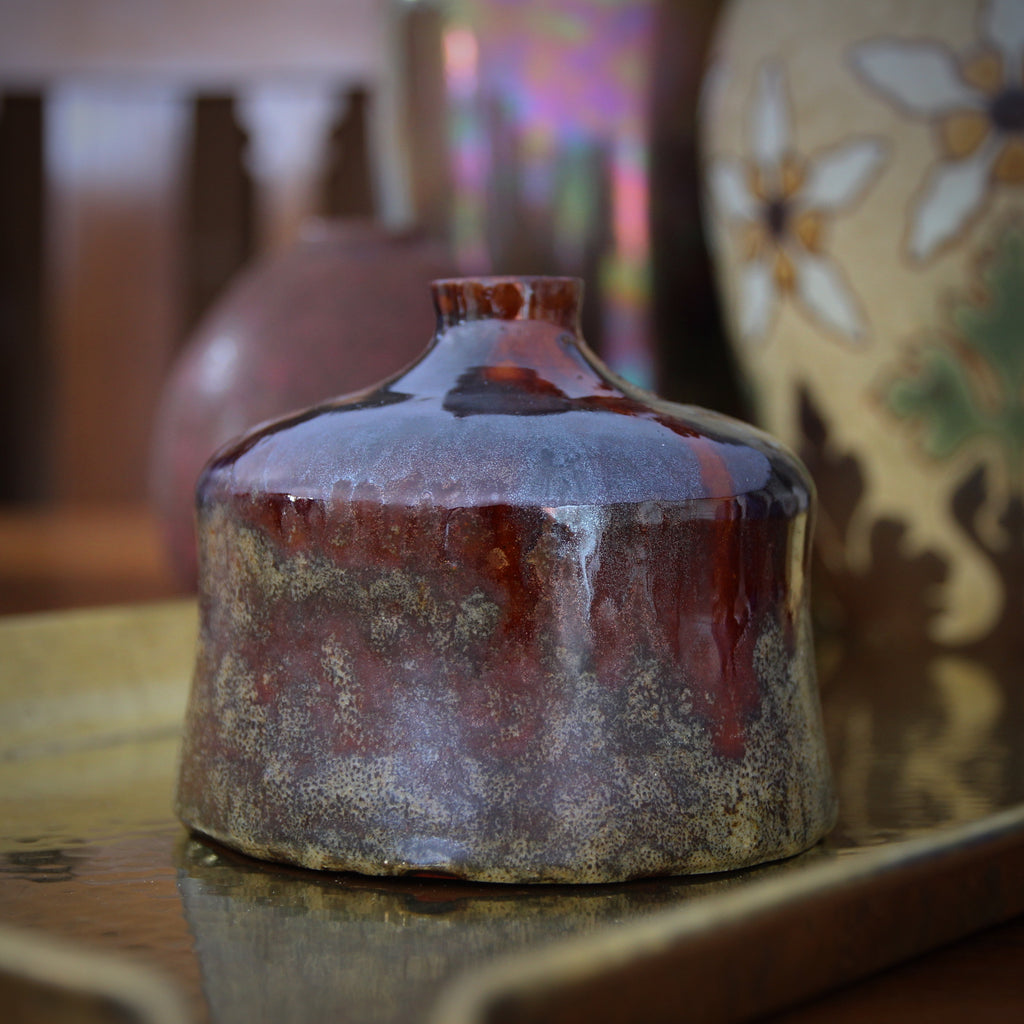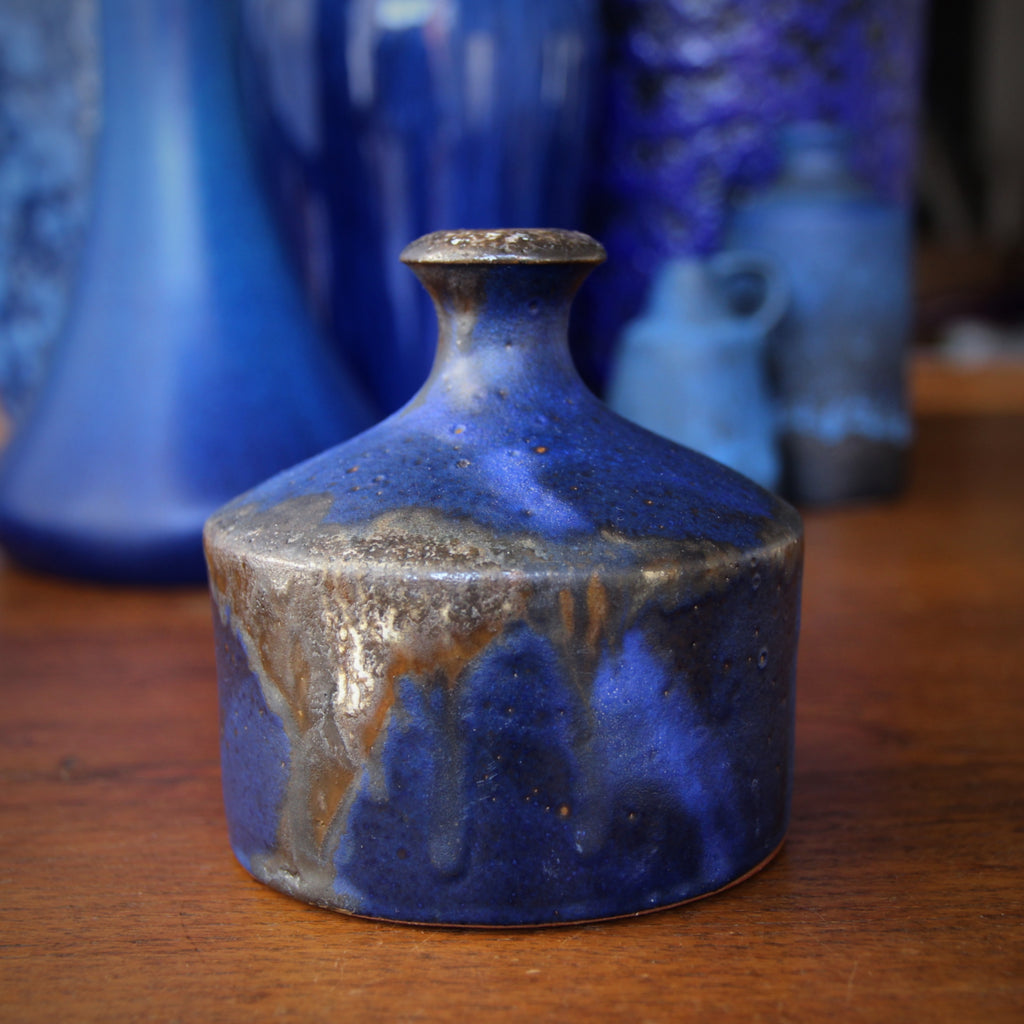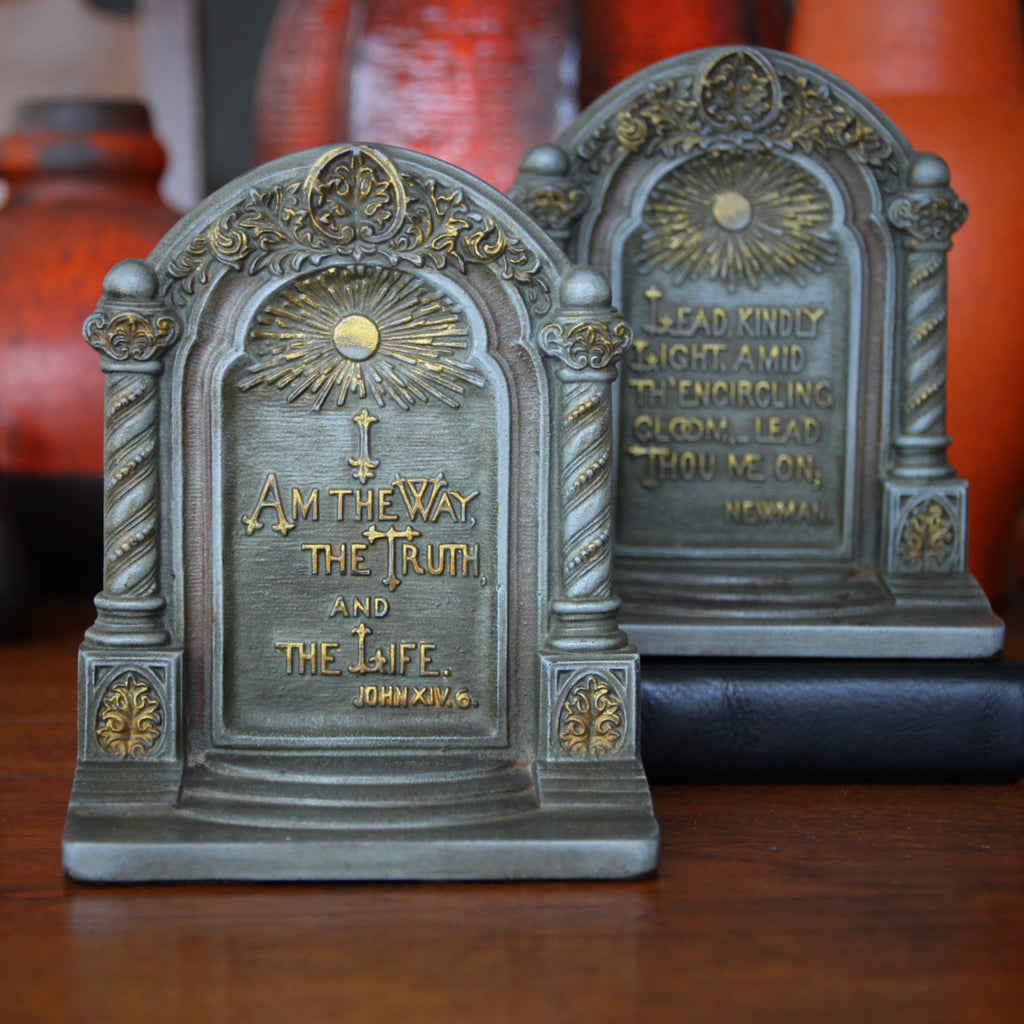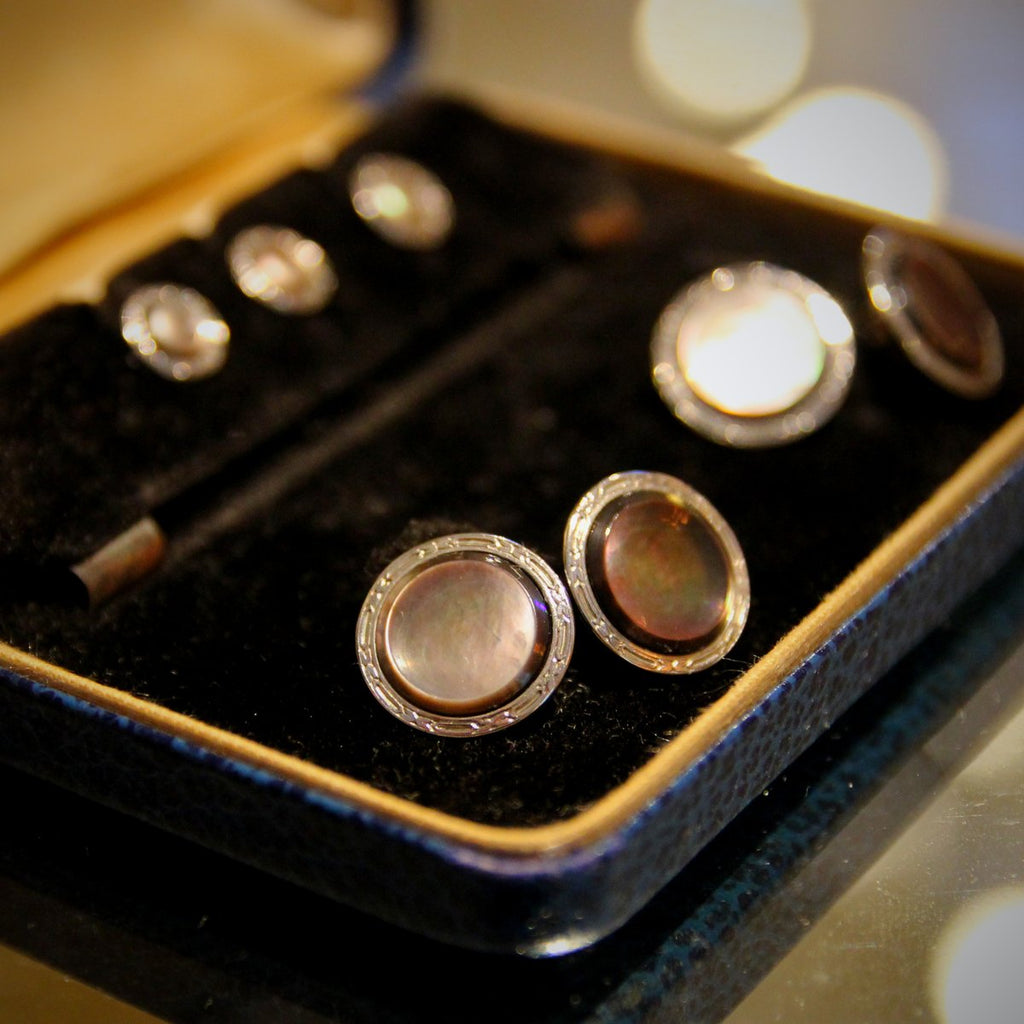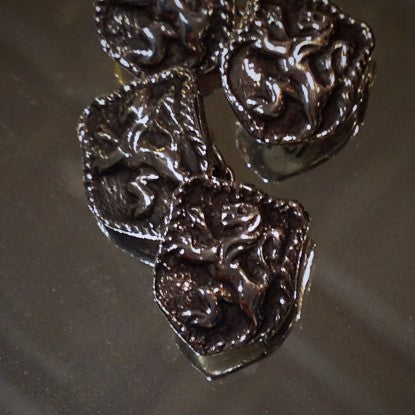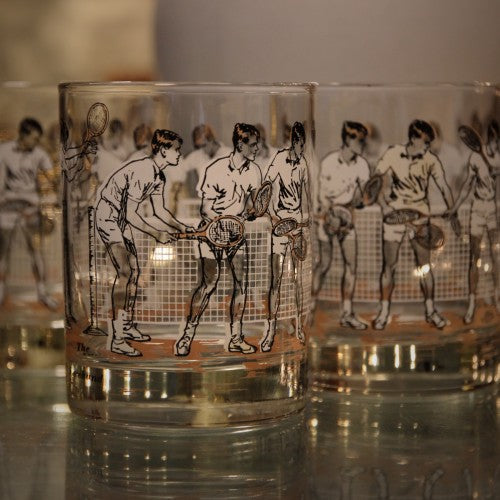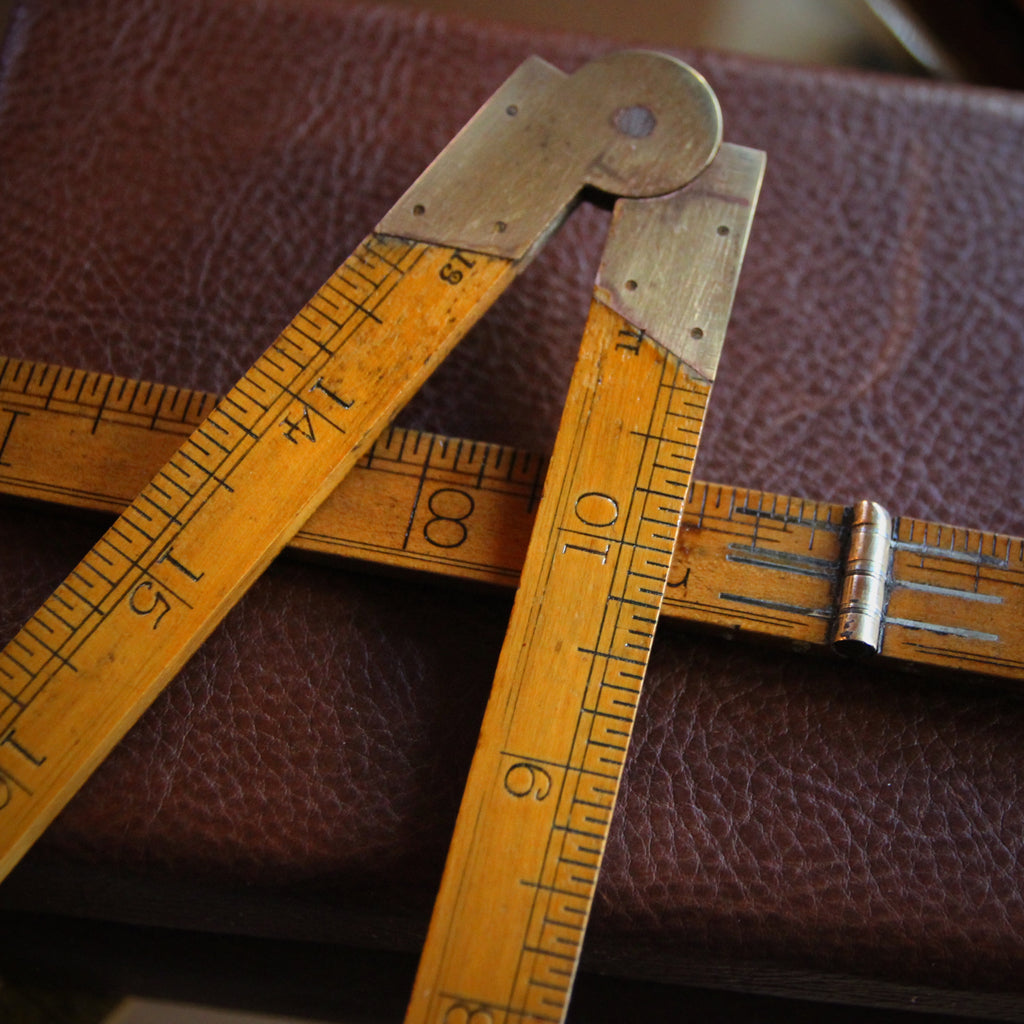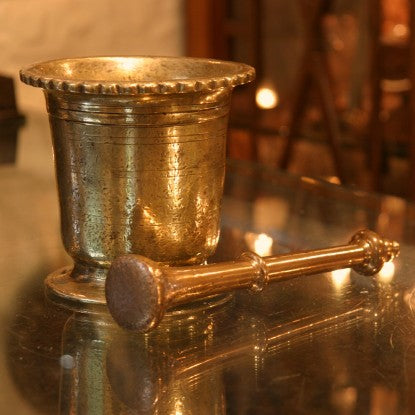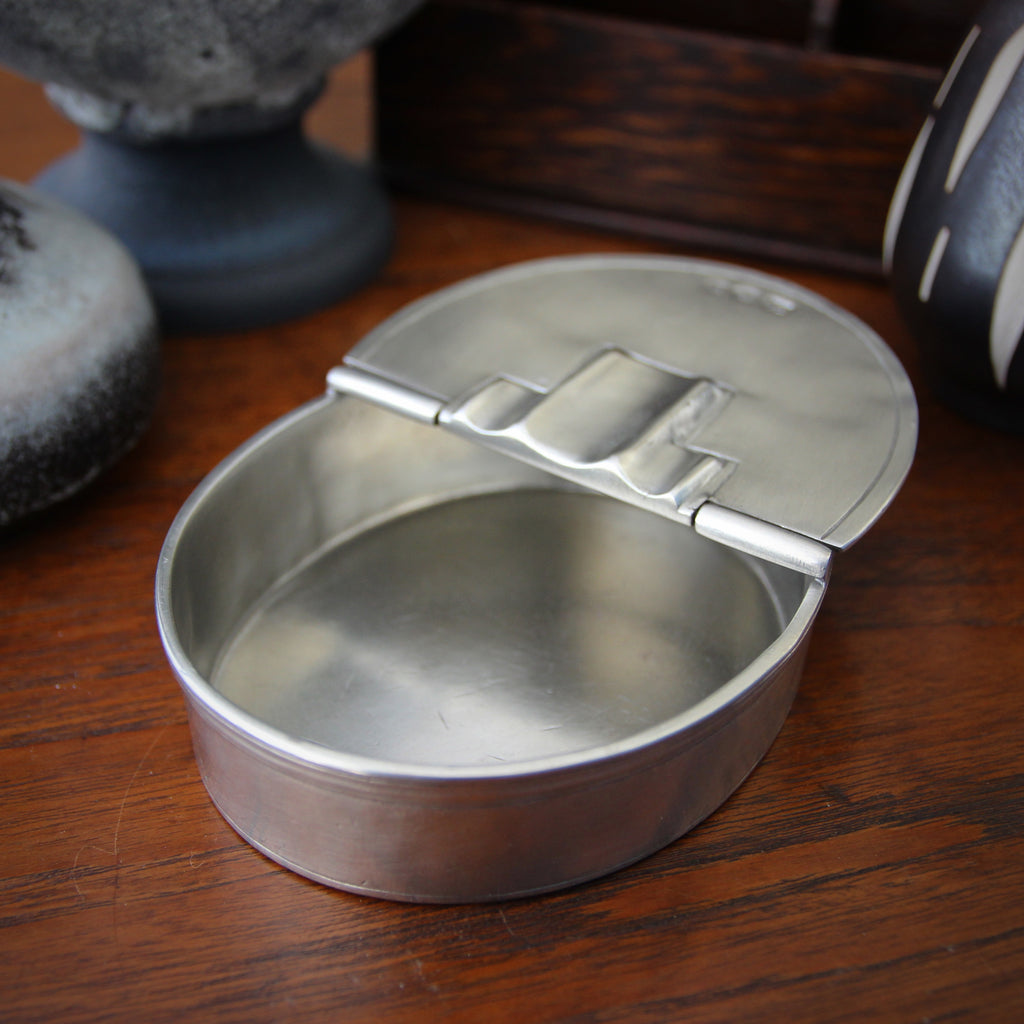JOURNAL RSS
This vase pleased me on first glance. Blues and browns, dripping glazes—these are a few of my favorite things. But, the more I contemplated the piece, the more I came to appreciate its wonderful artistry, its complicated coincidence. Where I once saw jagged bands, I began to see landscapes. Is that a sandy, desert mountain or a snow-covered Big Sky peak? Does the darkened treeline bound an icy lake? And is the midnight sky the same color as the lake—or just a little lighter? Sand, water, clouds and sky. This vase has it all! Please click on the photo above to learn more about it. LEO Design's Greenwich Village store is now permanently closed. While we contemplate our next...
Seasonally Suited
Whatever the season, this Rookwood Arts & Crafts turquoise vase will fit-the-bill. Think of springtime robins' eggs, summer skies, or wintery winds while gazing at the incised row of tulips—swaying gently in the breeze. Made in Cincinnati, Ohio in 1926. Please click on the photo above to learn more about it.
LEO Design's Greenwich Village store is now permanently closed. While we contemplate our next shop location, please visit our on-line store which continues to operate (www.LEOdesignNYC.com).
Follow us on Instagram: "leodesignhandsomegifts"
Follow us on Facebook: "LEO Design - Handsome Gifts"
Before You Know It
It's not too early to start planning for New Year's Eve! And this set of four champagne or cocktail stems from the Forties will have you ringing-in 2019 in style. Softly-faceted panels are finished with an iridescent wash—which will give an extra sparkle to your countdown bubbly. Please click on the photo above to learn more about them.
LEO Design's Greenwich Village store is now permanently closed. While we contemplate our next shop location, please visit our on-line store which continues to operate (www.LEOdesignNYC.com).
Follow us on Instagram: "leodesignhandsomegifts"
Follow us on Facebook: "LEO Design - Handsome Gifts"
Oh, Jerusalem!
For much of the world's population, religiously speaking, Jerusalem stands at the center of the world. I have visited this singular city and was amazed at how so many different people live so tightly together. Occasional tensions flare—sometimes very seriously. But, after thousands of years, the people mostly exist side-by-side, tolerantly and compatibly. Perhaps these Modernist olive parquet bookends, made in Jerusalem, can help illustrate the city's character: discrete, unique and separate individuals, though cobbled together, can maintain their identity while creating a greater (and beautiful) assemblage. Click on the photo above to learn more about them. LEO Design's Greenwich Village store is now permanently closed. While we contemplate our next shop location, please visit our on-line store which continues...
A Final Ray of Summer
One last glimpse of summer . . . with this Carstens vase from the 1970's. Bands of marigold glazing seem to fade quietly—like an imminent sunset—into bands of midnight brown. Certainly summer, though it's clear the season won't last much longer. Learn more about this handsome vase by clicking on the photo above.
LEO Design's Greenwich Village store is now permanently closed. While we contemplate our next shop location, please visit our on-line store which continues to operate (www.LEOdesignNYC.com).
Follow us on Instagram: "leodesignhandsomegifts"
Follow us on Facebook: "LEO Design - Handsome Gifts"
Longing for Summer?
Winter's chill has swept through the Northeast—and I already miss the summer! Not to worry, I can gaze at this sunny, summery vase, made by Carstens. Though German, it brings to mind a sunny, Positano terrace. It would also look quite-at-home centered in an impastoed Van Gogh sunflower masterpiece. Learn more about it by clicking on the photo above.
LEO Design's Greenwich Village store is now permanently closed. While we contemplate our next shop location, please visit our on-line store which continues to operate (www.LEOdesignNYC.com).
Follow us on Instagram: "leodesignhandsomegifts"
Follow us on Facebook: "LEO Design - Handsome Gifts"
Swords into Ploughshares
“Trench Art” was a form of folk art practiced by soldiers (or, sometimes, sailors) during World Wars I & II. Men on the front line would sometimes have long stretches of boredom, punctuated by sudden bursts of excruciating action. The artistically-inclined amongst them might spend their quiet hours crafting items (such as the vase, above) […]
The Song of Hiawatha
On 10 November 1855, the long-form poem “Song of Hiawatha” by Henry Wadsworth Longfellow was published. It proved popular, selling 50,000 copies within the next two years. While the poem is considered a masterpiece of American Romantic literature, it is not necessarily an accurate, historical rendering of Native American people and their lives. Nevertheless, the […]
Could Thin be Better?
Is a thin wallet better? In the case of this Italian leather billfold, you may think so. Hand-stitched tan calfskin is lined with a handsome (and classy) navy blue interior—just a small touch that demonstrates a lot of taste. Even more surprising is the butter-soft lambskin (in yellow) which lines the hidden cash pocket. Its streamlined silhouette makes it less-bulky, perfect for jeans or a fitted jacket. It's part of a small collection of leather goods, now showing in our on-line store. Please click on the photo above to learn more about it. LEO Design's Greenwich Village store is now permanently closed. While we contemplate our next shop location, please visit our on-line store which continues to operate (www.LEOdesignNYC.com)....
Island Maiden
A winsome dancer sways to the music on this pair of cufflinks made of Honolulu Rapid Transit tokens, first minted in the 1950's. Sterling silver mountings complete the assembly. Please click on the photo above to learn more about them.
LEO Design's Greenwich Village store is now permanently closed. While we contemplate our next shop location, please visit our on-line store which continues to operate (www.LEOdesignNYC.com).
Follow us on Instagram: "leodesignhandsomegifts"
Follow us on Facebook: "LEO Design - Handsome Gifts"
Thomas Nast and his Elephant
Thomas Nast was the popular and powerful cartoonist, lecturer, and political thinker of the American 19th century. He did much of his work for Harper’s Weekly in New York City. On this day in 1874, Nast introduced the Elephant as the symbol for the Republican party—a mascot which survives to this day. Nast has been […]
Vote for your Life!
It's easy to take one's democracy for granted. Many of us think it's "a permanent part of the scenery." But democracy hasn't always been a given—in fact, even today, many Americans struggle to cast their vote at the polls. In modern world history, democracy has been taken away from people who couldn't imagine it happening; citizens in Germany, Spain, Italy, Chile, Hungary, and many Eastern European nations lost their political voices (and many lost their lives). And lest one think that this only happened back in "the bad old days," the rise of anti-democratic factions is on the rise, worldwide. In America, though we are not immune from the Fascist manipulations of Nationalists, we do enjoy a history of embracing an...
Rusty Ruscha
It's like a cloudy day over The Red Planet, the handsome glazing on this Ruscha West German pitcher made by glaze master Otto Gerharz. It's part of a growing collection of "otherworldly" pieces I've been finding—ceramics pieces with interesting glazes reminiscent of faraway moons and planets (whether real or imagined). They are beautiful on their own, but I like to imagine them hanging in the futuristic scenic designs of some science fiction Star Wars movie. Click on the photo above to learn more about it. LEO Design's Greenwich Village store is now permanently closed. While we contemplate our next shop location, please visit our on-line store which continues to operate (www.LEOdesignNYC.com). Follow us on Instagram: "leodesignhandsomegifts" Follow us on Facebook:...
A King is Discovered
On this day in 1922, British archeologist Howard Carter uncovered the tomb of King Tutankhamun. Not only did this discovery set the scientific, historical, and archeological worlds ablaze, but it sparked a revival of “Egyptian Mania” in the decorative arts. “King Tut” took the throne at the age of 9 or 10 and held it […]
The Arno Rises
On this day in 1966, Florence's Arno River began to rise—and, by the next day, had surpassed its banks, flooding parts of the Renaissance city with as much as 22 feet of water. It was the worst flood in over 500 years and countless priceless artworks, books and buildings were damaged or destroyed. Among the lost treasures was the little ceramics workshop, Fratelli Fanciullacci, first established in the mid-Nineteenth Century. The studio lost most of its equipment, molds, kilns and tools. It lost most of its stock—that which was in-production as well as that which was finished and awaiting shipment to the U.S. and the rest of Europe. Most critically, the workshop lost its talented crew of artisans—who could not...
Oaken Satisfaction
This handsome business card case must be held to be fully appreciated! Japanese oak is hand-shaped to a softly-tapered point (see the reflection in the photo) and lacquered to a warm, wooden glow. It feels wonderful in the hand—silky, precise— and the magnetic latch closes the hinged lid with a soft and satisfying snap. It's certain to catch an admiring eye, sliding out of a tailored jacket's breast pocket. Please click on the photo above to learn more about it.
LEO Design's Greenwich Village store is now permanently closed. While we contemplate our next shop location, please visit our on-line store which continues to operate (www.LEOdesignNYC.com).
Follow us on Instagram: "leodesignhandsomegifts"
Follow us on Facebook: "LEO Design - Handsome Gifts"
Sun Sign Scorpio
Autumn brings us Halloween, chilly nights, and the sun sign Scorpio—23 October through 22 November. Born in the eighth sign of the zodiac, Scorpios are known for their passion, sensuality, and dynamism—characteristics which make them admired as lovers. Alas, deeply-rooted intensity can express itself as jealousy, possessiveness and manipulation. The carved and polychromed wooden plaque, […]
All Hallows’ Eve
All Hallows’ Eve (or Hallowe’en) means “Holy Night” and was first celebrated in Western Christian countries on the night before All Saints’ Day—1 November. Hallowe’en is actually just the first day of a longer, three day “triduum” called Allhallowtide—comprising All Saint’s Day (1 November), its vigil (31 October) and All Souls’ Day (2 November). Pope Gregory […]
Halloween Eve
With one night left, let's get into a Halloweeny mood with this textured, matte orange vase by Scheurich. Two vibrant shades of orange create a dappled surface on this rounded cylindrical vase—which is topped with a short, corseted neck. It is sure to make an impression—by itself or as part of a larger collection—and you can learn more about it by clicking on the photo above.
LEO Design's Greenwich Village store is now permanently closed. While we contemplate our next shop location, please visit our on-line store which continues to operate (www.LEOdesignNYC.com).
Follow us on Instagram: "leodesignhandsomegifts"
Follow us on Facebook: "LEO Design - Handsome Gifts"
Bronze Refinement
Before the advent of cartridge ink pens (or ball point pens), writing was a messy ordeal. Writers greeted you with blackened fingers and newspaper writers were called "Ink-Stained Wretches." What to do if you were an educated gentleman? You wanted to (or needed to) write—but you preferred to maintain a gentlemanly nattiness. (Not to mention preserve your expensive leather-topped desk). Enter the pen tray! Here one could keep one or more inky pens—close-at-hand but securely cradled. This footed pen tray, made in late Nineteenth Century France, is crafted of cast bronze and decorated with sensuous botanical scrollwork and regimented triangular edging. And, if inky messes are no-longer a common occurrence on your desk, these pen trays are perfect holding...
The Other East
West German ceramics is interesting and collectible. I've been buying and selling it for years. But I still get a special thrill when I pick-up a piece of East German pottery. And I can't help but think of the talented ceramics artists who just happened to end up on the wrong side of the daunting Berlin Wall. It seems East German designs have a cooler, greyer, more dour-looking aesthetic than their West German cousins. And, perhaps because East Germany was cut-off from the Modernist art world of the late Mid-Century, their interpretations seem more informed by the early Modernism at the turn of the Twentieth Century. That puts their mindset right into my decorative sweet spot! The piece above, made by Veb Lausitz in...
"It's Lonely Out In Space..."
A couple of weeks ago, I had the great pleasure of seeing Elton John in Pittsburgh—one of the stops on his "Farewell Yellow Brick Road" world tour. Naturally, he sang "Rocket Man" among the many hits he performed that night. In recent years, I've found myself intrigued by (and collecting) ceramics pieces which bear a resemblance to faraway planets or moons—whether actual or fanciful. This piece, made by Steuler in West Germany, has a glaze which brings to (my) mind an otherworldly, gaseous planet, perhaps one hanging in the background of a rough-and-tumble Star Wars set piece. "D'you pack your bags last night, pre-flight?" Please click on the photo above to learn more about it. LEO Design's Greenwich Village store...
French Classic
Here' another handsome piece by French knife-maker Laguiole. The hand-forged stainless steel knife is clad in white cow horn (which has the look of ivory) and is capped with polished stainless steel bolsters. Of course, the knife is finished with the classic hand-chiseled bee (and spine) and it displays the stainless pins which form a stylized cross on one side. Please click on the photo above to learn more about it.
LEO Design's Greenwich Village store is now permanently closed. While we contemplate our next shop location, please visit our on-line store which continues to operate (www.LEOdesignNYC.com).
Follow us on Instagram: "leodesignhandsomegifts"
Follow us on Facebook: "LEO Design - Handsome Gifts"
James B. Longacre, Artist
James Barton Longacre was born in 1794 in Delaware County, Eastern Pennsylvania. His mother died when he was young and he ran away to Philadelphia at the age of 12—unable to abide his new stepmother. He was taken-in by the family of a Philly bookseller and given an apprenticeship working in the bookshop. But young James displayed a talent for portraiture so the shopkeeper released him of his apprenticeship which allowed him to work for an engraver. In a recess appointment by U.S. President John Tyler, Longacre was appointed Chief Engraver for the Philadelphia Mint in 1844, a position he held until his death in 1869. He was a prolific designer of many coins, including the iconic "Indian Head" penny (produced from...
Shingle. Tingle.
A rich orange glaze flows down, over the staggered arrangement of "fish scale" decor—reminiscent of the shingled roof of a faraway land of make believe. It was crafted by Jasba in the 1960's or 1970's and you can learn more about it by clicking on the photo above.
LEO Design's Greenwich Village store is now permanently closed. While we contemplate our next shop location, please visit our on-line store which continues to operate (www.LEOdesignNYC.com).
Follow us on Instagram: "leodesignhandsomegifts"
Follow us on Facebook: "LEO Design - Handsome Gifts"
Florentine Beauty
Hand-impressed "divots" are created with a wooden stylus—giving this two handled urn the appearance of a stylized strawberry ("fragola" in italiano). It was handmade by the Florentine pottery workshop Fratelli Fanciullacci in the 1960's. Although the studio was founded in the 19th century, the Brothers Fanciullacci were at the leading edge of Post-War Italian Modernist ceramics in the Mid-Century. Modernist ceramics master Aldo Londi worked for Fratelli Fanciullacci before joining Bitossi after World War Two. Alas, the workshop was severely damaged during the flooding of the Arno River in 1966. The company lost most of its stock, equipment, paperwork and artisans (who were forced to move-on to other work while the ceramics studio attempted to regroup). Although Fratelli Fanciullacci did...
Top of the Liszt
On this day in 1811, musical genius Ferencz Liszt was born in the Hungarian village of Doborjan—at the time part of the Austro-Hungarian Empire and today a part of modern Austria. Ferencz (called "Franz" in English) was attentive to his musician father's practicing. By seven, he was beginning piano lessons, by eight he was crafting simple compositions, and by nine he was performing concerts. After hearing the prodigy play, a group of wealthy music patrons agreed to finance Franz's musical education in Vienna—the capital city of the Austro-Hungarian Empire. Liszt spent the rest of his boyhood studying, composing and touring. When his father died in 1827, the 16 year old Franz quit touring, moved with his family to Paris, and began...
The Battle of Trafalgar
On this day in 1805, England savored one its greatest military wins in history—defeating the combined navies of France and Spain. In the Battle of Trafalgar, led on the British side by Admiral Horatio Lord Nelson, the French and Spanish lost 22 ships; England lost none. The win was so decisive, it changed the trajectory […]
"Vin, S'il Vous Plaît."
Laguiole is a village of some 1,200 in South-Central France, known for its distinctive cheese and excellent knives. The first Laguiole knife was crafted in 1829 and became popular with farmers and shepherds. In fact, the decorative "pins" in the body of the knife are inserted in the form of a cross—and Catholic shepherds (tending their sheep, far from home or church) used to stick their knife blades upright, into the earth, to form a makeshift prayer altar. Alas, Laguiole was not disciplined about trademarking or protecting its esteemed name. As a result, poor-quality knockoffs (usually from Asia) have flooded the market under the Laguiole name. Rest assured, we only sell the best Laguiole products, made in Laguiole, France. The sommelier, shown...
Skin of Armor
From a collection of American alligator wallets, now in-stock at LEO Design: a slim, bi-fold credit card wallet. Its svelte profile is perfectly tailored for streamlined dressing and its natural, hand-rubbed finish will develop a beautiful, soft sheen with continued use. The alligators are farmed in Florida and Louisiana, and the wallets are hand-stitched in New England. It's one of many wallet styles, now to be found in our on-line shop. Please click on the photo above to learn more about this one. LEO Design's Greenwich Village store is now permanently closed. While we contemplate our next shop location, please visit our on-line store which continues to operate (www.LEOdesignNYC.com). Follow us on Instagram: "leodesignhandsomegifts" Follow us on Facebook: "LEO Design...
Call Me Ishmael . . .
“Call me Ishmael,” is perhaps the most famous opening line of any American Novel yet written. On this day in 1851, The Whale, by Herman Melville, was published by Richard Bentley in London. A few weeks later, it was published in New York under the name Moby Dick; or, The Whale. Although it was met with lukewarm […]
One's Heart on a Sleeve
If you've left your heart in The City by the Bay, perhaps this handsome pair of cufflinks will ease the ache. Vintage San Francisco transit tokens—first minted in 1945—are set in sterling silver mounts. You can celebrate that wonderful city—and look great doing it. Please click on the photo above to learn more about them.
LEO Design's Greenwich Village store is now permanently closed. While we contemplate our next shop location, please visit our on-line store which continues to operate (www.LEOdesignNYC.com).
Follow us on Instagram: "leodesignhandsomegifts"
Follow us on Facebook: "LEO Design - Handsome Gifts"
Birth of a Hero
On this day in 1854, Irish wit, playwright, bon vivant—and hero—Oscar Wilde was born. He is best known for his brilliant (and successful) late-Victorian “society” plays which include The Importance of Being Earnest, Lady Windemere’s Fan, A Woman of No Importance, and An Ideal Husband—plays which are still performed worldwide to this day. He wrote The Picture […]
Feast of Saint Teresa
The Ecstasy of St. Teresa by Gian Lorenzo Bernini (1647-52) Saint Teresa of Avila was born in Gottarrendura, Spain in 1515. After a rather normal girlhood, Teresa lost her mother, plunging the 14 year old girl into profound sadness. She developed a strengthened devotion to Mary but also took solace in “frivolous” books about knights, […]
For "Holly and the Ivy"
Foamy white tendrils—like the legs of a ghostly octopus—creep over the globular form of this dark brick red vase. Made by Steuler in the 1960's or 1970's, it would make a nicely-understated Holiday centerpiece—filled with sprigs of holly, pine & ivy, fluffy white flowers or brilliant red blossoms. Please click on the photo above to learn more about it.
LEO Design's Greenwich Village store is now permanently closed. While we contemplate our next shop location, please visit our on-line store which continues to operate (www.LEOdesignNYC.com).
Follow us on Instagram: "leodesignhandsomegifts"
Follow us on Facebook: "LEO Design - Handsome Gifts"
Picking-up the Pace
Here's a bold piece, made by Stangl in the 1930's. Two architectural handles punctuate the strong Art Deco form—which further pops with a glazing of vivid orange. Johann Stangl worked for Fulper Pottery (in Flemington, NJ) from 1910. At the time, the company was known for its pricey Arts & Crafts "studio" ceramics—art quality pieces, tastefully designed and laboriously hand-crafted. Johann Stangl became president of the company in 1926 and, three years later, changed the company's name to Stangl Pottery. Johann embraced the new Art Deco movement, and re-calibrated the company away from expensive, low-volume studio pieces and toward popular-priced, high-volume production which would meet the needs of a growing middle-class, post War market. The piece above would surely make a...
Wine, Women, and Song
In Munich, Germany, on this day in 1810, Crown Prince Ludwig of Bavaria (who would later became King Ludwig I of Bavaria) married Princess Therese of Saxe-Hildburghausen. In celebration of the event, the citizens of the city were invited to celebrate in the fields in front of the city’s gates. And, thus, was born Oktoberfest—the […]
Prinknash Abbey
The Prinknash Abbey (pronounced "Prinish") has been associated with the Roman Catholic Benedictine order since its founding in 1096. When Henry VIII suppressed (and took) the abbey in 1539, he rented it to a wealthy supporter—sometimes using it himself as a hunting lodge. For the next 400 years, various aristocratic families lived on the property until the property was returned to the Benedictines (in 1928) who moved-back, converting the large home into a monastery. In 1942, while excavating for construction work, a seam of red clay was discovered and the monks began to make and sell pottery to support the abbey. Today the abbey no longer produces ceramics works. They continue to "blend" incense (using Arabian frankincense gum, essential oils and spices) which...
Arts & Crafts—Refreshened
My heart belongs to the Arts & Crafts period—which starts in the late Nineteenth Century and ends with (or shortly after) World War One. That said, I do appreciate certain Modernist pieces, especially when they "lean back" (not forward) and exhibit a high degree of handwork, craftsmanship or organic spontaneity. I also think that traditional Arts & Crafts interiors can be wisely-punctuated with a few sensational, well-chosen Modernist pieces (as long as they stay true to the principles of beauty, nature and craftsmanship). The piece above is a good example. Made in the 1950's by Wendelin Stahl, its somewhat severe bottle form is softened with blooms of sapphire crystals which burst forth, seemingly randomly. Stahl had a rather small studio in the...
Leif Erikson Day
In 1925, President Calvin Coolidge—standing before a crowd of 100,000 at the Minnesota State Fair—declared that Norse explorer Leif Erikson was the first European to set foot in North America, 500 years before Columbus. Shortly thereafter, 9 October was declared Leif Erikson Day. Leif Erikson was (thought to have been) born in Iceland around the […]
Tourmaline for October
People born in October may choose between two birthstones: the opal or the tourmaline. Tourmalines were first mined in Ceylon (now called Sri Lanka) and shipped to Europe in vast quantities by the Dutch East India Company in the 1600's. At the time, they were considered an exotic luxury. Subsequently, they have been found in Brazil, Africa, Afghanistan and the United States. They come in a variety of colors and some of them have magnetic qualities, due to the iron content in some examples. The Art Deco pot, shown above, is magnetic in appearance alone. It was made by Roseville in the 1930's and its shape was inspired by classic Native American ceramics. The glazing was named "Tourmaline," though it has...
Now and Forever
On this day in 1982, Andrew Lloyd Webber’s musical, Cats, opened on Broadway at the Winter Garden Theatre. The work, based on T. S. Eliot’s 1939 work “Old Possum’s Book of Practical Cats,” ran for nearly 18 years—making it the longest-running Broadway musical at the time. Directed by theatre legend Trevor Nunn and choreographed by […]
German-American Day
On this day in 1683, thirteen German families landed in Philadelphia, PA, soon to found Germantown, PA. The day was commemorated through the Nineteenth Century, only falling-out of favor during World War I. In 1983—on the 300th anniversary of the landing—the date was revived and designated officially as a day to honor the contributions of […]
And a Literary Genius, Too
And speaking of artistic geniuses, let’s not forget “The Bard,” William Shakespeare (1564 – 1616). Perhaps the world’s greatest playwright—of all time—his plays have influenced many other written works, have been adapted into musicals and operas, and have made a profound contribution to the spoken English language. The bookends above, made by Bradley & Hubbard […]
Greatest. Artist. Ever.
The World is full of wonderful art—of varying (and disparate) eras, materials and aesthetics. How can one possibly identify an all time favorite artist—especially if he loves so much art? Well, for me it's easy. My all-time favorite artist jumps right out: Michelangelo Buonarotti of Renaissance Florence. He was a true Artistic Genius. Michelangelo lived in a place and era of artistic upheaval, dominated by artistic titans. And Michelangelo was the best! He painted (the ceiling of the Sistine Chapel), he sculpted (David, for starters) and he designed landmarks (like the dome of Saint Peter's Basilica). Popes and princes sought Michelangelo's labors—perhaps realizing that his divine artistry may provide them with a bit of earthly eternity. The bronze-clad bookends, shown above, are modeled after...
Farewell, William Morris
Artist, architect, textile designer, poet, historian, illustrator, writer, business man, social reformer, political agitator. Such was the resumé of Victorian Renaissance Man, William Morris. At Oxford, Morris studied theology with the intention of joining the clergy. He was fascinated with religion, Medieval literature, and the art and architecture of the Middle Ages. He visited churches […]
An Indian Hero, for the World
On this day in 1869—at the height of Victoria’s Empire—a new world hero was born, right under the Queen’s nose. His name, Mohandas Gandhi, was later changed to the honorific Mahatma (meaning “venerable” or “high-souled”). Gandhi was born of a merchant class family, one which could afford to send him to law school in London. […]
International Day of Older Persons
Every senior was once young—and, since then, has experienced a lifetime of lessons and made countless contributions. In 1990, the United Nations declared 1 October as International Day of Older Persons, the day when we salute our elderly and recognize the special challenges they face. Sadly, elder abuse is all too common. So is loneliness, […]
Culinary Inspiration
I've tended my first-ever garden this summer—with flowers, ferns, tomatoes and basil galore. And what does one do with too much basil? Make pesto, of course! So, when I found this piece, I was thematically inclined to add it to the LEO Design collection. It was made by Josef Emons & Söhne in Rheinbach, Germany in the 1960's. A dollop of pesto-like glazing drips languorously over a cobalt blue undercolor. It's a strange, unexpected and wonderful combination of color—coupled with an unpretentious, age-old ceramics form. Learn more about this piece by clicking on the photo above. LEO Design's Greenwich Village store is now permanently closed. While we contemplate our next shop location, please visit our on-line store which continues...
A Day for Painters
“Narcissus” by Caravaggio, c. 1597-1599 (Galleria Nazionale d’Arte Antica, Rome) 29 September seems to be a day for painters. Venetian Baroque artist Jacopo Comin (aka: Tintoretto, 1518)), Milanese bad boy Michelangelo Merisi (aka: Caravaggio, 1571), and Parisian Rococo painter François Boucher (1703) were all born on this day. Sadly, artists have left us on this […]
Sognando l'Italia
Dreaming of Italy. I could spend my every holiday in Italy—and, if fact, am roughing-out plans to return there next June. Art, beauty and style have always permeated the Italian mindset—whether it's ancient Roman sculpture, paintings of the Renaissance, Turn-of-the-Century gardens, or Valentino's gowns today. And the Italian instinct for "la bella figura" is not limited to the wealthy and the worldly. Indeed, whether countryside or cosmopolitan, simple creations are often inseminated with the DNA of charm, grace or elegance. With this vase, made by Bitossi in the 1950's, style transcends simplicity. Though its form and its manner of decorative incising is far from unique or innovative, the piece projects ample style and sophistication—la bella figura, indeed. This country cousin would be right...
Life Finds a Way
I am intrigued by this vase. While I am not typically drawn to "tribal" decor, this vase reveals a slightly different approach. Perhaps the diamond-form shields and scalloped gadrooning give it a "Roman Empire" bearing (in my eyes). I also find the glazing unique—pools of glassy citrus green resting in the crevices between pronounced, textured cork-like elements. My mind wanders to a parched, sandy David Lean landscape with just a promise of spring green struggling through. Life always finds a way! The vase was made by Bay in West Germany in the 1960's or 1970's. Find out more about it by clicking on the photo above. LEO Design's Greenwich Village store is now permanently closed. While we contemplate our next...
Another View
Another Florentine beauty, also made by Ars Italica in the 1960's. Bands of hand-impressed motifs are interspersed with rows of hand-cut "notches." Then a jewel tone combination of blue and green glazes give the piece a fresh (and refreshing) aqueous finish. Please click on the photo above to learn more about it.
LEO Design's Greenwich Village store is now permanently closed. While we contemplate our next shop location, please visit our on-line store which continues to operate (www.LEOdesignNYC.com).
Follow us on Instagram: "leodesignhandsomegifts"
Follow us on Facebook: "LEO Design - Handsome Gifts"
Blue View
Like my all-time favorite movie, A Room with a View, this fresh and handsome vase was made in Florence, Italy. Crafted in the 1960's by Ars Italica, the piece was hand-impressed with decorative styli, then glazed with bands of jade green and a refreshing "Rimini Blue." The result: a stylish blend of bold Modernism and age-old Folk naiveté. Please click on the photo above to learn more about it.
LEO Design's Greenwich Village store is now permanently closed. While we contemplate our next shop location, please visit our on-line store which continues to operate (www.LEOdesignNYC.com).
Follow us on Instagram: "leodesignhandsomegifts"
Follow us on Facebook: "LEO Design - Handsome Gifts"
The Dutch Surrender
On this day in 1664, Pieter Stuyvesant, director general of Nieuw Amsterdam, officially surrendered the territory to the English. Soon the British re-named it New York—after the Duke of York, who would one day become King James II. Under Dutch control, Fort Amsterdam—at the tip of Manhattan, just below what is modern-day Bowling Green—had guarded […]
A Real Keeper
Maybe I should keep this vase... Jasba Keramik was founded by Jakob Schwaderlapp in 1926 in Ransbach-Baumbach (half-way between Frankfurt and Köln, Germany). The company made tiles, architectural ceramics and specialized component parts for industry and manufacturing. In time, Jasba added-on ceramic housewares and decorative "art pottery" for residential household use. In 1959, with WWII long over, Schwaderlapp sought ways to build his sales and improve his profit margins by "upgrading" his ceramics offerings. He founded the "Ceramano" division which aimed to combine the look and quality of "studio" ceramics pieces with modern production techniques. With a rising middle class in the post-war Western World—and demand for the fresh new Mid-Century Modernist aesthetic—the times were ripe for Schwaderlapp's gambit: to produce...
Long Live the Queen!
On this day in 1896, Queen Victoria became the longest-reigning monarch in British history—surpassing her grandfather, George III. And she still had four and a half years to go! Victoria still maintains this distinction, though Elizabeth II is closing-in; within two years from now, Elizabeth II will inherit that crown. The portrait of a mature […]
Seaweed Sophistication
Though I am not certain who made this hand-thrown studio ceramic vase (or where it was made), it is the height of sophistication and quality. Heavy stoneware is gently hand-formed on a wheel—resulting in an elegant profile, gently sloping shoulders, and an exquisitely-executed top spout. Then it is finished with a sublime microcrystalline glazing treatment—a wonderful blend of organic blues, browns and greens—reminiscent of the swaying "laminae" of underwater seaweed. Click on the photo above to learn more about this remarkable piece. LEO Design's Greenwich Village store is now permanently closed. While we contemplate our next shop location, please visit our on-line store which continues to operate (www.LEOdesignNYC.com). Follow us on Instagram: "leodesignhandsomegifts" Follow us on Facebook: "LEO Design -...
A Prince Visits America
On this day in 1860, England’s then Prince of Wales—who would one day become King Edward VII—arrived on a visit to the U.S., making him the first British heir to the throne to visit North America. For four months he toured Canada and the States, inaugurating bridges, viewing monuments, and drawing enormous crowds wherever he […]
Talk Like a Pirate!
Two friends, Mark Summers and John Bauer, were playing a friendly game of racquetball. “Ahrrrrrr!” one cried as the ball hit him. And, thus, was born “International Talk Like a Pirate Day!” In truth, the founding incident took place on 6 June 1995—commemorated as D-Day—but out of respect for that historical milestone, they decided to […]
What To Do?
What to do? What to do? What to do? These hand-crafted cast pewter tokens will help you make executive decisions with ease—whether you should "Risk It" or "Play It Safe." Made in California and sold in sets of four. Please click on the photo above to learn more about them.
LEO Design's Greenwich Village store is now permanently closed. While we contemplate our next shop location, please visit our on-line store which continues to operate (www.LEOdesignNYC.com).
Follow us on Instagram: "leodesignhandsomegifts"
Follow us on Facebook: "LEO Design - Handsome Gifts"
Citizenship Day
17 September is Citizenship Day—a day on which Americans are encouraged to recognize and appreciate their U.S. citizenship. It’s also the day (in 1787) when the U.S. Constitutional Convention signed the Constitution. In recent years, it has been sometimes referred to as “Constitution and Citizenship Day.” Happy Citizenship Day!
Autumn Shades - part V
Warm brass, warm heart. This little hand-sculpted, cast pewter heart is finished with a brassy wash and fitted with a keyring. Useful, handsome and sentimental. Please click on the photo above to learn more about it.
LEO Design's Greenwich Village store is now permanently closed. While we contemplate our next shop location, please visit our on-line store which continues to operate (www.LEOdesignNYC.com).
Follow us on Instagram: "leodesignhandsomegifts"
Follow us on Facebook: "LEO Design - Handsome Gifts"
Autumn Shades - part IV
Another suggestion of Autumn: a Dümler & Brieden "Komet" pitcher with Secessionist-inspired bas relief. Rich orange glaze pops against a steely matte blue underglaze. Made in 1972. Click on the photo above to learn more about it.
More Autumn inspiration tomorrow.
LEO Design's Greenwich Village store is now permanently closed. While we contemplate our next shop location, please visit our on-line store which continues to operate (www.LEOdesignNYC.com).
Follow us on Instagram: "leodesignhandsomegifts"
Follow us on Facebook: "LEO Design - Handsome Gifts"
Autumn Shades - part III
When Autumn arrives, and the days shorten, we turn-up our lamps and light the candles and fireplaces. What would look better than flickering light glancing off the warm, polished surface of this English Arts & Crafts copper tray? A radiant foliate design is hand-tooled upon the hand-beaten surface of the tray—perfect whether presenting warm mushroom tartlets or eight to ten mugs of hot mulled wine. Please click on the photo above to learn more about it.
More Autumn inspiration tomorrow.
LEO Design's Greenwich Village store is now permanently closed. While we contemplate our next shop location, please visit our on-line store which continues to operate (www.LEOdesignNYC.com).
Follow us on Instagram: "leodesignhandsomegifts"
Follow us on Facebook: "LEO Design - Handsome Gifts"
Autumn Shades - part II
Autumn is a time for hearth and home. And Mid-Century ceramicists often derived inspiration from age-old utilitarian pieces, some centuries old. This piece by Carstens Atlelier is a case-in-point. Designed by Gerda Heuckeroth in the 1960's, it bears a flat, strap-like handle over it's ample and sensuous body. And it's finished with an organic, matte glaze which drips over a dark brown underglaze—a color somewhere between reddish orange and orangish red. Please click on the photo above to learn more about it. More Autumn inspiration tomorrow. LEO Design's Greenwich Village store is now permanently closed. While we contemplate our next shop location, please visit our on-line store which continues to operate (www.LEOdesignNYC.com). Follow us on Instagram: "leodesignhandsomegifts" Follow us on...
Autumn Shades - part I
Crisp evenings, the crackle of fallen leaves underfoot—some of the seasonal cues of the approaching Autumn. Though the Autumn doesn't officially begin for another ten days, we're ready for the season here at LEO Design! Let's start the season with this handsome Mid-Century Dutch ceramic vase from the 1960's or 1970's. The curvaceous form is dressed in a dappled, matte orange glaze. A perfect combination of classic and modern—all the while voluptuous, bold and strong. Please click on the photo above to learn more about this striking piece. More Autumn inspiration tomorrow. LEO Design's Greenwich Village store is now permanently closed. While we contemplate our next shop location, please visit our on-line store which continues to operate (www.LEOdesignNYC.com). Follow...
Seventeen Years On
Seventeen years on. It's remarkable to ponder how much has changed—and yet, where has the time gone? New York and the Nation largely have bounced-back. Yet, for those who escaped with their lives—and for the survivors of those who did not—life will never be the same.
LEO Design's Greenwich Village store is now permanently closed. While we contemplate our next shop location, please visit our on-line store which continues to operate (www.LEOdesignNYC.com).
Follow us on Instagram: "leodesignhandsomegifts"
Follow us on Facebook: "LEO Design - Handsome Gifts"
Golden Light
We are still enjoying the last few days of late-summer's golden light—gently illuminating all things beautifully from low on the horizon. Pleasant days. Cooling nights. Harvest. Leaves. Contentment. This set of six tulip-form cocktail glasses will present your golden bubbly in style. Softly faceted and finished with an iridescent gold wash, they were made in the 1920's and will signal the onset of the season for comfort, gathering and nesting. Please click on the photo above to learn more about them. LEO Design's Greenwich Village store is now permanently closed. While we contemplate our next shop location, please visit our on-line store which continues to operate (www.LEOdesignNYC.com). Follow us on Instagram: "leodesignhandsomegifts" Follow us on Facebook: "LEO Design -...
Rosh Hashanah Wishes
Shanah Tovah!
A Happy New Year to my Jewish friends, neighbors, and customers.
May 5779 be even better than the year before!
Key to a Heart
Wonderfully tactile, this pewter heart makes a lovely keyring—and a handsome, sentimental gift. It comes in both the original pewter (shown) and a brassy finish. Please click on the photo above to learn more about it.
LEO Design's Greenwich Village store is now permanently closed. While we contemplate our next shop location, please visit our on-line store which continues to operate (www.LEOdesignNYC.com).
Follow us on Instagram: "leodesignhandsomegifts"
Follow us on Facebook: "LEO Design - Handsome Gifts"
Modern Secessionism
Mark Twain is quoted as saying, "History does not repeat itself, but it often rhymes." Similarly, the decorative arts will sometimes "lift" inspiration from an earlier period—reinterpreting the past in a new, fresh and modified way. The vase above, made by Dümler & Brieden in 1972, is just such an example. While the piece has a Mid-Century Modernist sensibility, it is inspired by the earlier Turn-of-the-Century Secessionist Movement. A short walk through Vienna will reveal no shortage of wonderful Secessionist architecture, often embellished with ceramic tile, trim and decor like the vase, shown above. Please click on the photo above to learn more about it. LEO Design's Greenwich Village store is now permanently closed. While we contemplate our next shop...
Seeing the Big Picture
Aging eyes still appreciate beauty—but sometimes they just need a little extra help! This contemporary magnifying glass packs a nice powerful punch. It is framed in a bronze-finished brass and would make a handsome (and discreet) addition to any desk, kitchen drawer or nightstand. Please click on the photo above to learn more about it.
LEO Design's Greenwich Village store is now permanently closed. While we contemplate our next shop location, please visit our on-line store which continues to operate (www.LEOdesignNYC.com).
Follow us on Instagram: "leodesignhandsomegifts"
Follow us on Facebook: "LEO Design - Handsome Gifts"
Fit for a Tsar
What’s a Tsar to do? Try as he might, his people just wouldn’t modernize! Peter the Great had an idea. On this day in 1698, Tsar Peter I levied a tax on all men who insisted on wearing a beard. Clergymen and peasants were exempt from the levy but everyone else had to pay. Men […]
“Extra! Extra!”
Today is National Paperboys’ Day. On this day in 1833, ten year old Barney Flaherty was hired to deliver the New York Sun. Little Barney—responding to a classified ad seeking “a number of steady men”—was the first of countless boys who made money delivering newspapers door-to-door or on the streets. Despite the romanticized, iconic image […]
In Recognition of Labor
Today let us salute—and thank—all those who contribute to our country by the sweat of their brows and the brawn of their biceps. For all those strong legs, straight backs, and enduring wills, let’s be grateful. The iron man, depicted on the cast iron bookends above, represents the hundreds of thousands of iron mill workers […]
Working Man Hero
From time to time, a country, a community or a culture will re-discover its appreciation for the talented working man (or woman). During the Renaissance, important and powerful guilds were formed to enforce high standards amongst its members and to protect the workers and the reputation of the trade. During the Age of Industrialization, newly-formed unions ensured that tradesmen were trained, properly compensated and kept safe. In the early twentieth century—between the wars—there was an artistic movement which sought to present the laborer (and his class) in a dramatic, dynamic, or heroic manner (think of the American Ash Can painters, Soviet poster art, or the muscular human sculpture which embellishes 1930‘s Art Deco architecture). After World War II, the Danish...
Malachite
Malachite has been used by artists and craftsmen for millennia—fashioned into jewelry (like the pin, above), carved into decorative objects, even ground-up and added to paints. It is found in the Russian Urals, Africa, Australia, Mexico and the U.S. Southwest. Archeologists have found evidence of the stone being mined in Israel over 3000 years ago. […]
Summer Sun
Like a swirling, blazing Van Gogh summer sun, we end August with this enormous "floor vase" by Scheurich, West Germany. Made in the 1960’s or 1970’s, finger-drawn swirls clear-away the outer textured “volcanic” glazing—revealing the orange underglaze below. With this vase, you'll be transported to Provence with a glance.
The Tail End of Summer's Dog Days
The Summer doldrums—sometimes called the Dog Days—will soon be behind us. Sweaters will come-out and the school bell will ring. This pair of bronze bookends capture a finely-cast terrier—alert and tense with energy. He'll happily round-up and supervise your book collection on desk, bookshelf or credenza. Click on the photo above to learn more about it.
LEO Design's Greenwich Village store is now permanently closed. While we contemplate our next shop location, please visit our on-line store which continues to operate (www.LEOdesignNYC.com).
Follow us on Instagram: "leodesignhandsomegifts"
Follow us on Facebook: "LEO Design - Handsome Gifts"
Jean-Auguste-Dominique Ingres
Self-portrait of the artist at the age of 24 (Metropolitan Museum of Art, New York) On this day in 1780, Jean-Auguste-Dominique Ingres was born to Jean-Marie-Joseph Ingres, himself a bit of an artistic dabbler and would-be Renaissance Man. With his father’s encouragement, the son would develop his skill and eventually become one of France’s most […]
Summer Blues - part VI
Let's end our parade of blue ceramics with this exceptionally handsome piece by Karlsruhe. Formed with heavy strap handles, it is finished with a sophisticated verdigris blue—under which a hint of eggplant shows through. I love this vase! Learn more about it by clicking on the photo above.
LEO Design's Greenwich Village store is now permanently closed. While we contemplate our next shop location, please visit our on-line store which continues to operate (www.LEOdesignNYC.com).
Follow us on Instagram: "leodesignhandsomegifts"
Follow us on Facebook: "LEO Design - Handsome Gifts"
Summer Blues - part V
There's something "just right" about the slope of this ceramic vessel—and the arched handle, attached. Made by Van Daalen, it is dressed in an intriguing mottled blue glaze—reminiscent of the Earth, as seen from space. Please click on the photo above to learn more about it.
More Summer Blues tomorrow.
LEO Design's Greenwich Village store is now permanently closed. While we contemplate our next shop location, please visit our on-line store which continues to operate (www.LEOdesignNYC.com).
Follow us on Instagram: "leodesignhandsomegifts"
Follow us on Facebook: "LEO Design - Handsome Gifts"
Summer Blues - part IV
Like an inscrutable Yves Klein canvas, this cylindrical ceramic vase by Hoy Hey wears a rich matte ultramarine blue glaze. Let it bring a sense of centering calm to your busy office or (even busier) home. Click on the photo above to learn more about it.
More Summer Blues tomorrow.
LEO Design's Greenwich Village store is now permanently closed. While we contemplate our next shop location, please visit our on-line store which continues to operate (www.LEOdesignNYC.com).
Follow us on Instagram: "leodesignhandsomegifts"
Follow us on Facebook: "LEO Design - Handsome Gifts"
Summer Blues - part III
Something about this unusual vase (the color, the shape?) reminds me of a rare and mysterious sea mammal. I see the beautifully mottled skin of an exotic arctic whale. Or the turgid, "hydrodynamic" form of a North Sea dolphin. And, like these wonderful sea creatures, I've never seen another vase quite like this. Click on the photo above to learn more about it.
More Summer Blues tomorrow.
LEO Design's Greenwich Village store is now permanently closed. While we contemplate our next shop location, please visit our on-line store which continues to operate (www.LEOdesignNYC.com).
Follow us on Instagram: "leodesignhandsomegifts"
Follow us on Facebook: "LEO Design - Handsome Gifts"
Summer Blues - part II
Foamy whitecaps of highly-textured glaze ride atop a midnight blue underglaze on this simple vase by Scheurich, West Germany. Click on the photo above to learn more about it.
More Summer Blues tomorrow.
LEO Design's Greenwich Village store is now permanently closed. While we contemplate our next shop location, please visit our on-line store which continues to operate (www.LEOdesignNYC.com).
Follow us on Instagram: "leodesignhandsomegifts"
Follow us on Facebook: "LEO Design - Handsome Gifts"
Summer Blues - part I
Sea, sky and ceramics. What could be more summery? Especially in summery shades of blue. For the next few days, we'll be sharing a collection of recently acquired art pottery—all in wonderful shades of summery blue. Like the piece above. Made by Pierrefonds around 1910, this French Art Nouveau vase wears a peppery blue underglaze while a sophisticated cornflower glaze drips over its elegant shoulders. It is equally compelling either alone or as part of a larger collection. Please click on the photo above to learn more about it. More Summer Blues tomorrow. LEO Design's Greenwich Village store is now permanently closed. While we contemplate our next shop location, please visit our on-line store which continues to operate (www.LEOdesignNYC.com). Follow us...
Last Chance for LEO
Today’s the final day of Leo. Tomorrow, the sun moves into Virgo, a sure sign that summer is running its final lap. Enjoy what remains of a beautiful summer and remember: It’s always Leo at LEO Design.
A Fiftieth State
On this day in 1959, President Dwight D. Eisenhower signed a proclamation dissolving the Territory of Hawaii and declaring that Hawaii was now admitted into the Union. Congress had previously passed “An Act to Provide for the Admission of the State of Hawaii into the Union”—and the people of Hawaii voted (by 93%!) for statehood. […]
Inkpot Inspiration - part III
Our third and final "inkpot" vase is this one by Ceramano. Called "Syrakus," it is hand-striated and finished with gunmetal, black and white glazes. It's one of several pieces from the line, now on-view in the LEO Design on-line store. Please click on the photo above to learn more about it.
LEO Design's Greenwich Village store is now permanently closed. While we contemplate our next shop location, please visit our on-line store which continues to operate (www.LEOdesignNYC.com).
Follow us on Instagram: "leodesignhandsomegifts"
Follow us on Facebook: "LEO Design - Handsome Gifts"
Inkpot Inspiration - part II
This wonderfully complex studio vase intrigues me. Made by Elmar & Elke Kubicek, it was hand-formed in the shape of an inkpot. Then it was glazed with an oxblood, micro-crystalline glaze—enhanced with a crusty, brown froth. Its most earthy sensibility—color, size and basic shape—is reminiscent of a heart (and not the saccharine, Valentine's Day variety). Click on the photo above to learn more about it.
LEO Design's Greenwich Village store is now permanently closed. While we contemplate our next shop location, please visit our on-line store which continues to operate (www.LEOdesignNYC.com).
Follow us on Instagram: "leodesignhandsomegifts"
Follow us on Facebook: "LEO Design - Handsome Gifts"
Inkpot Inspiration - part I
The "Classic Inkpot" form makes for an interesting and useful vase. Because of its smallish size, it is a great teammate within a larger collection—as it provides size variation while standing in front of taller pieces. And, unlike a bowl, there is no "awkward interior." The finished shoulders always look good—even when looking-down upon it. For three days, we'll be sharing some of our most interesting inkpot vases, now in-stock at LEO Design. The piece above is European-made, from the 1960's, 1970's or 1980's. It is glazed in a spontaneous mix of cobalt blue, rusty brown and hints of white. Please click on the photo above to learn more about it. LEO Design's Greenwich Village store is now permanently...
Rectory Chic
Do you ever feel like exiting the rat race? Leaving the city? Joining a nice, simple, cloistered monastery? Perhaps that fleeting feeling is best contemplated during less-stressful moments. In the meantime, a touch of Rectory Chic might give you just enough of a momentary retreat to get you through the rest of the day. Made in the […]
Black Mother-of-Pearl
Mother-of-Pearl is the “nacreous” (that is, containing the organic material “nacre”) inner-shell lining of certain mollusks—the same material that surrounds a natural pearl (also produced by those certain mollusks). Like the shells (and pearls) themselves, the mother-of-pearl comes in a range of colors from white to black—though it is usually iridescent, thus, one can see […]
Farewell, Macbeth
Macbeth, the real King of Scotland, was killed on this day in 1057. At war with England, he was killed in battle during an English invasion (or died some days later, after being mortally wounded). Called “The Red King,” he was the King of Scotland (sometimes called “Alba”) from 1040 until his death. He was […]
Doubles, Served
Serve-up style with these four double old-fashioned rocks glasses from the 1960’s. The Forehand is demonstrated by our handsome pro, fitted in his crisp tennis whites. Your next cocktail hour is bound to be a racquet! See the set of four glasses by clicking on the photo above.
Happy Left-Handers’ Day
Since 1976, 13 August has been celebrated as “Left-handers’ Day,” a day to promote the uniqueness and contributions of the world’s “lefties” (estimated at 7 – 10% of the population). Left-handers International strives to raise public awareness of the very real difficulties they often endure living in a right-handed world.
Despite these difficulties, left-handers have contributed significantly to the worlds
Happy Birthday, George!
On 12 August 1762, King George IV of England was born. His father (George III), with whom he had a terrible relationship, forced him to marry his cousin, Caroline of Brunswick, whom he hated as much as his father. They had one child, Charlotte, after which he kept his wife as far away from himself as possible. He didn’t even allow her to attend his eventual coronation!
Instead, he took comfort in the arms of other women, most notoriously, Mrs.
Can a Cloud Have a Pewter Lining?
How can it be? I dislike smoking—and, yet, I love smoking accessories. And this Italian cast pewter "smoking box" is a perfect illustration. With a hinged lid and divots to hold cigarettes or a cigar, it is a handsome solution to an otherwise messy problem. And if you do not smoke, it will hold your cufflinks, rings or collar stays with efficiency and style. Please click on the photo above to learn more about it.
LEO Design's Greenwich Village store is now permanently closed. While we contemplate our next shop location, please visit our on-line store which continues to operate (www.LEOdesignNYC.com).
Follow us on Instagram: "leodesignhandsomegifts"
Follow us on Facebook: "LEO Design - Handsome Gifts"
More Birdsong
Yesterday we talked about the Fifth International Scouting Jamboree in Vogelenzang (“birdsong”), Netherlands in 1937. Carrying-on with this theme, you’ll see above a hand-painted plaque with two fluffy birds (c. 1960’s – 1970’s). Siblings? Spouses? Mother & Chick? I'm just not sure. What I do know is that it's beautifully designed, nicely hand-painted and would make a handsome addition to any desk, home or office. It was made in Denmark by Fajence Aluminia. Please click on the photo above to learn more about it.


